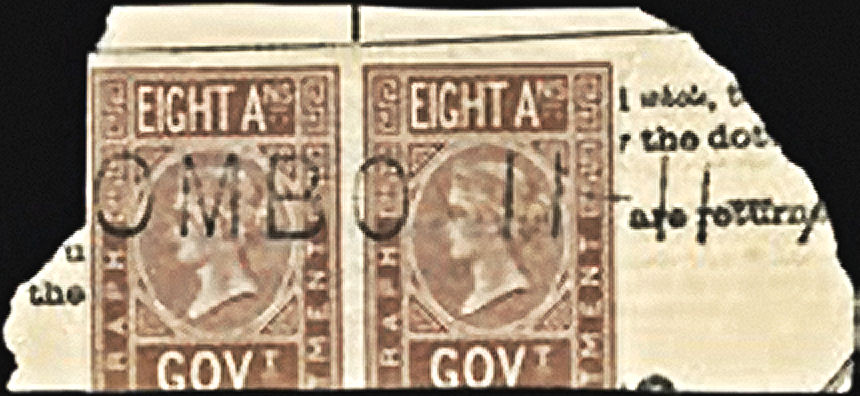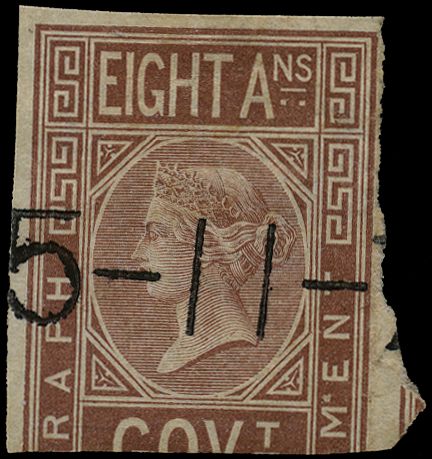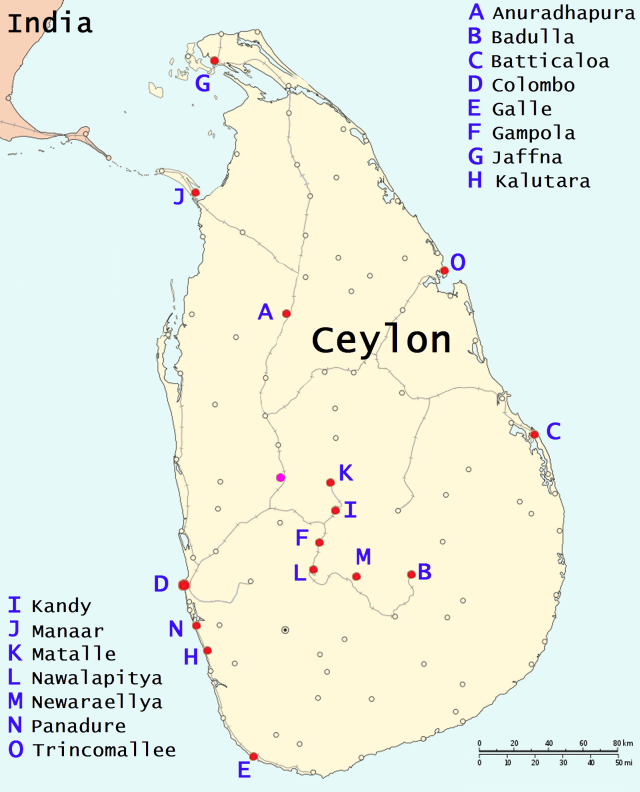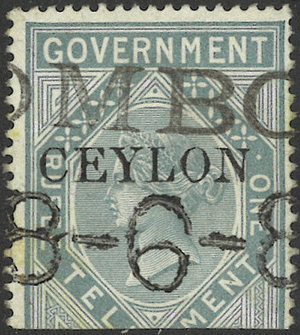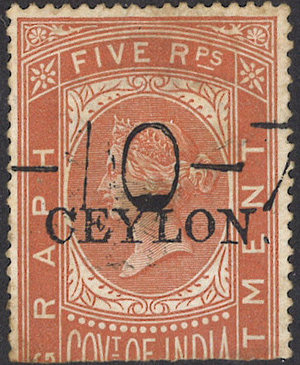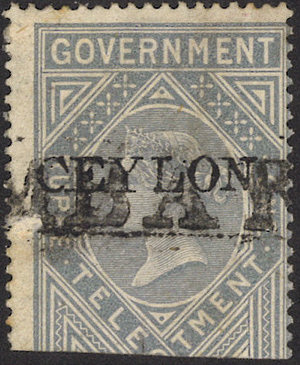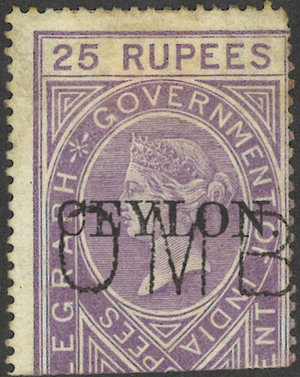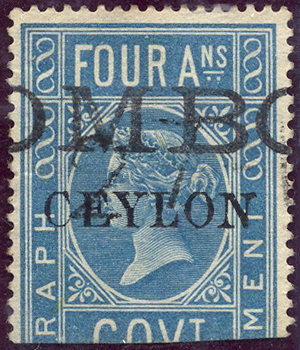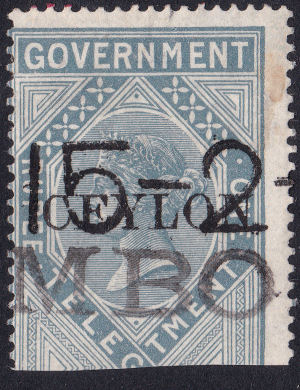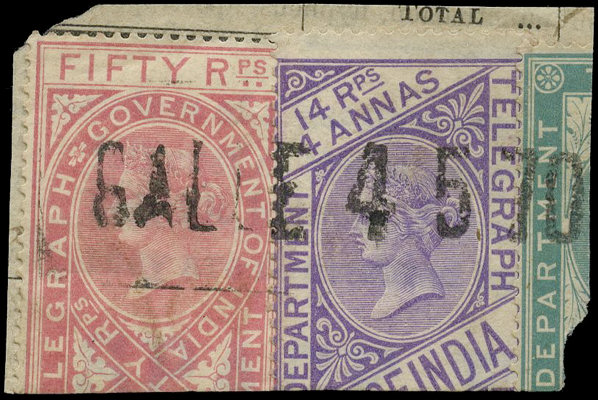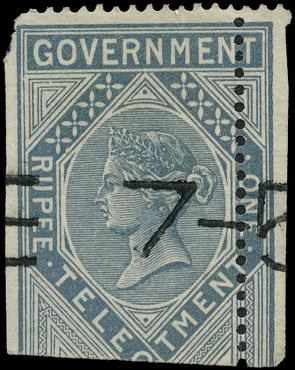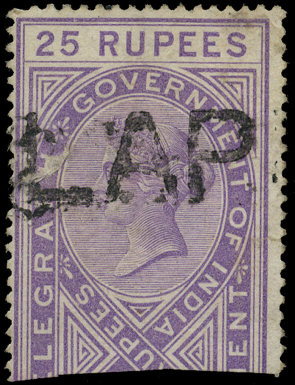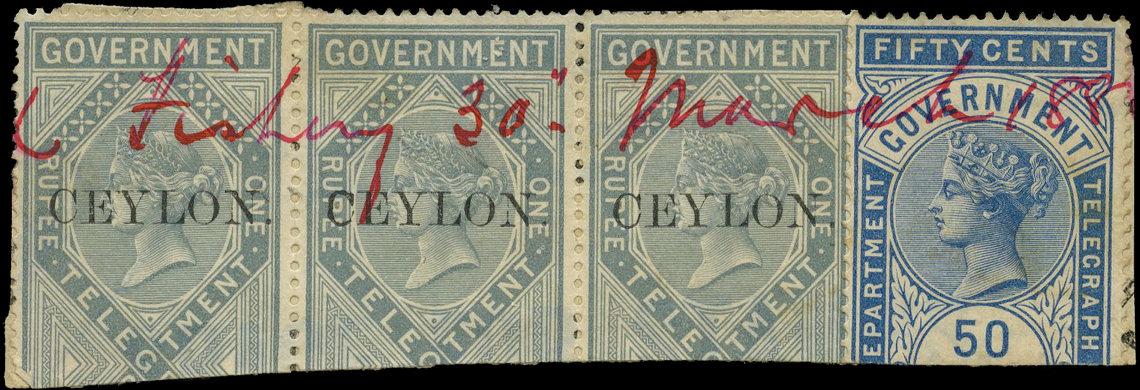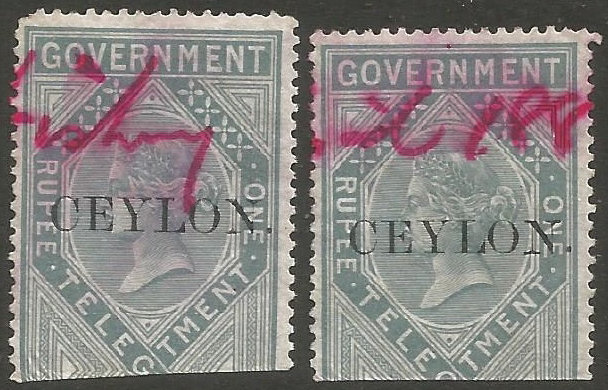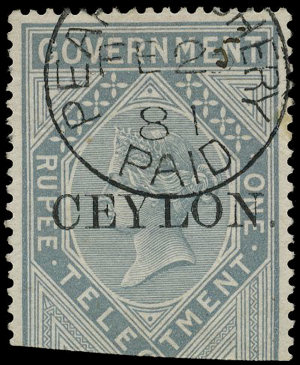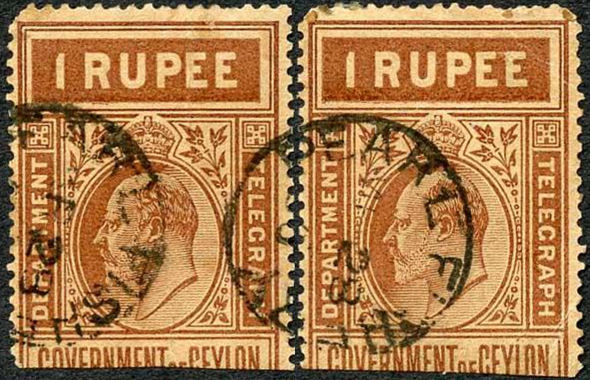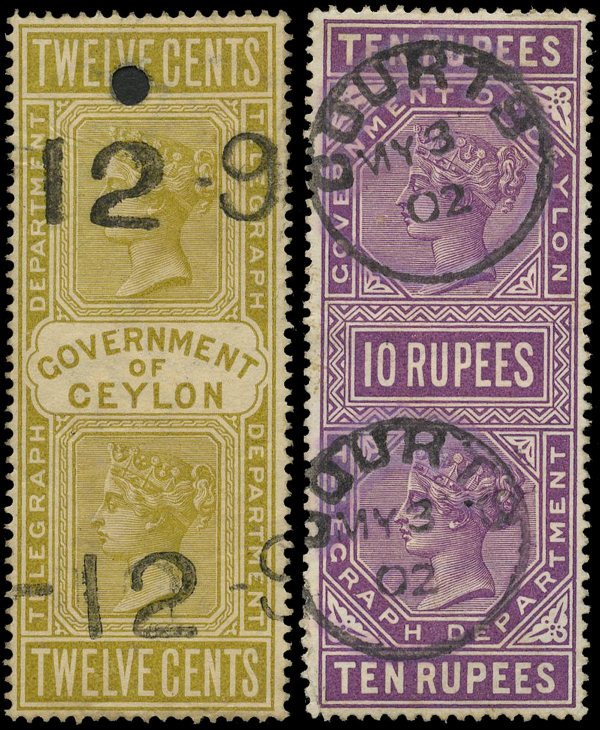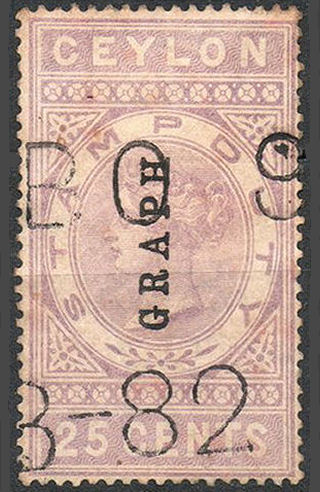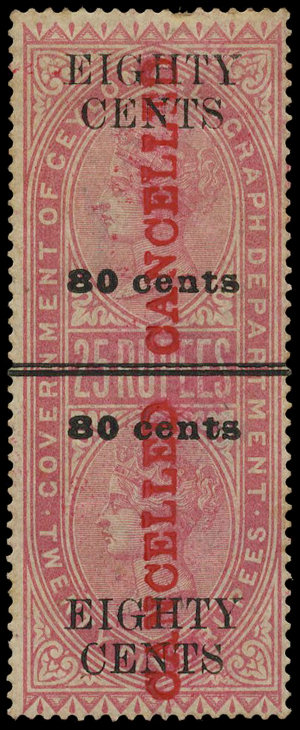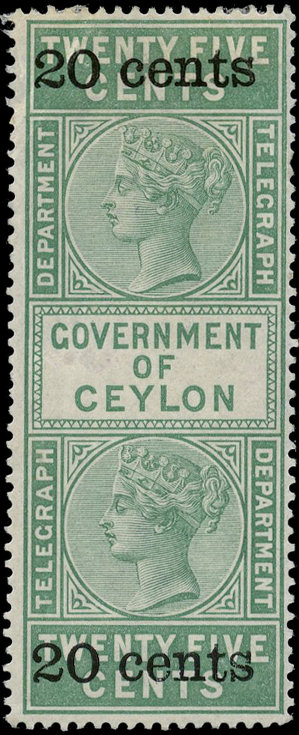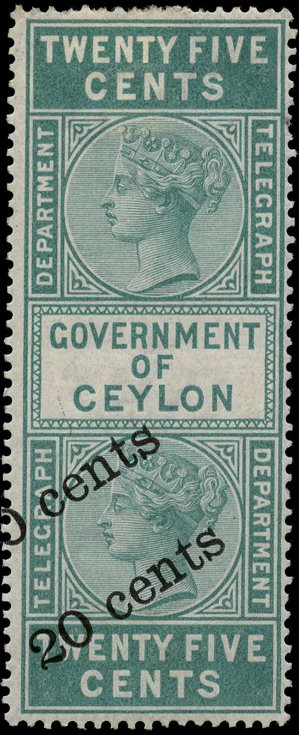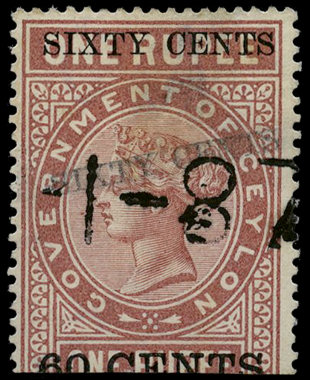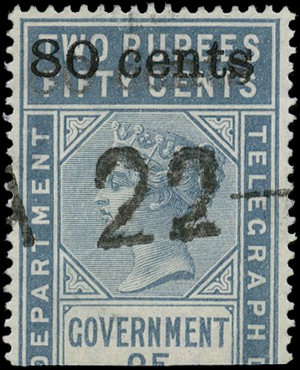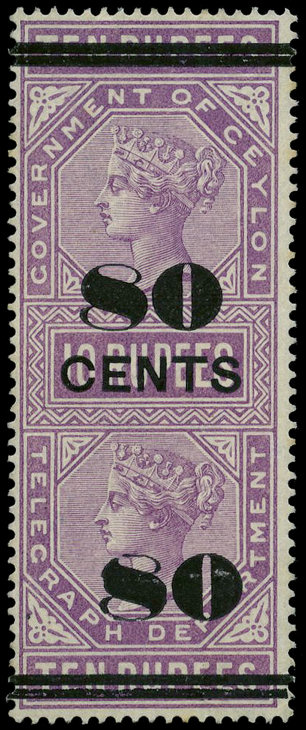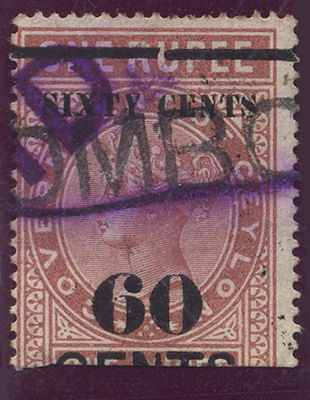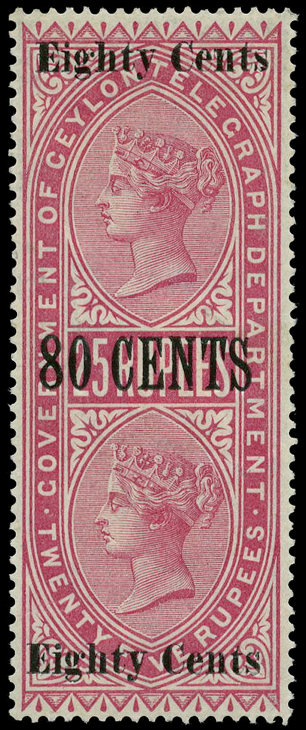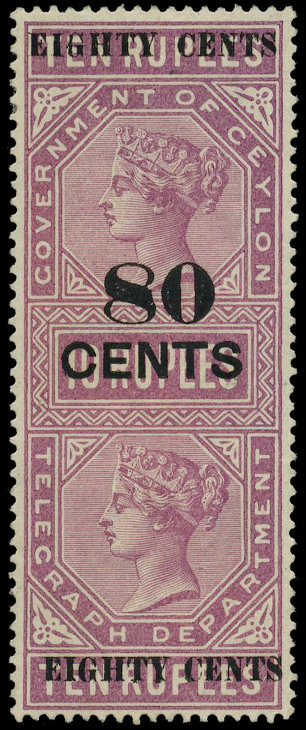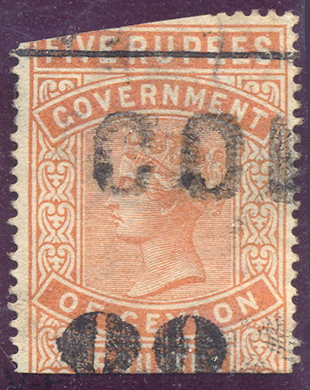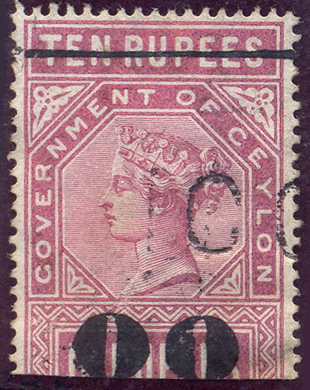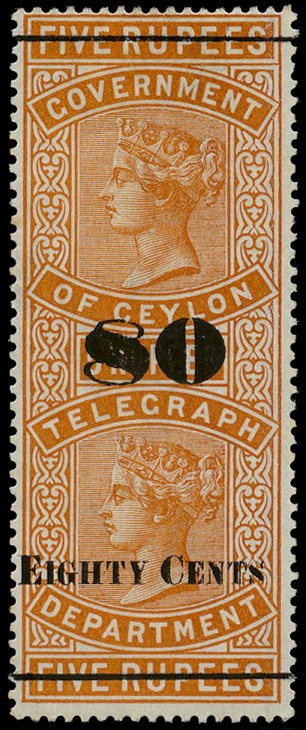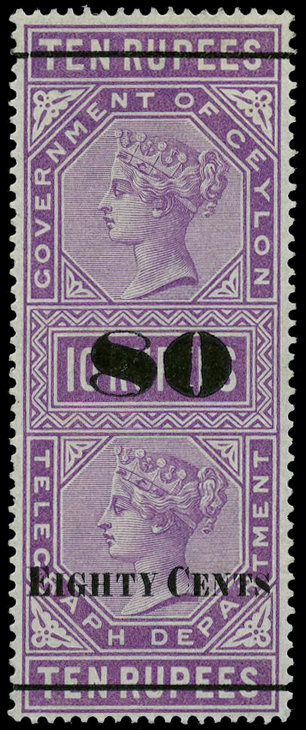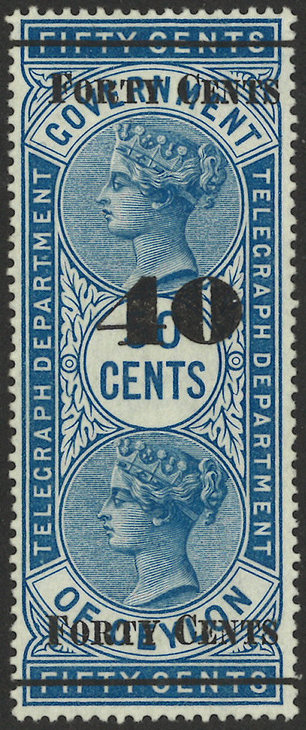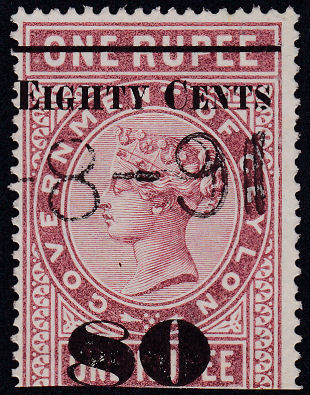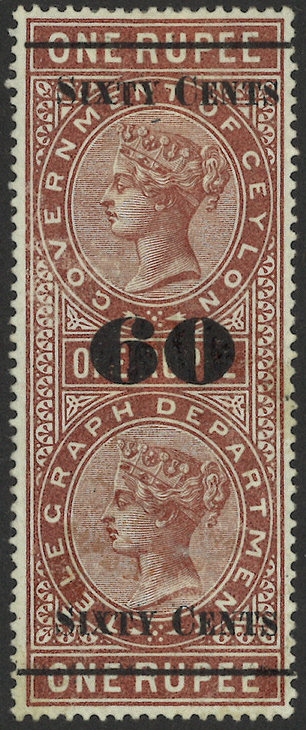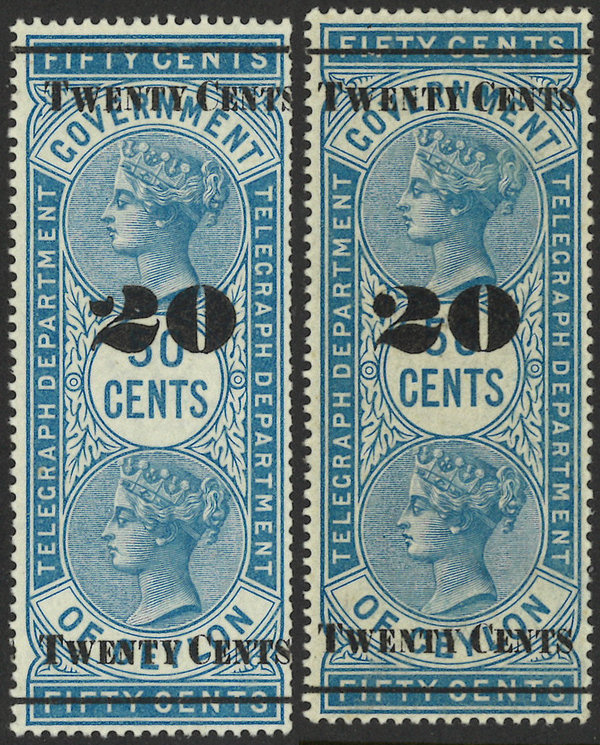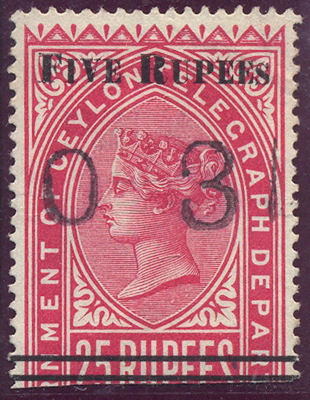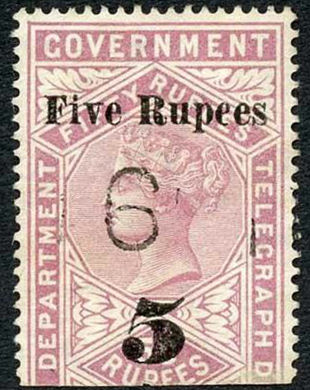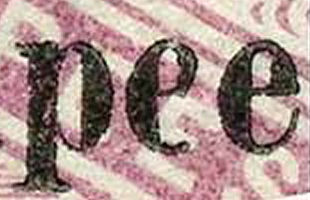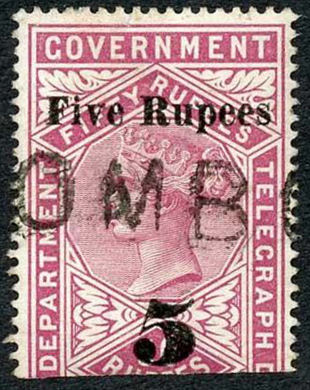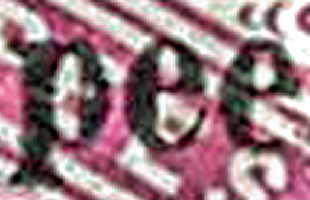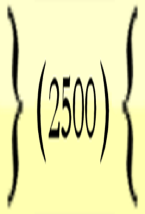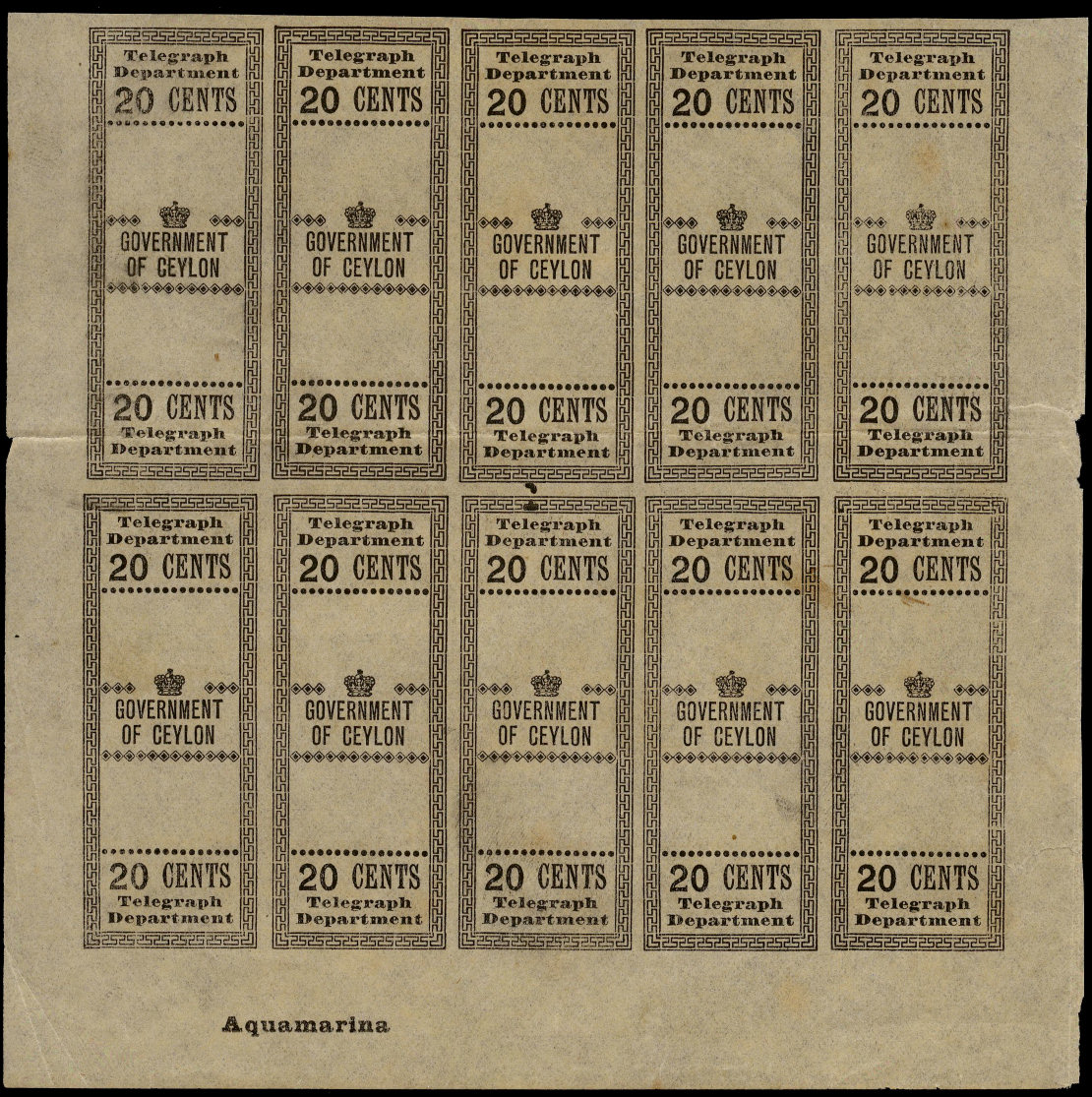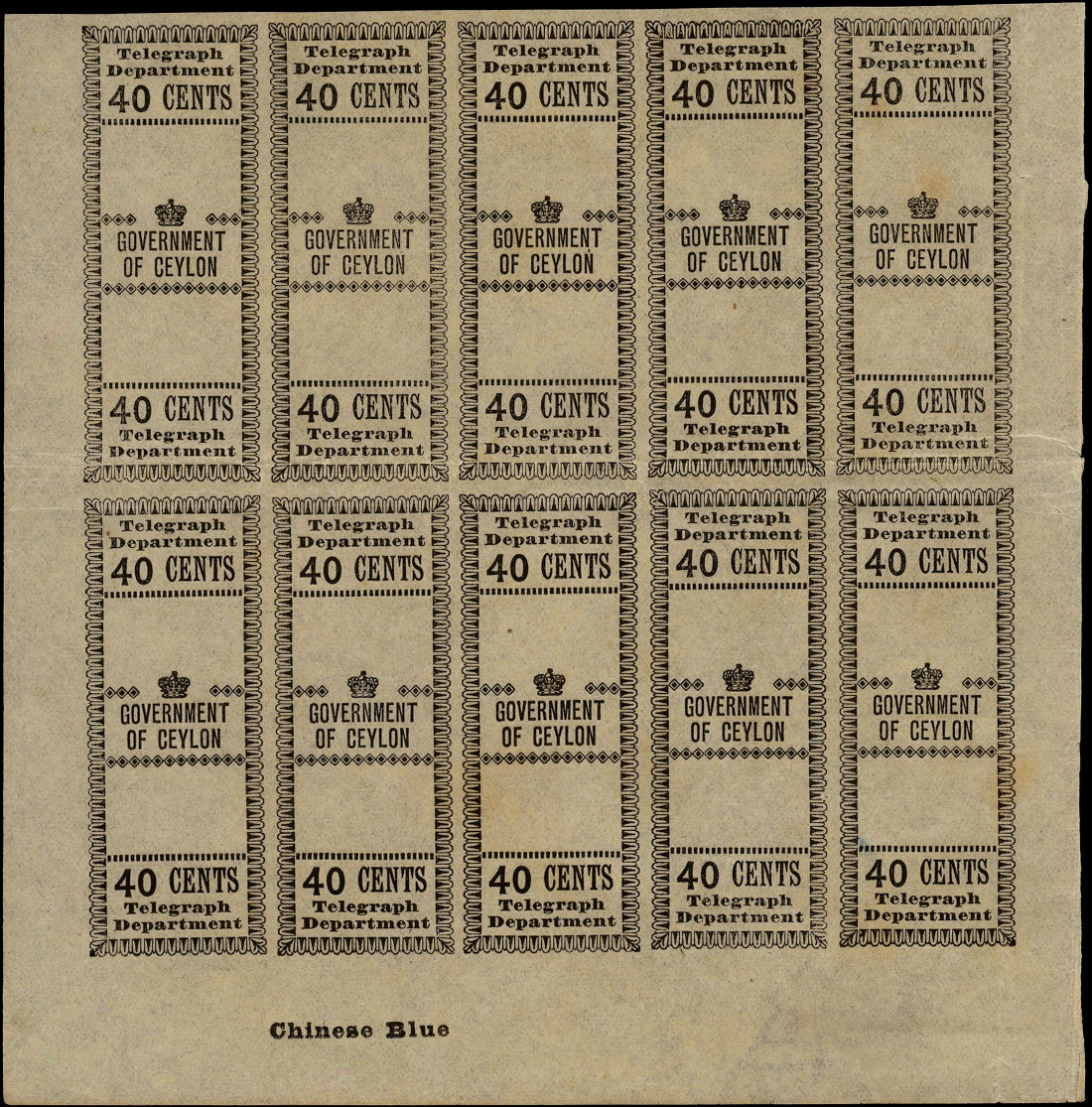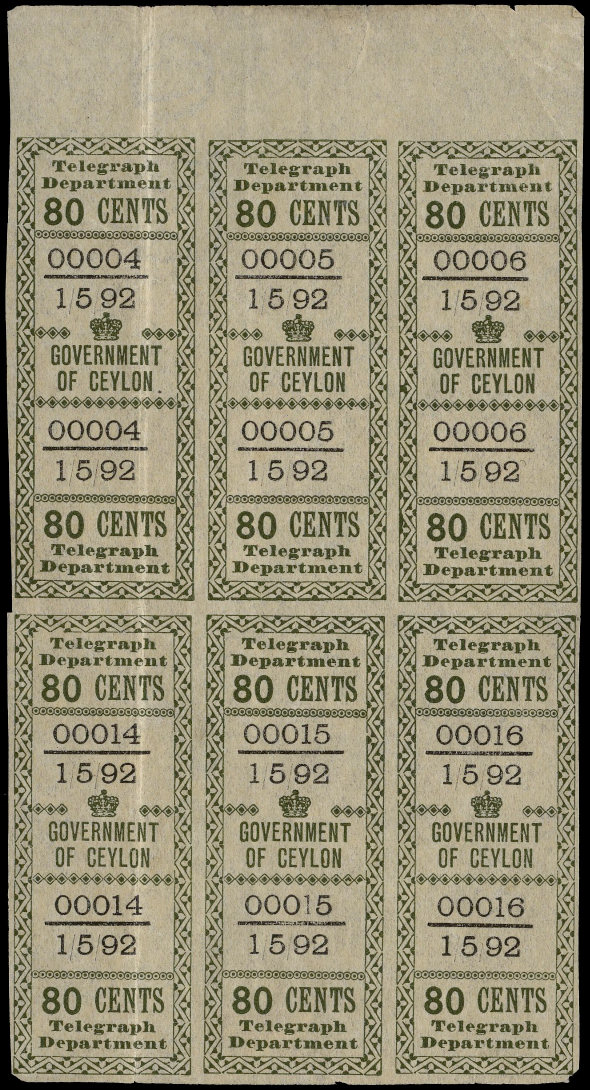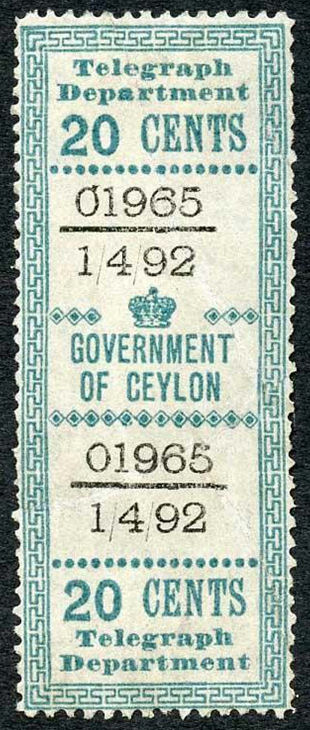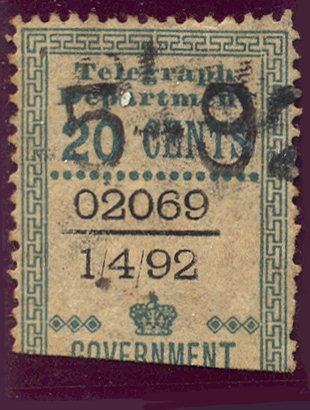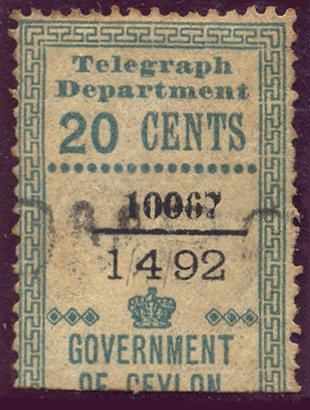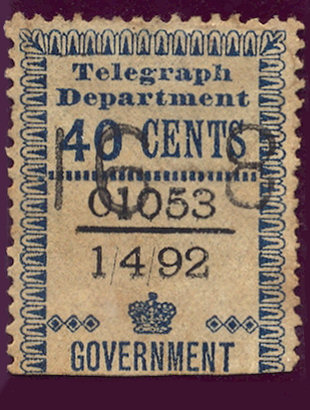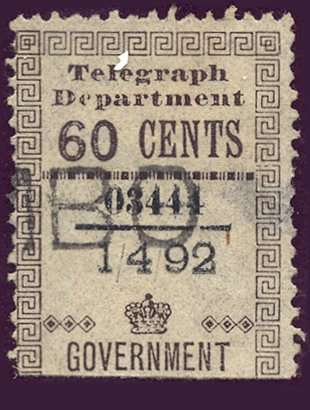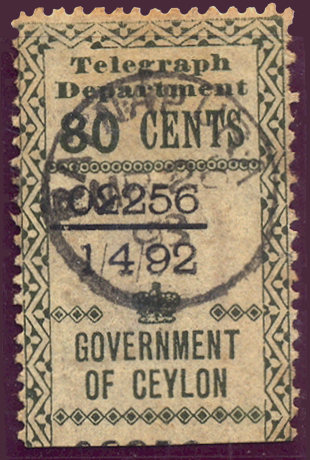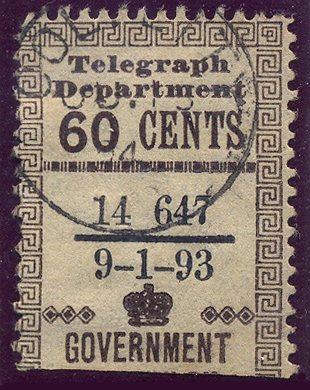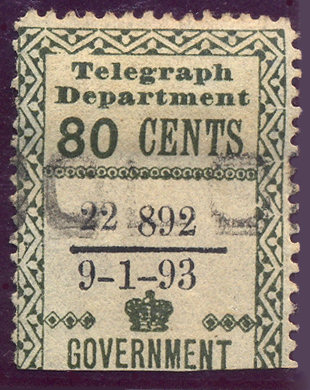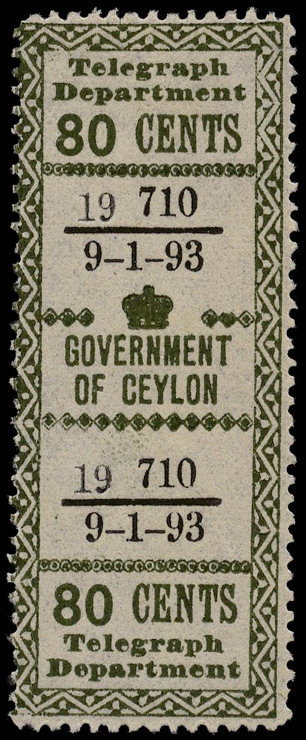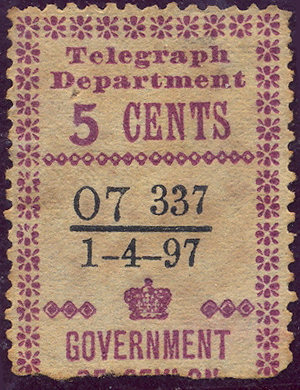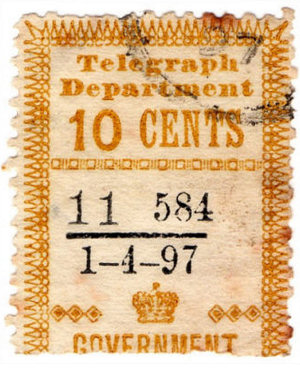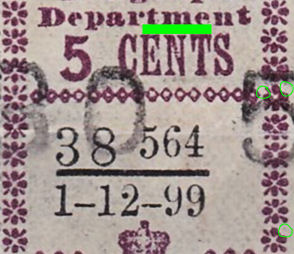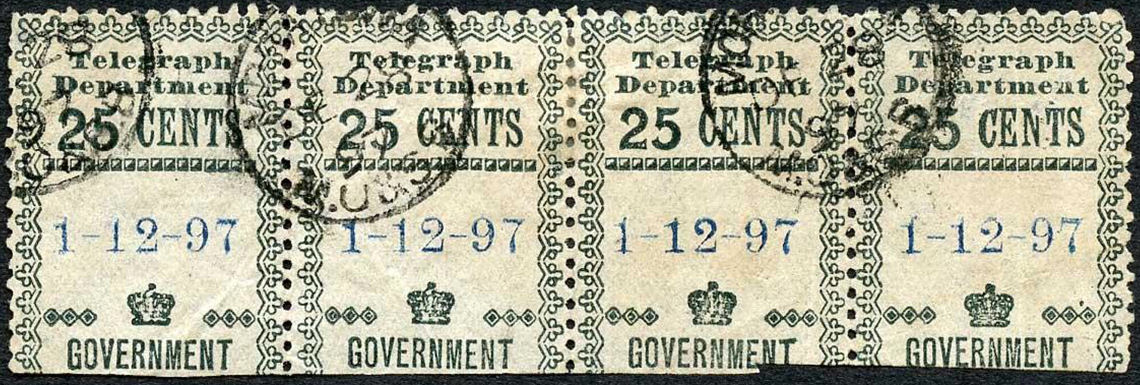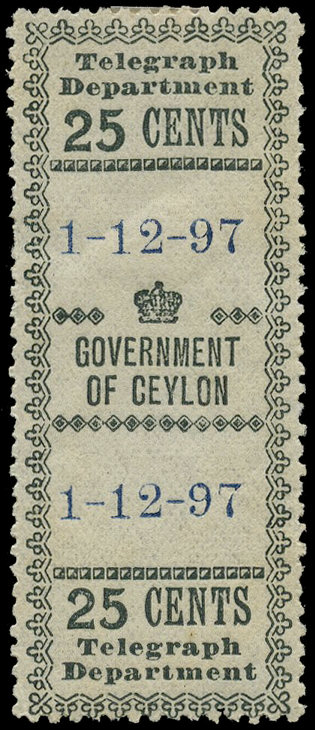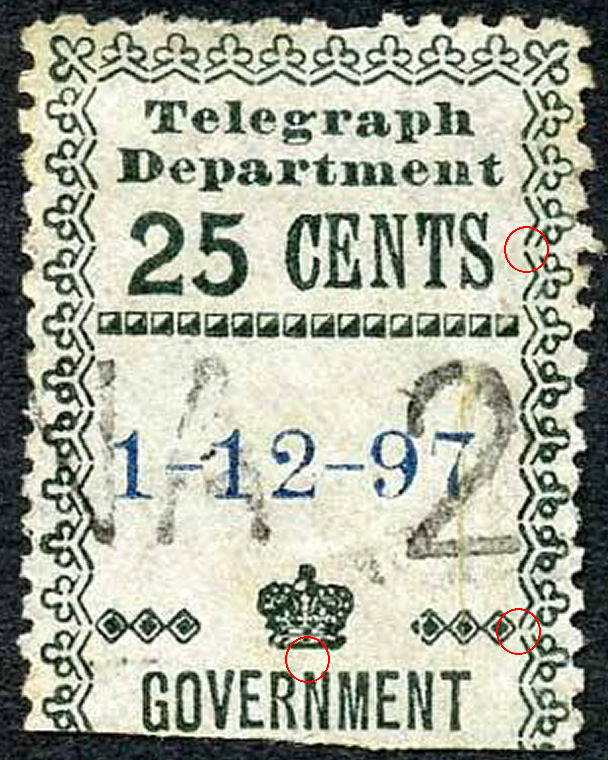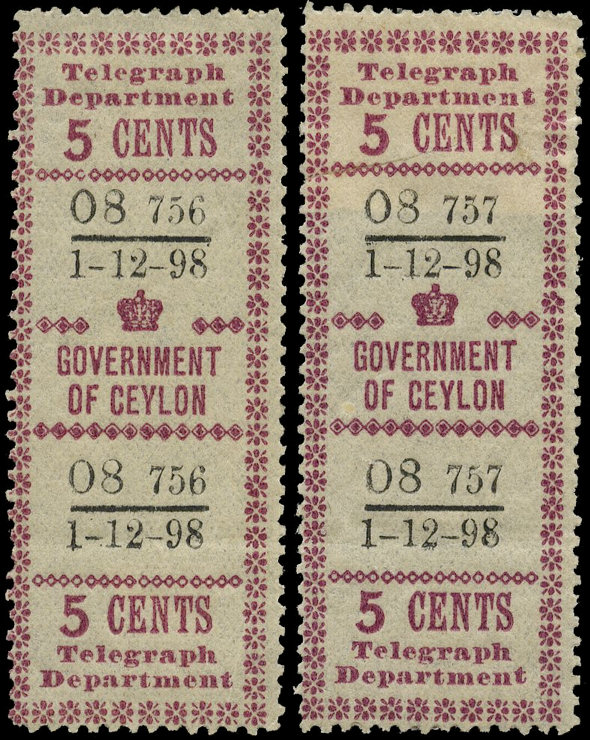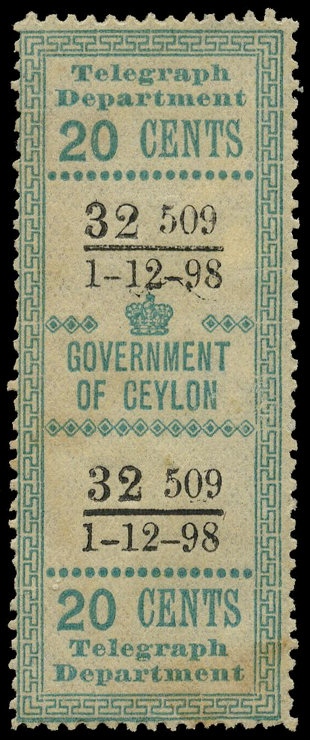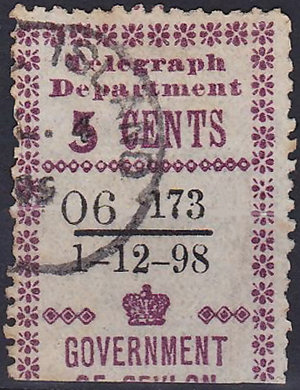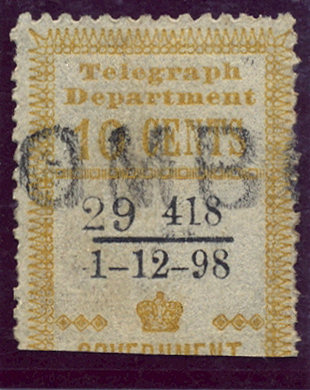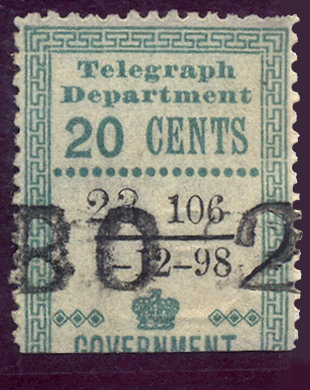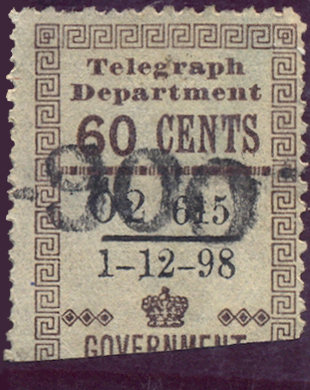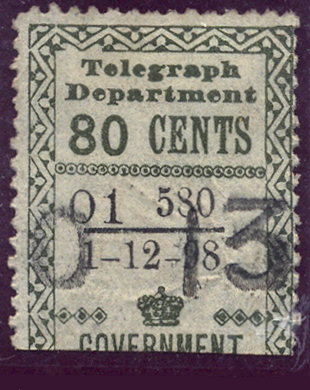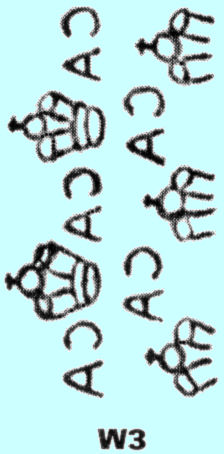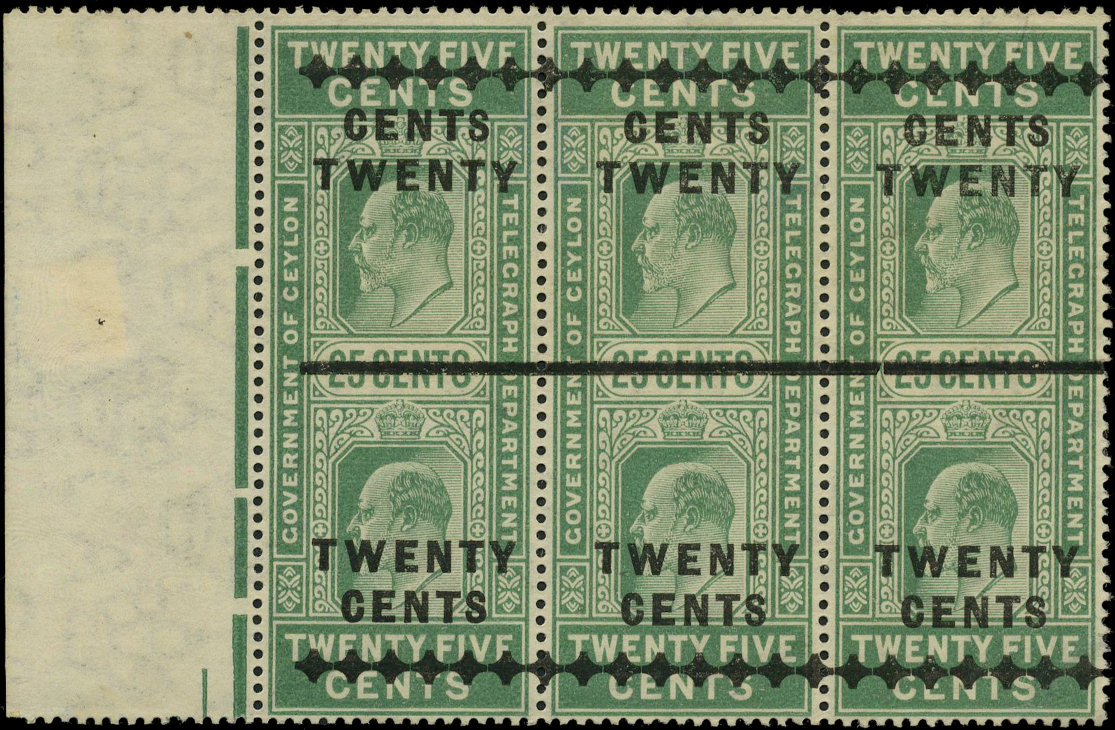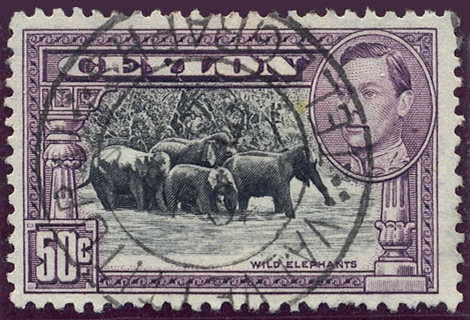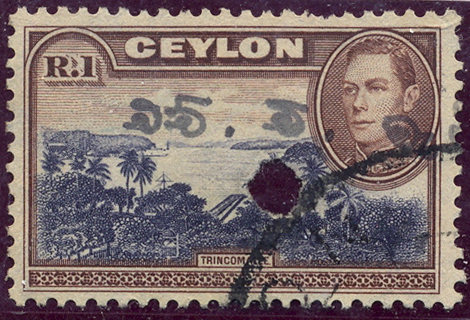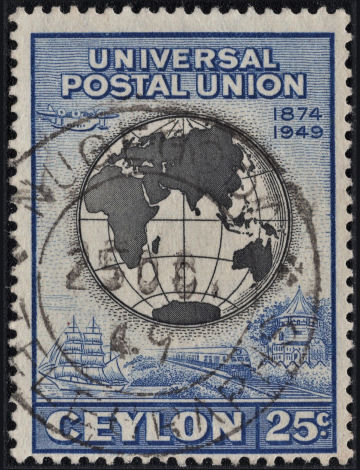| Up a level | Not my site, but a good reference: |
||||||
 |
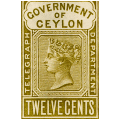 |
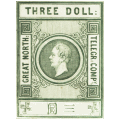 |
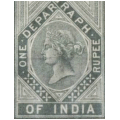 |
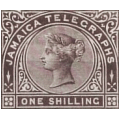 |
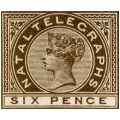 |
 |
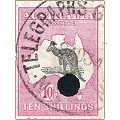 |
| GB | Ceylon | Hong Kong | India | Jamaica | Natal | OFS | Australia and states |
| Up a level | by Dave Elsmore. | ||||||
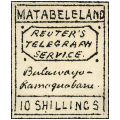 |
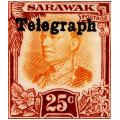 |
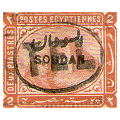 |
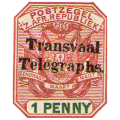 |
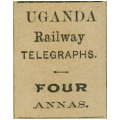 |
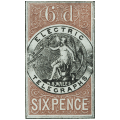 |
 |
 |
| Other Africa | Sarawak | Sudan | Transvaal | Uganda | New South Wales | Western Australia | Other Australia |
Ceylon
Steve Hiscocks wrote:
| The telegraph stamps of Ceylon form one of the most extensive and complex groups, and in attempting to produce a logical and orderly listing, I have leaned heavily on the superb scholarship of C. S. F. Crofton whose notes were posthumously published in the Philatelic Journal of India in 1910. The early status of the Ceylon Telegraph Department is not clear. It seems to have been effectively separate from that of India, but under the same superintendent as that of the Madras Presidency. In 1868 an international convention agreed a reduction on international tariffs which made the Ceylon system, which was largely dependent on international business, unviable. It therefore became part of the Indian system from late 1868 to 1880 when Ceylon resumed control of its own system. Throughout this period the normal Indian telegraph stamps were used (all of the earlier watermark) and in theory the Electric Telegraph stamps could also have been used although there is no evidence that they were. In 1880 Ceylon overprinted sufficient Indian stamps 'CEYLON' to tide them through until their own stamps, of similar type, arrived from England. The Queen Victoria double head issue continued with only a brief paper variation until 1894, when the watermark was changed and then until 1903 when a completely different King Edward VII set was introduced. This was produced on paper of a different watermark the following year, and this last set continued until separate telegraph stamps were abandoned on 1 August 1910. The overall picture however, is very much more complicated than the above. A new tariff introduced on 1 January 1882 caused a sudden demand for 20, 40, 60 and 80 cent values, and these were overprinted on other values. This state of affairs continued for 10 years with new settings of overprints for the same values being introduced once or twice each year until the Ceylon Government put its foot down, and a locally produced set of these values (each including its date of printing and with various sizes of control number) was introduced. Three further values were added to this provisional set to take care of a further tariff change, and order was finally restored with the introduction of the first King Edward VII set in 1903. There was a final set of provisionals introduced shortly before telegraph stamps were discontinued in 1910, but apparently never used. Cancellation of the earlier issues is almost always by roller stamps in black. Circular date stamps began to creep in about 1889 and are very common on the second King Edward VII issue. One special cancellation deserves mention and that is that of the Pearl Fishing grounds off northwest Ceylon. These are in manuscript and those I have seen (five) have been in the same hand, in red ink, on first and second issues (Ceylon on India and first Ceylon proper) and read "Pearl Fishing [date] 1881", where the date is in April or May. On piece they command a considerable premium. For a week or so in July 1898 there was a shortage of certain values in Colombo and the use of postage stamps was apparently authorized. These were bisected in use as were telegraph stamps and, used on piece with Telegraph stamps and properly tied, are very rare. The postage stamps I have seen thus used appear to be the 2c dull green (SG 147) and the 3c terracotta (and blue green, although that part is removed) (SG 245). |
My notes:
I can now show examples of these, in the Cancels section.
Examples of these really needs illustration. A scan would be much appreciated.
The first cable from India to Ceylon was laid in 1858, with another following in 1867.
Stamps of India used in Ceylon
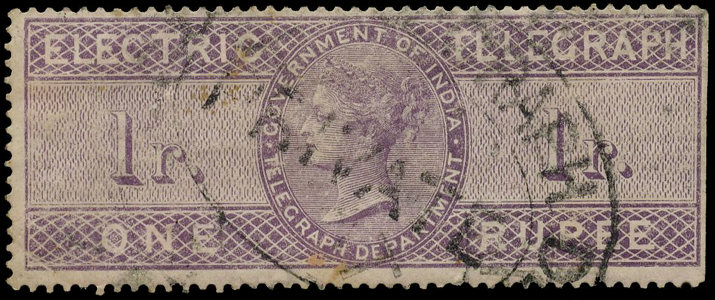 |
| India H2 from lot 1 of the listing of the Taprobana Collection Auction, courtesy of Stanley Gibbons. |
The oval cancel reads "CEYLON TELEGRAPH DEPARTMENT/PRIVATE". According to Stanley Gibbons "no example known used in India. The three recorded are all used in Ceylon".
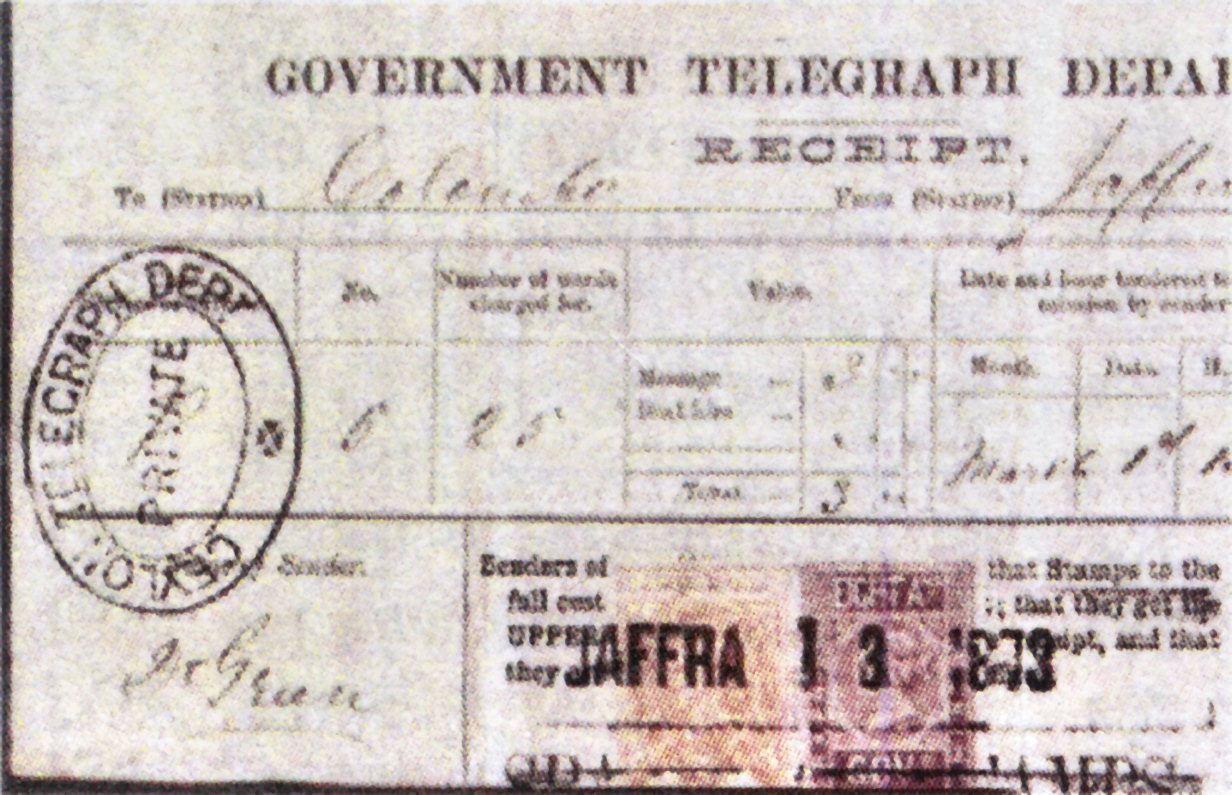
Part of a receipt used at Jaffna (with Jaffra in error) on 1 March 1873, showing a clearer image of this hand-stamp, courtesy of jbarefoot.co.uk.
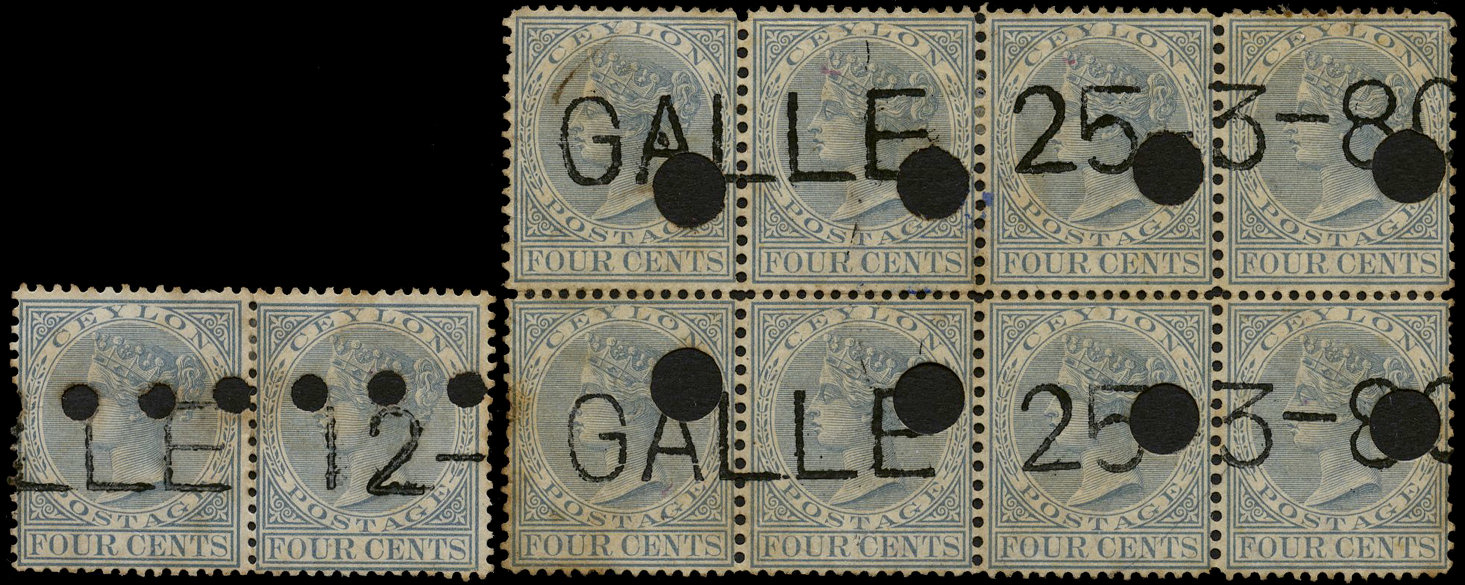
Lot 37 of the listing of the Taprobana Collection Auction, courtesy of Stanley Gibbons, who say of this :
"1872-80 4ct grey watermark Crown CC, perf 14, horizontal pair each with three small punched holes of the Telegraph Check Office cancelled '(GA)LLE 12-' ; together with
perf 14 x 12½ block of eight (4 x 2), each with larger Check Office punched holes and with two complete 'GALLE 25-3-80' cancels. Very rare usage. SG 122, 134.
This rare block represents the earliest known use of Ceylon postage stamps for telegraphic purposes, at a time when Indian telegraph stamps (denominated in annas and rupees) were current."
1869-1880 Telegraph stamps of India used in Ceylon. Watermark W1 of India. Perf. 14
(Numbers in brackets refer to the Indian reference numbers.)

A selection of Indian stamps used in Ceylon, courtesy of Socrates Antypas (storypost) on ebay.
'CEYLON' overprint
1880 (1 July) 'CEYLON' overprint on Indian Telegraph stamps as above. Watermark W1 of India. Perf. 14
India Nos. and quantity in brackets.
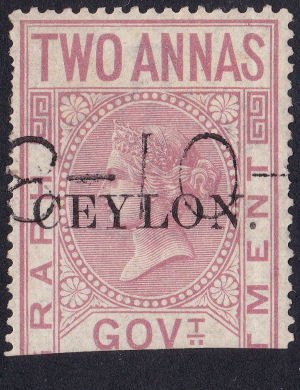 |
 |
 |
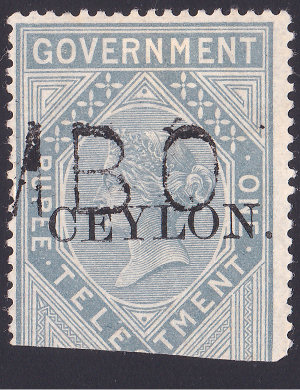 |
| 2 As. H18 | 4 As. H19 | 8 As. H20 | 1 Rp. H21 |
 |
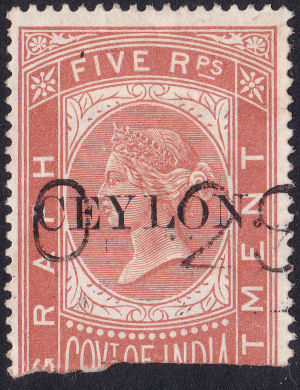 |
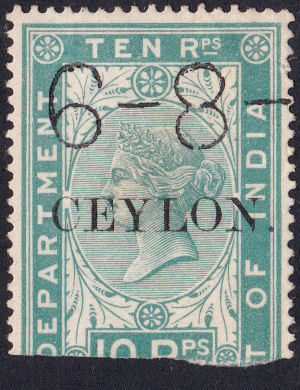 |
| 2 Rps.8As. H22 | 5 Rps. H23 | 10 Rps. H24 |
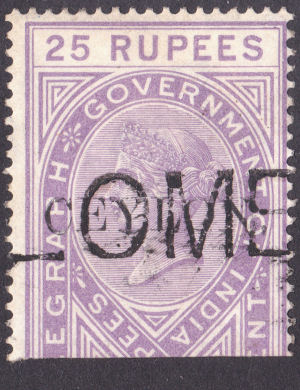 |
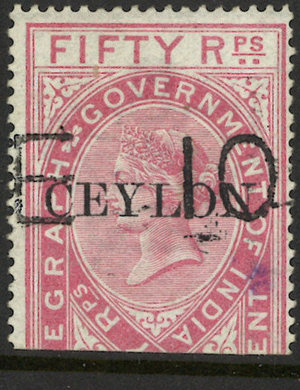 |
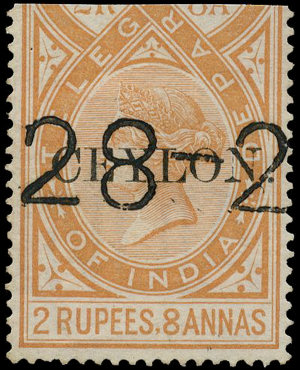 |
| 25 Rps. H25 | 50 Rps. H26 Courtesy of Wimal Suaris |
2 Rps.8As. H22 bottom half - Lot 42 of the Taprobana Collection Auction, Courtesy of Stanley Gibbons. |
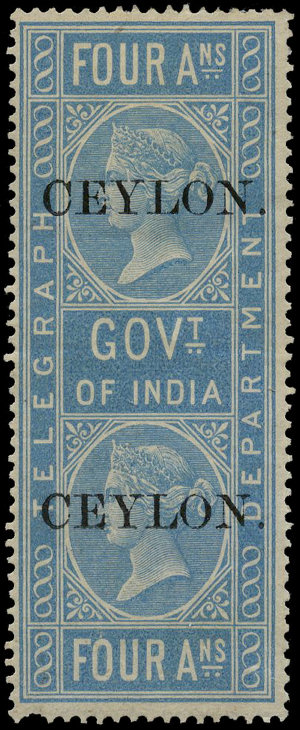 |
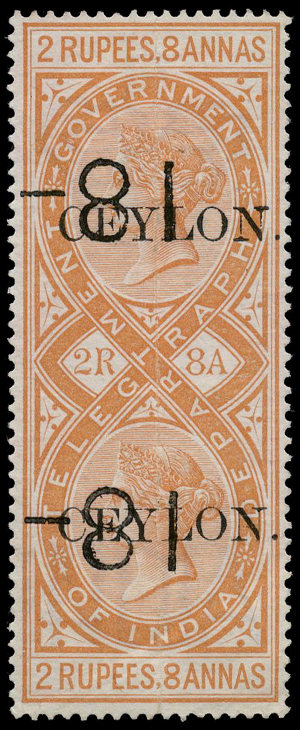 |
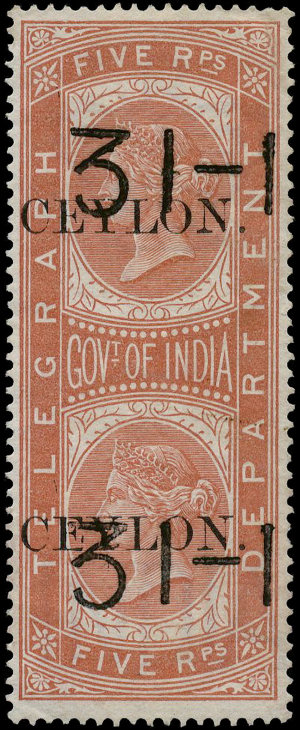 |
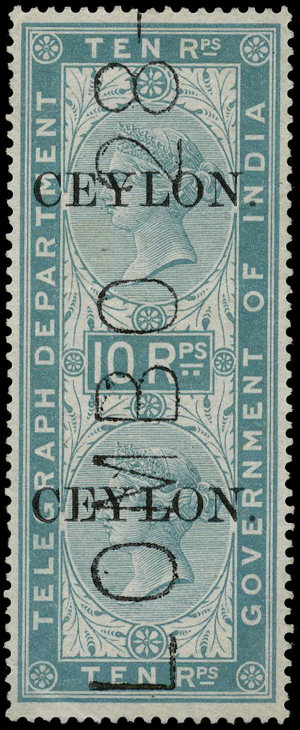 |
 |
| Lot 36, 4As. Mint H19 | Lot 41, 2Rp 8As. Used H22 | Lot 43, 5Rp. Used H23 | Lot 44, 10Rp. Used H24 | Lot 45, 25Rp. Used H25 |
| Images from listings of the Taprobana Collection Auction, courtesy of Stanley Gibbons. | ||||
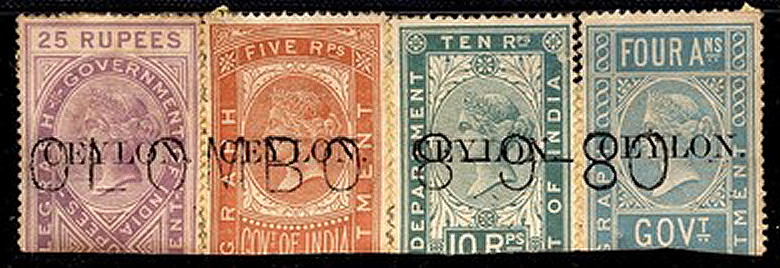 |
| This strip shows the typical cancel used, with location followed by date. |
| Image courtesy of Socrates Antypas (storypost) on ebay. |
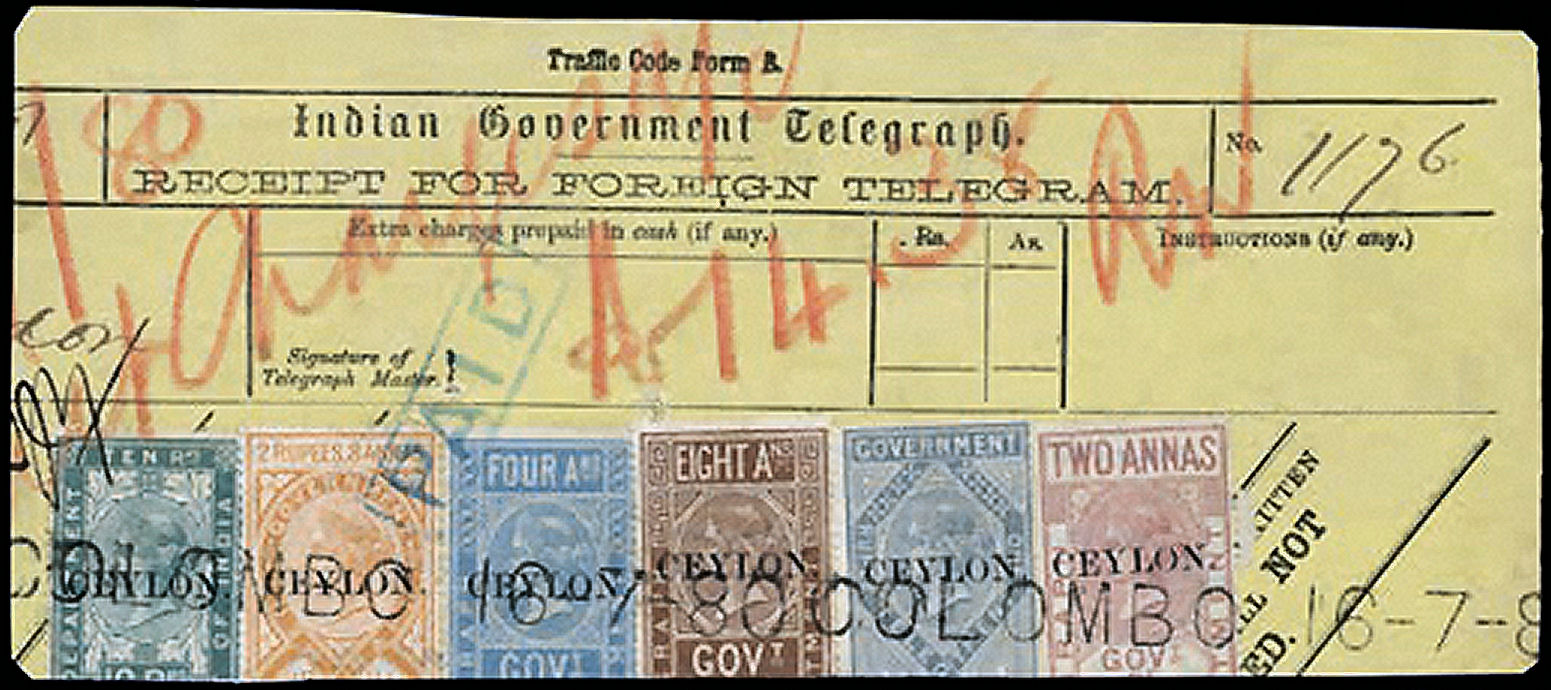
Lot 142 of the Indica Collection Auction (28 September 2021), courtesy of Stanley Gibbons.
This shows 6 different values, used in Colombo.
| Hisc. | Description | Mint | Used |
|---|---|---|---|
| H18 | 2A maroon (H5, 2000) | - | 30.00 |
| H19 | 4A blue (H6, 2450) | - | 24.00 |
| H20 | 8A brown (H7, 20000) | - | 12.00 |
| H21 | 1R grey (H9, Die II, 35000) | - | 10.00 |
| H22 | 2R 8A orange (H11, Die II, 6000) | - | 20.00 |
| H23 | 5R brown-orange (H12, 2000) | - | 30.00 |
| H24 | 10R green (H14, Die II, 3250) | - | 20.00 |
| H25 | 25R violet (H17, Die II, 2450) | - | 35.00 |
| H26 | 50R rose-carmine (H20, Die II, 100) | - | 200.00 |
Hiscocks added the following 3 notes:
| Note 1. These stamps are virtually unknown mint, although copies of the 4A and 25R (Nos. 19 & 25), are in the Royal Collection. A few lower halves (also overprinted) are known (Price x 4) and a 2½R (No. 22) is known used whole. |
| Note 2. Beware of forgeries — especially of No 26. |
| Note 3. Those on piece command a premium. |
Forgeries
Note 2 looks like good advice
But how exactly do you do that?
The first thing is that These should not have a cancel of India. Also it should not be on Die I.
If it is cancelled in Bombay, it is not a stamp of Ceylon !
However, it does point to the overprint being forged, and it becomes possible to recognise some of the forgeries.
Wimal Suaris, who was in contact with Steve Hiscocks, has spent time on this. He has identified 5 types of counterfeit overprints.
In his own words, with his own illustrations:
There are likely to be others. If you have a stamp with this overprint that was not used in Ceylon,
and the overprint does not match any of these, then please send me a scan so that the characteristics of other forgeries can be added to the list.
Cancels
| Shortcuts to different town cancels | |||||||||||||||
| Anuradhapura | Badulla | Batticaloa | Colombo | Galle | Gampola | Jaffna | Kalutara | Kandy | Manaar | Matalle | Nawalapitya | Newaraellya | Panadure | Trincomalee | Pearl Fishery |
Up to this point, a knowledge of the cancels used is quite important since it is important to know if the stamps were used in Ceylon and that the cancel is genuine.
Colombo
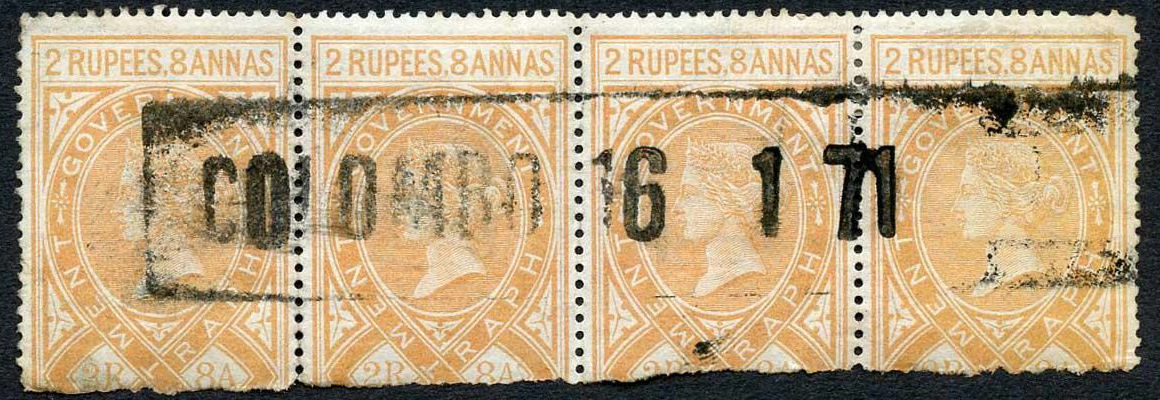
Boxed version dated 16 January 1871, courtesy of Mark Bloxham.

Unboxed version dated 3 April 1872, courtesy of Wimal Suaris.
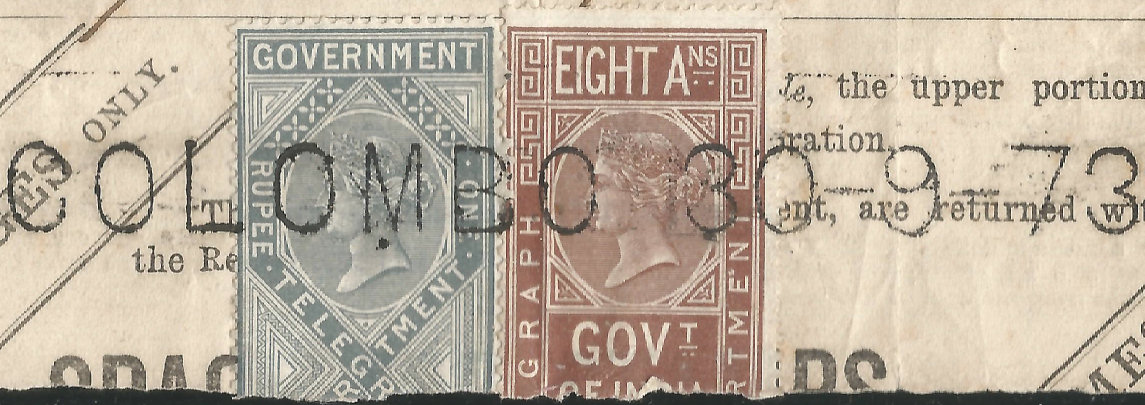
Large, thin, widely-spaced lettering dated 30 September 1873 courtesy of Wimal Suaris.
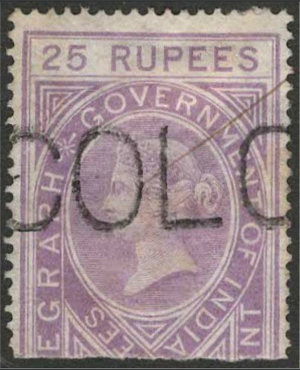
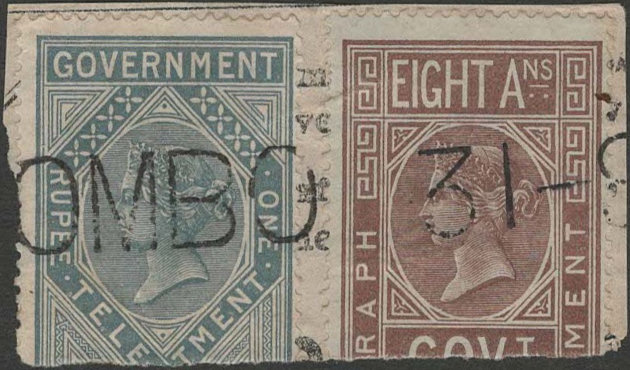
Similar to last, but letters more closely spaced. Date unknown. Images courtesy of Wimal Suaris.
Colombo will figure prominently. The normal stamps of India were used in Ceylon from 1869 to 1880 and should be dated accordingly.
Most towns appear to have two types, a narrow-thick type and wide thin type. Colombo had two different heights of the thin type.
The ones with the 'CEYLON' overprint were only used from 1 July 1880 until the 1881 issue was available, on or shortly after 14 February.
Later cancels are very different.
This strip has control numbers that indicate the position in the pane with the last 2 digits. This has an 1899 cancel. image courtesy of Mark Bloxham.
Apart from Colombo, 14 other towns were initially issued with Telegraph stamps.
Anuradhapura
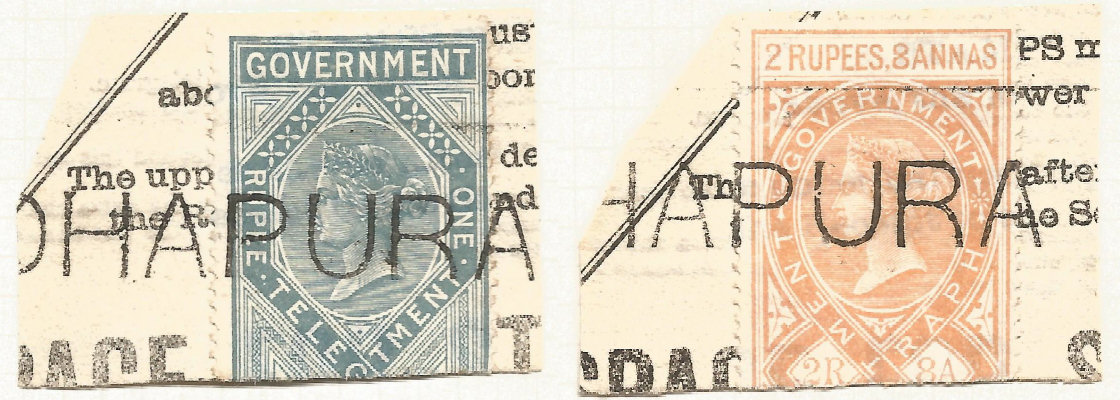
Images courtesy of Wimal Suaris.
Badulla

Images courtesy of Wimal Suaris.
Batticaloa
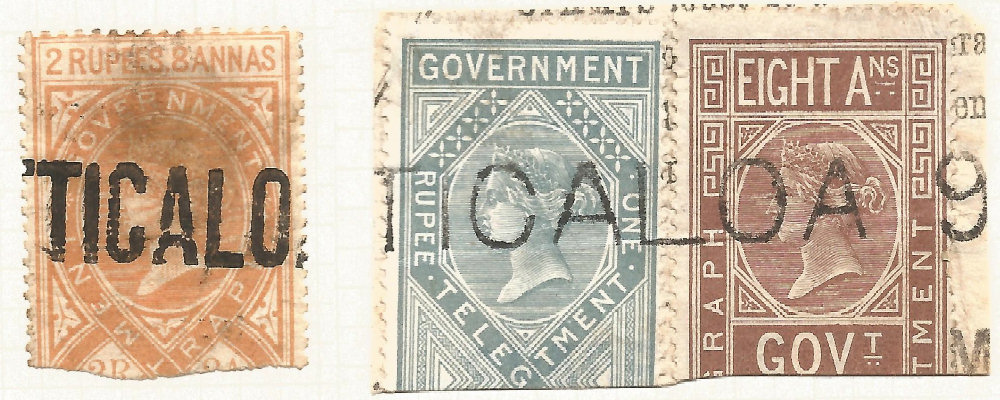
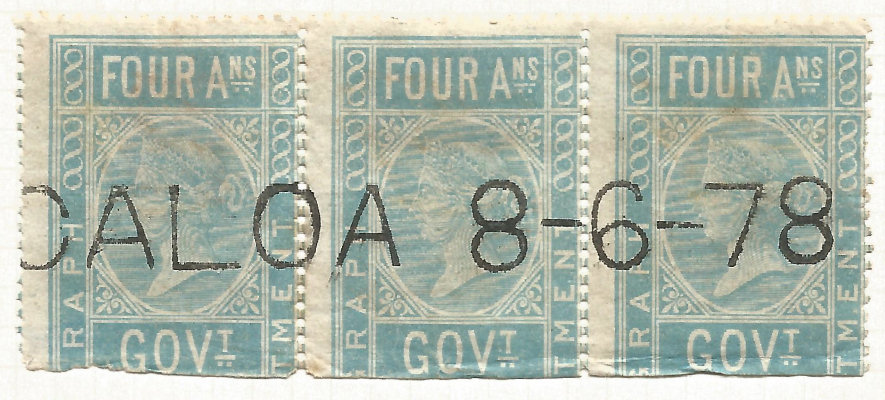
Images courtesy of Wimal Suaris.
Galle
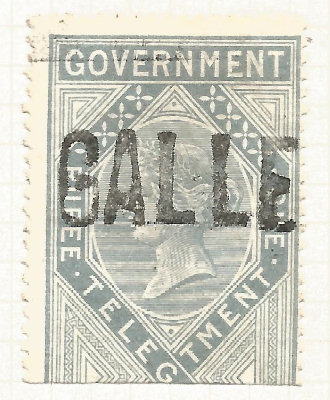
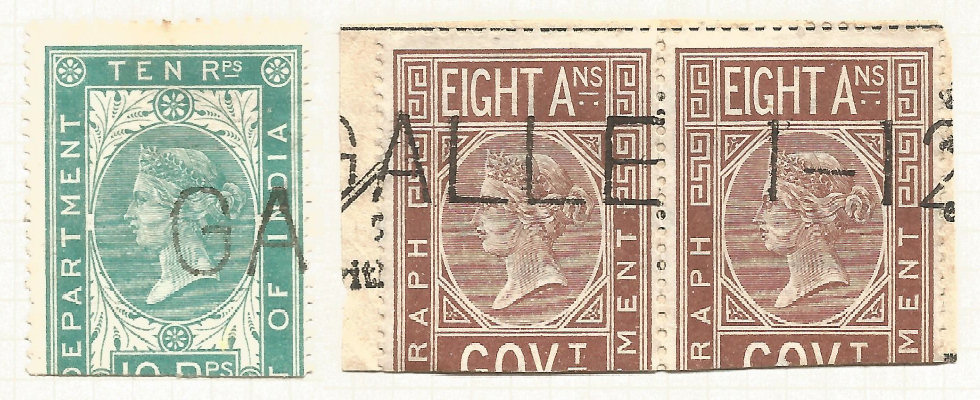
Images courtesy of Wimal Suaris.
It may be worth mentioning here a note that Hiscocks added under New South Wales:
| Note 7. An interesting correspondence in the records of the India Office in London implies that up to 1869 or 1870 telegrams from New South Wales to Europe were transported by ship to Ceylon and sent from there (Galle) by the land route through India. In February 1869, 500 Rupees worth of Indian telegraph stamps were sent to Sidney so that such telegrams could be pre-paid before shipment. It is not known whether they were cancelled in Sidney before shipment or only in Galle on dispatch. Whether the receipts were returned to Sidney as evidence of dispatch is also not known. It is interesting to note that the stamps in question were the first Indian double headed issue which were due to be issued in Ceylon on 1 February 1869. Due to administrative confusion these were not in fact issued in Ceylon until around 1 July 1869 so they may have been used in New South Wales and have reached Galle in Ceylon before being issued in Ceylon itself. Any Galle cancelled Indian telegraph stamps dated before July 1869 would probably have been used in New South Wales but none has been reported. |
Gampola
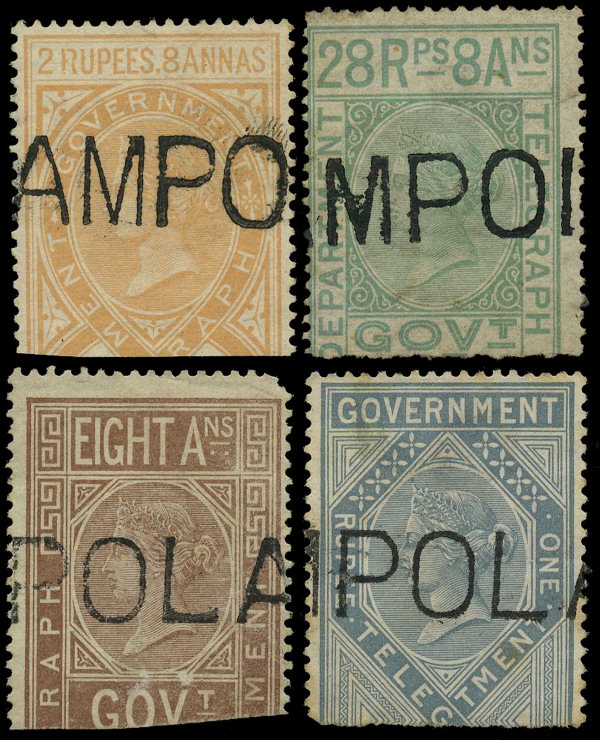
Lot 25 of the listing of the Taprobana Collection Auction, courtesy of Stanley Gibbons.
Jaffna

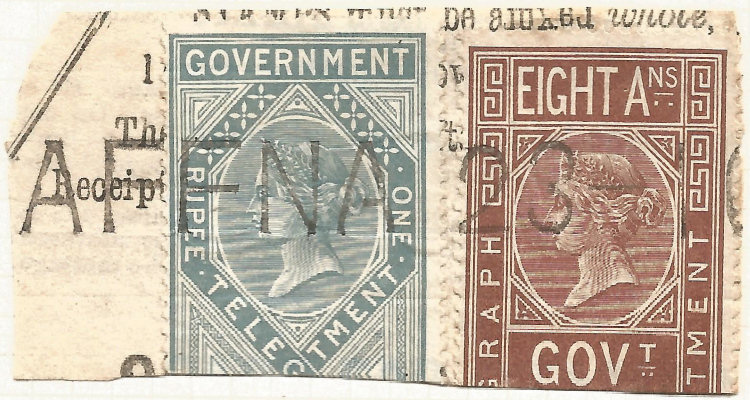
Images courtesy of Wimal Suaris.
Jaffra - in error for Jaffna

Images courtesy of Mark Bloxham.
Kalutara
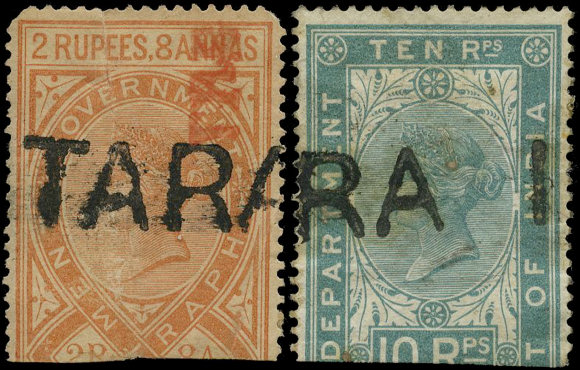
Lot 28 of the listing of the Taprobana Collection Auction, courtesy of Stanley Gibbons.
Kandy
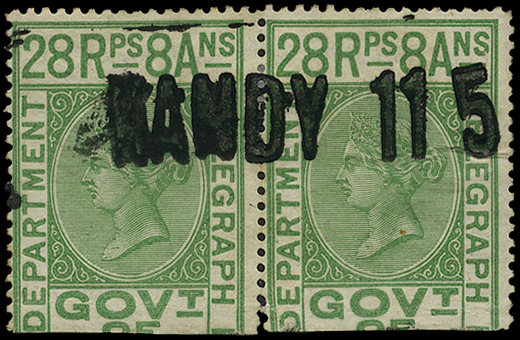
Lot 29 of the listing of the Taprobana Collection Auction, courtesy of SStanley Gibbons.
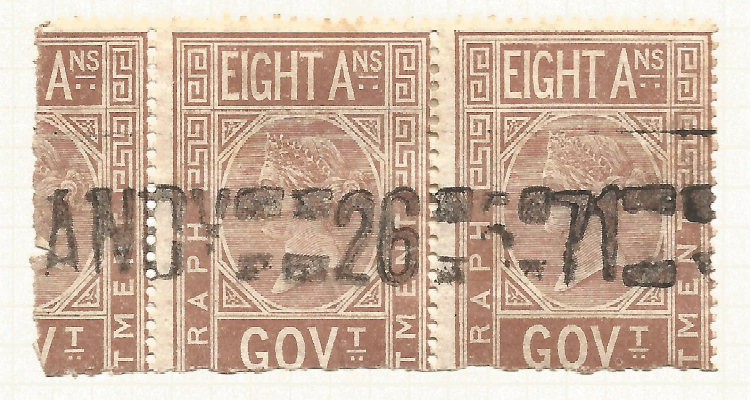

Images courtesy of Wimal Suaris.
Manaar

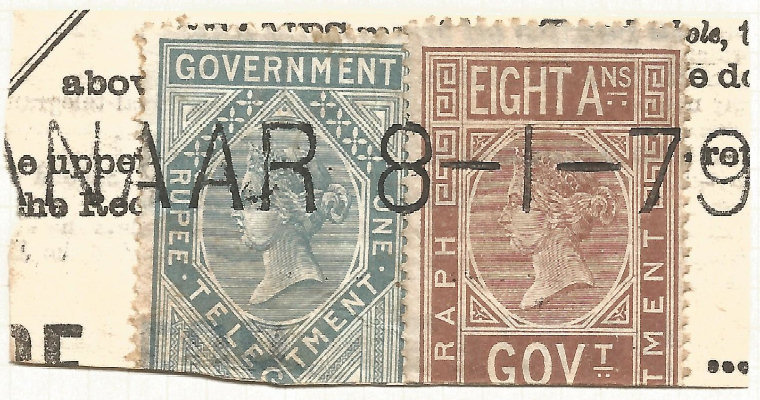
Narrow-thick type on a die I and wide-thin type on die II. This neatly illustrates the chronological order of them.
Images courtesy of Wimal Suaris.
Matalle / Matalli
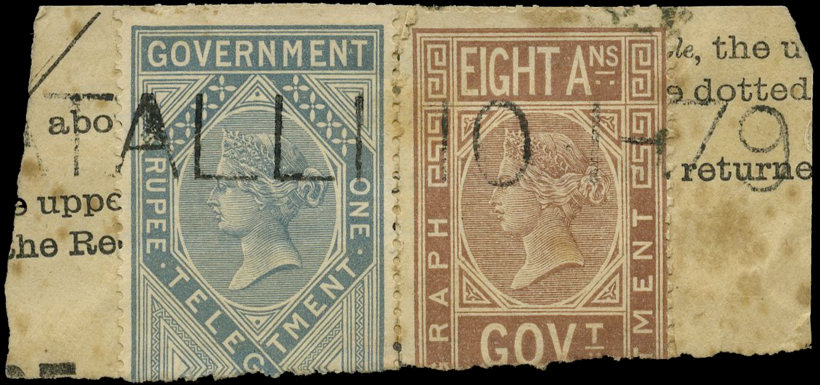
Lot 32 of the listing of the Taprobana Collection Auction, courtesy of Stanley Gibbons.
"The proving piece for this unrecorded spelling"
Nawalapitya
More images are needed for this if anyone can help.
Newaraellya
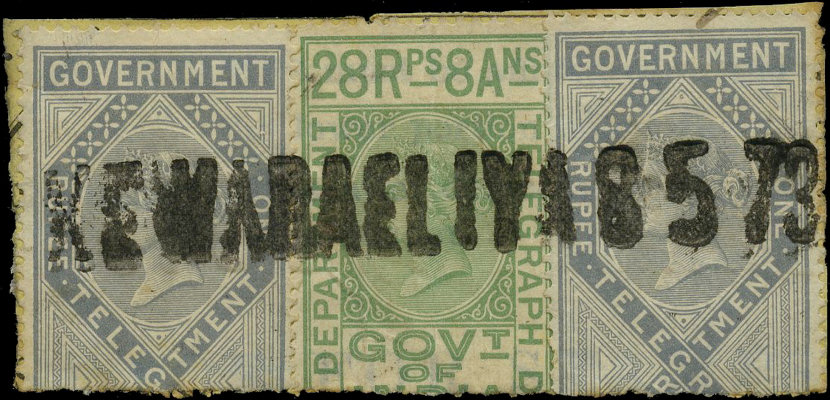
From lot 34 of the listing of the Taprobana Collection Auction, courtesy of Stanley Gibbons.

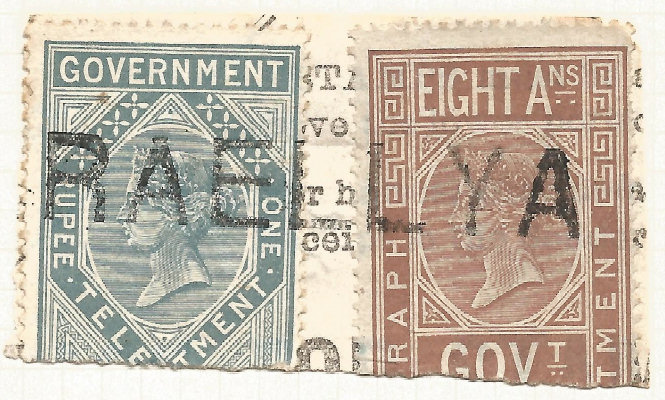
Images courtesy of Wimal Suaris.
Panadure
Images are needed for this if anyone can help.
Trincomalee

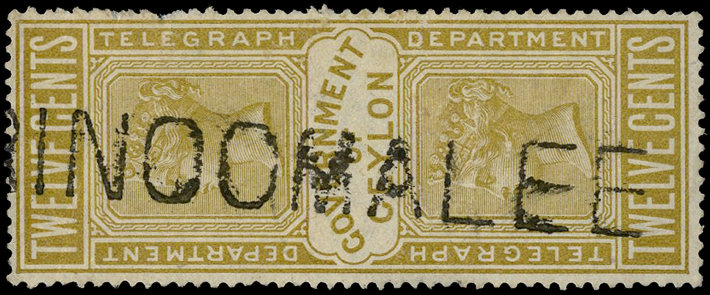
Scarce Type 1 from lot 35, and the later Type 2 from lot 78 of the listings of the Taprobana Collection Auction, courtesy of Stanley Gibbons.
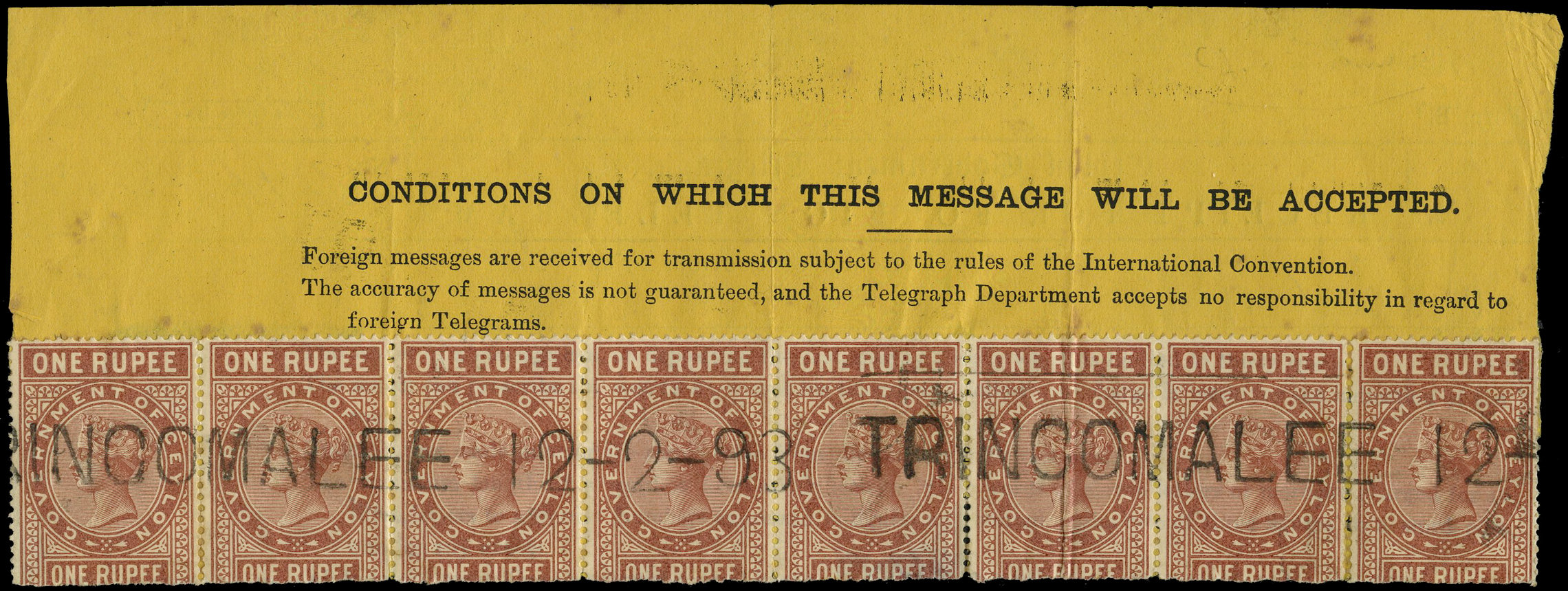
Complete Type 2 from lot 86, of the listing of the Taprobana Collection Auction, courtesy of Stanley Gibbons. This is shown at 80% scale.
Other
Steve Hiscocks made a point of mentioning the Pearl Fishing grounds off northwest Ceylon. This was in the Gulf of Manaar.
According to Stanley Gibbons, this was used at the temporary office of Silavaturaiis and is recorded between 30th March and 3rd May 1881 only.
I guess you can see what happens if you soak any of these !
These are mostly known dated in April of 1881.
In Marichchukaddi, a cds of "PEARL FISHERY" was used. I have seen these dated 25 February 1881 to 18 March 1905.
The October 2020 edition of Gibbons Stamp Monthly also published a Special Feature on the Pearl Fishery cancellations.(PDF)
Queen Victoria 'double-headed'
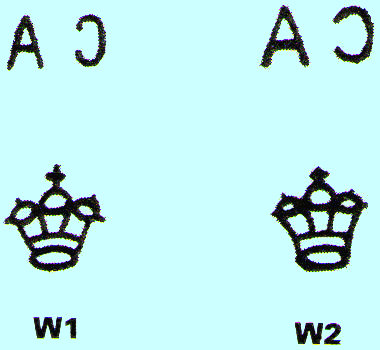
1881 (14 February) Surface printed by de la Rue on white wove paper. Watermark CA / Crown (W1). Perf. 14
 |
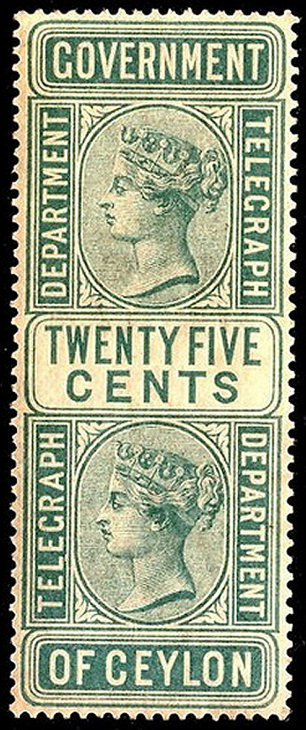 |
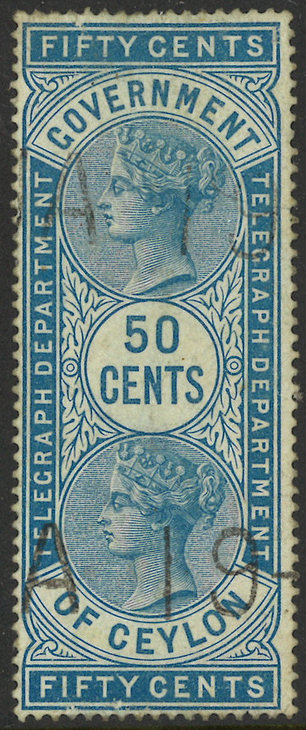 |
| 12c. Pair showing shades (H27/H39). | 25c. (H28) | 50c used (H29/H41) |
| Image courtesy of Wimal Suaris. | Courtesy of Socrates Antypas (storypost). | Image courtesy of Wimal Suaris. |
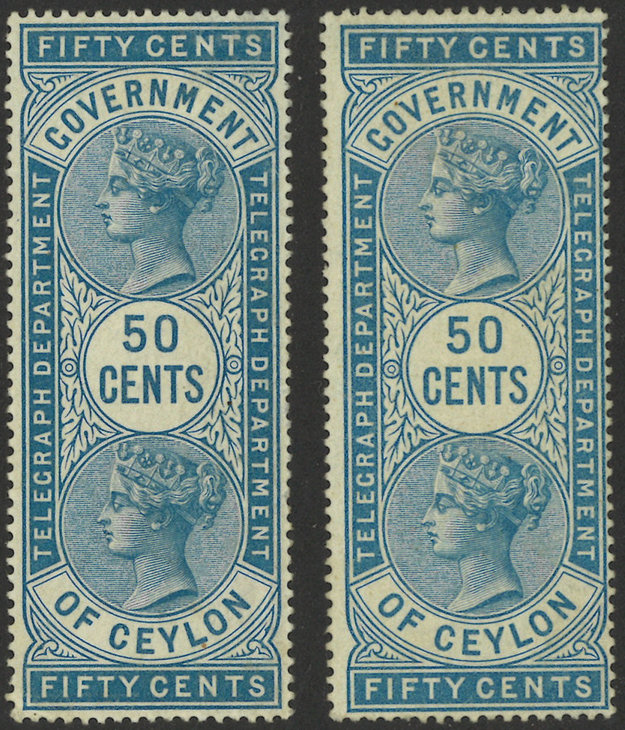 |
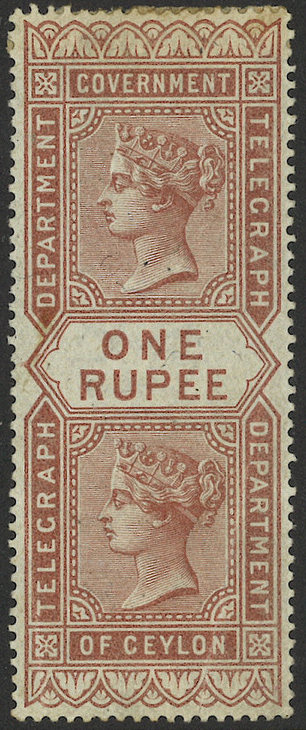 |
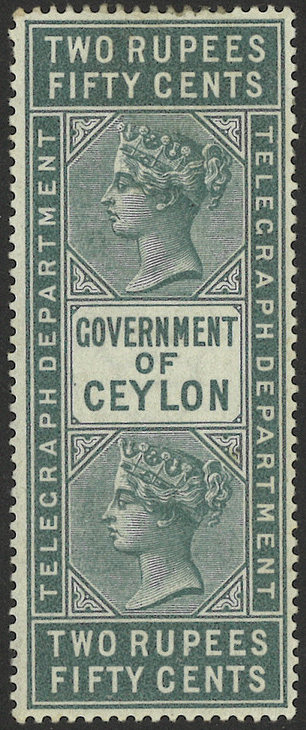 |
| 50c. Pair showing shades (H29/H41). | 1R. (H30) | 2R.50c (H31/H43) |
| Images courtesy of Wimal Suaris. | ||
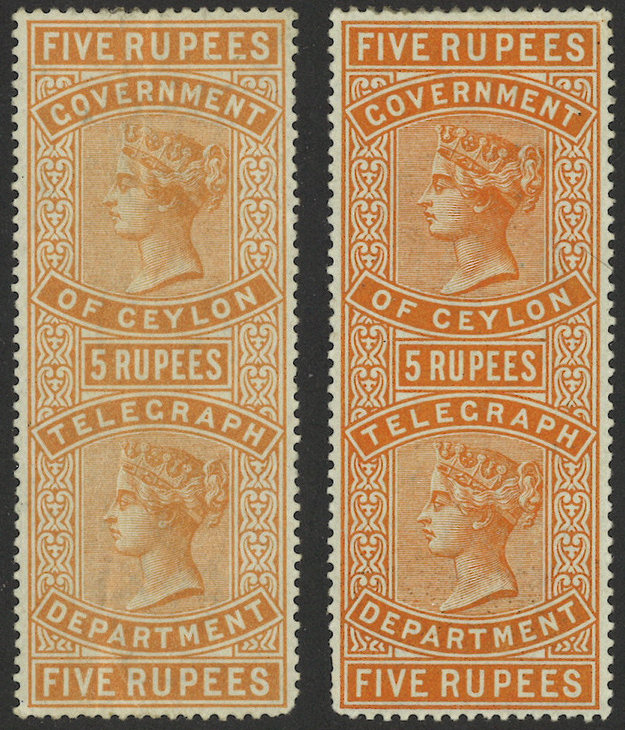 |
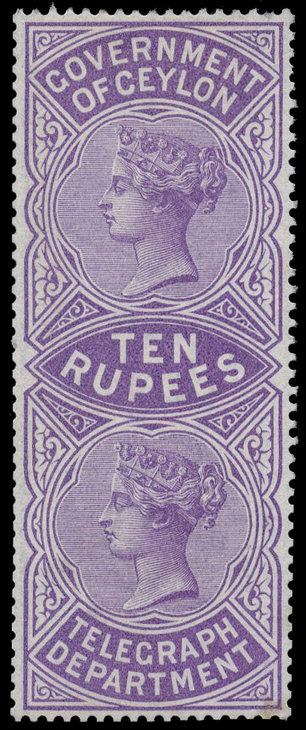 |
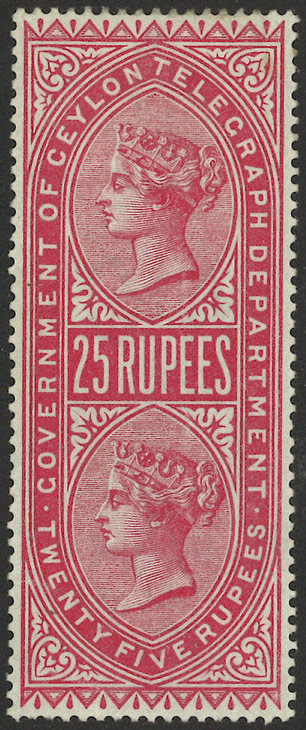 |
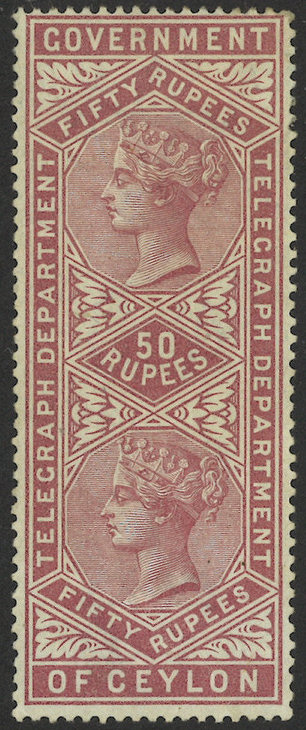 |
| 5R Pair showing shades (H32/H44). | 10R (H33) - courtesy of Stanley Gibbons. | 25R (H34/H46) | 50R (H35/H47) |
| Images courtesy of Wimal Suaris. | Lot 28 of the Taprobana Collection Auction | Images courtesy of Wimal Suaris. | |
Hiscocks added the following note:
| Note. The printing on 'semi-laid' paper, which shows periodic vertical lines in the watermark, was a temporary expedient which affected only one year's supply. |
1882 (March) New designs — other details as above.
The original 25c, 1R and 10R just had the value in the centre. The new designs had the value at the top and bottom.
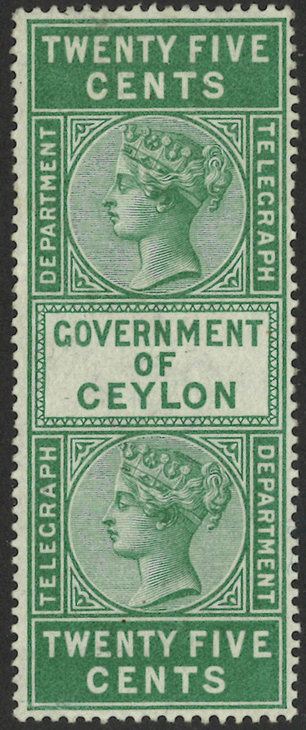 |
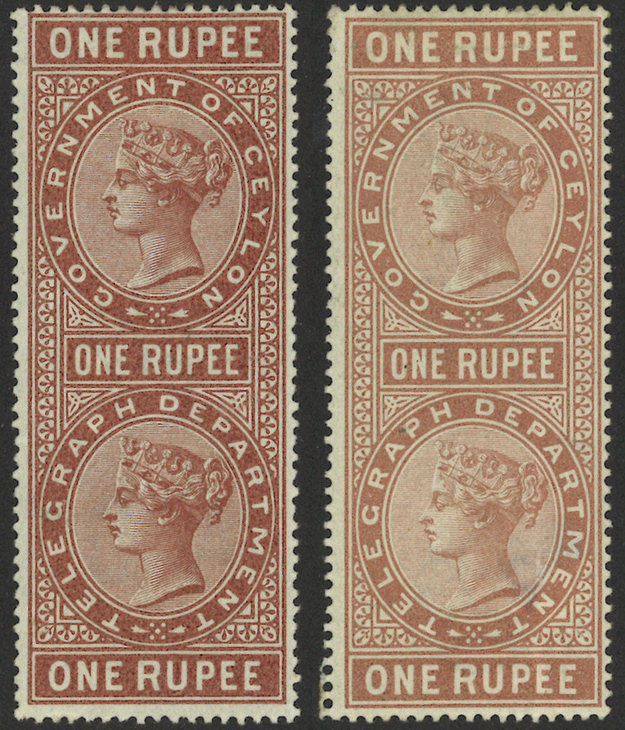 |
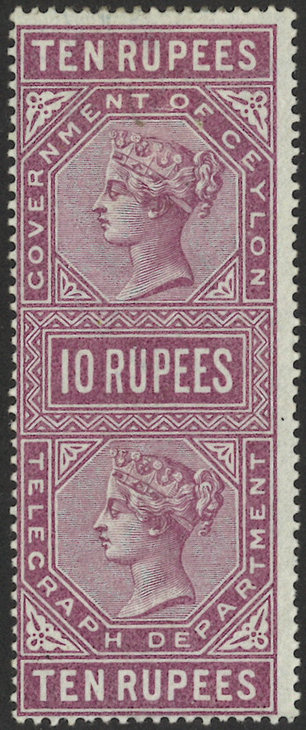 |
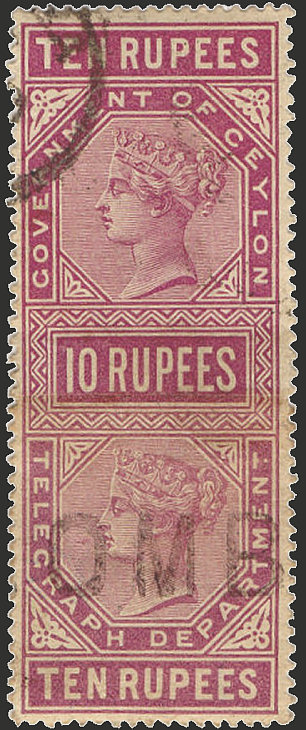 |
| 25c. (H36/H40) | 1R. Pair showing shades (H37/H42). | 10R. (H38/H45) | 10R. H38 / H45 used |
| Images courtesy of Wimal Suaris. | Courtesy of ibredguy.co.uk | ||
| Hisc. | Description | Mint | Used |
|---|---|---|---|
| H36 | 25c green (shades) | 10.00 | 0.80 |
| H36a | on 'semi-laid' paper (1883) | 15.00 | 1.00 |
| H37 | 1R red-brown | 15.00 | 1.00 |
| H37a | on 'semi-laid' paper (1883) | 25.00 | 2.00 |
| H37b | watermark inverted | 50.00 | 10.00 |
| H38 | 10R rose-lilac | 80.00 | 2.00 |
| H38a | claret (shades) | 80.00 | 2.00 |
| H38b | reddish-purple (shades) | 80.00 | 2.00 |
| H38c | on 'semi-laid' paper (1883) | 120.00 | 6.00 |
Hiscocks added the following note:
| Note. The original designs of the 25c, 1R and 10R were such that the actual value was often lost on half stamps. This made checking difficult and was quickly rectified by the introduction of the new designs. |
1894 As above but watermark CA / Crown (W2).
| Hisc. | Description | Mint | Used |
|---|---|---|---|
| H39 | 12c olive bistre | 20.00 | 0.80 |
| H39a | bistre | 20.00 | 0.80 |
| H40 | 25c green | 20.00 | 0.60 |
| H40a | bluish green | 20.00 | 0.60 |
| H41 | 50c blue | 20.00 | 0.80 |
| H41a | dark blue | 20.00 | 0.80 |
| H42 | 1R red-brown (shades) | 20.00 | 0.60 |
| H43 | 2½R pale slate grey | 24.00 | 0.80 |
| H43a | slate grey | 24.00 | 0.80 |
| H44 | 5R brown orange | 32.00 | 1.00 |
| H44a | yellow orange | 32.00 | 1.00 |
| H45 | 10R purple (shades) | 96.00 | 1.50 |
| H45a | claret | 96.00 | 1.50 |
| H45b | dull magenta | 96.00 | 1.50 |
| H46 | 25R carmine (shades) | 360.00 | 1.50 |
| H47 | 50R lake (shades) | 720.00 | 10.00 |
Hiscocks added the following note:
| Note. Both the 1881 and 1894 issues are found overprinted 'specimen' or 'cancelled' by hand. Prices roughly as mint. |
1882-1894 Provisionals
1882 — 94 Provisionals. Surcharged by the Ceylon Government printer on Nos. 27 to 38 (i.e. watermark W1 except where stated to be W2)
in black except where red (R) or vermilion (V) is stated.
| Shortcuts to different provisional years | |||||||||||
| 1882 | 1883 | 1884 | 1885 | 1886 | 1887 | 1888 | 1889 | 1890 | 1891 | 1892 | 1894 |
1882 issues.
 |
 Lot 86, of the Taprobana Collection Auction. |
 |
 |
 |
| 40c on 50c. H48, Type 14, courtesy of Wimal Suaris. |
40c on 50c. H48a Courtesy of Stanley Gibbons. |
60c on 1R. H49, Type (15), courtesy of Wimal Suaris. |
80c on 1R. H50, Type 15, courtesy of Wimal Suaris. |
40c on 2½R. H51, Type (16), courtesy of Wimal Suaris. |
These type numbers can also have different values of the same style (which is then quoted in brackets).
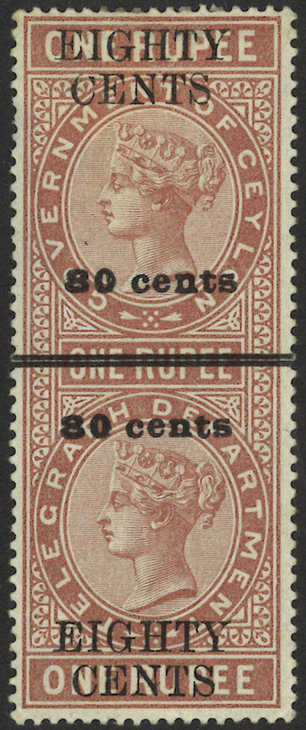 |
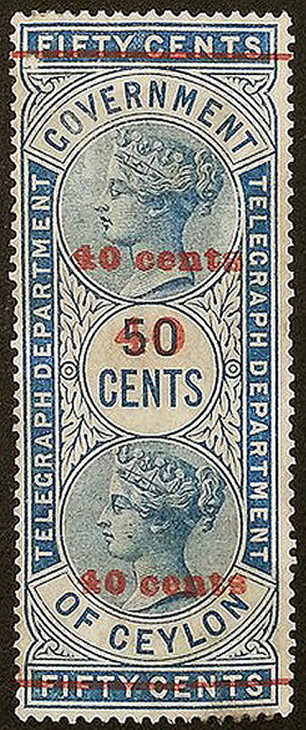 |
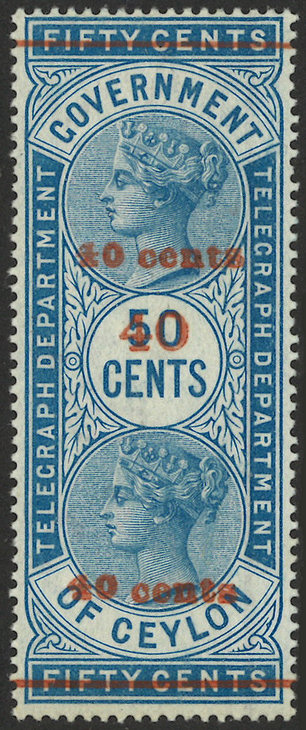 |
 |
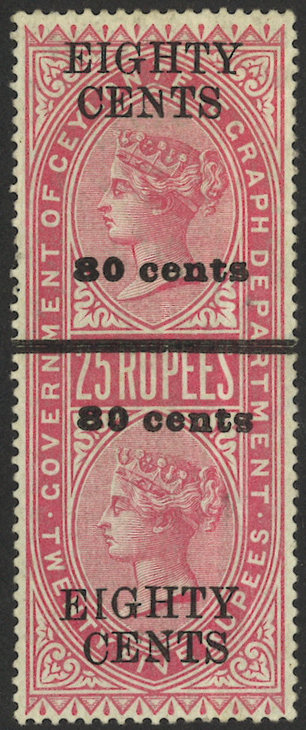 |
| 80c on 1R. H60, Type 23. | 40c on 50c. H61 (Hiscocks noted that there are two different spacings) On the left there is about 15.75mm between the top bar and "40". On the right it is about 16.5mm. For reference purposes, I will designate less than 16mm as Type I and greater than 16mm as Type II. |
60c on 50R. H62 | 80c on 25R. H63 | |
| Image courtesy of Wimal Suaris. | Courtesy of (ye_olde_world) | Images courtesy of Wimal Suaris. | ||
 |
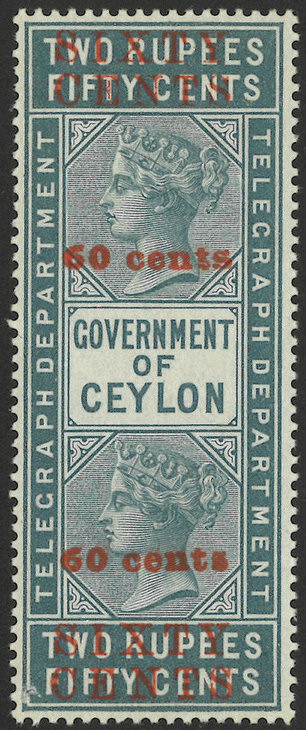 |
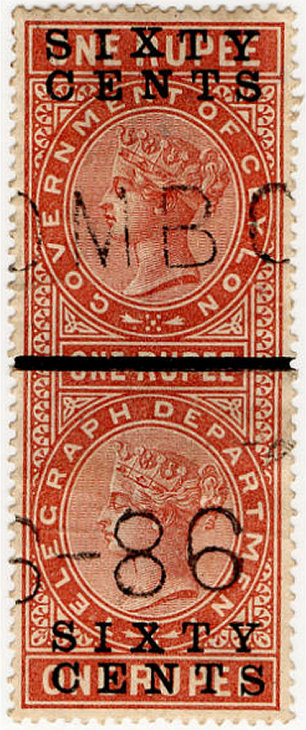 |
| 40c on 50c. H67 (avoid confusion with H61 above) |
60c on 2R 50c. H68 (overprints 29 and 31 are easily confused) |
60c on 1R. H83 |
| Courtesy of Wimal Suaris. | Image courtesy of ibredguy.co.uk | |
1883 issues.
 |
 |
 |
| 60c on 2½R. H68, Type 29. Wide "SIXTY CENTS". See H72/75 for narrow. |
80c on 25R. H69, Type (30) Note: 2 bars over old value. From RL. |
80c on 50R. H70, Type 30, from RL. |
H68 is courtesy of Wimal Suaris.
| RH # | Hisc. | Type | 1883 Description | Mint | Used |
|---|---|---|---|---|---|
| RH61 | H61 | 24 | 40c on 50c (No. 29) (V) 5.2.83 (4000) see note. | 45.00 | 9.00 |
| RH61a | H61a | on 'semi-laid' paper | 45.00 | 9.00 | |
| *RH61b | - | 24 | overprint in black | - | - |
| RH62 | H62 | 25 | 60c on 50R (No. 35) 5.2.83 (3600) | 45.00 | 9.00 |
| RH62a | H62a | on 'semi-laid' paper | 45.00 | 9.00 | |
| RH63 | H63 | 23 | 80c on 25R (No. 34) 5.2.83 (2400) | 60.00 | 15.00 |
| RH63a | H63a | on 'semi-laid' paper | 60.00 | 9.00 | |
| RH64 | H64 | 26 | 40c on 50c (No. 29) (see Note 1 below) | - | 60.00 |
| RH64a | H64a | on 'semi-laid' paper | - | 60.00 | |
| RH65 | H65 | (26) | 60c on 50R (No. 35) (see Note 1 below) | - | 60.00 |
| RH65a | H65a | on 'semi-laid' paper | - | 60.00 | |
| RH66 | H66 | 27 | 60c on 1R (No. 37) (see Note 1 below) | - | 60.00 |
| RH66a | H66a | on 'semi-laid' paper | - | 60.00 | |
| RH67 | H67 | 28 | 40c on 50c (No. 29) (V) 20.7.83 (6000) see note. | 45.00 | 6.00 |
| RH67a | H67a | on 'semi-laid' paper | 45.00 | 6.00 | |
| RH68 | H68 | 29 | 60c on 2½R (No. 31) (V) 20.7.83 (6000) | 45.00 | 6.00 |
| RH68a | H68a | on 'semi-laid' paper | 45.00 | 6.00 | |
| RH69 | H69 | (30) | 80c on 25R (No. 34) 20.7.83 (2000) | 90.00 | 15.00 |
| RH69a | H69a | on 'semi-laid' paper | 90.00 | 15.00 | |
| RH70 | H70 | 30 | 80c on 50R (No. 35) 20.7.83 (2500) | 90.00 | 13.50 |
| RH70a | H70a | on 'semi-laid' paper | 90.00 | 13.50 |
*RH61b has been added to accommodate John Barefoots' type 58 which was not listed by Hiscocks.
Hiscocks added the following 2 notes:
| Note 1. Nos. 64, 65 and 66 are unaccounted for in the records and neither the date of printing or the numbers surcharged are known. They seem to be related and No. 65 is known dated June 1883 which is why they are placed here. All are scarce. |
| Note 2. I have copies of No. 61 on two shades of blue with the spacing between the single upper line, and the top of the word 'cents' being nearly 1mm more on the darker. The significance of this is not clear at present and further information is needed. |
1884 issues.
 |
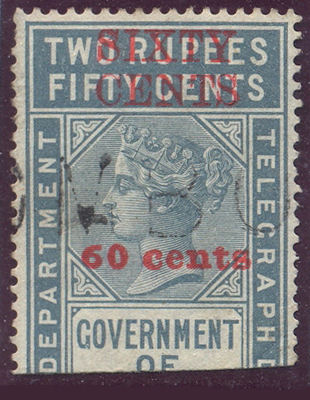
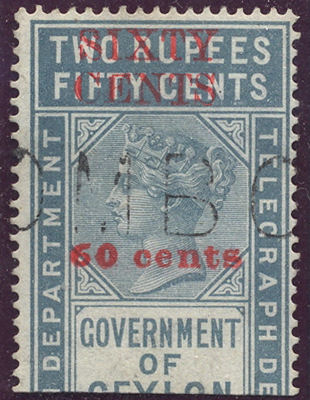 |
 |
 |
| 40c on 50c. H71, Type 26, from RL. | 60c on 2½R. H72/75 (see Note 2), Type 31. Narrow "SIXTY CENTS". See H68 for wide. The bottom "cents" has different spacing between these. Perhaps they are the different types, but dated examples are needed to know which is which. Images from RL. |
80c on 25R. H73, Type (15), courtesy of Stanley Gibbons. |
40c on 50c. H74/67 (see Note 2), Type 28. |
| Hisc. | Type | 1884 Description | Mint | Used |
|---|---|---|---|---|
| H71 | 26 | 40c on 50c (No. 29) (R) 23.4.84 (4000) | - | 12.00 |
| H71a | on 'semi-laid' paper | - | 12.00 | |
| H72 | 31 | 60c on 2½R (No. 31) (R) 23.4.84 (5000) see note 2. | 60.00 | 9.00 |
| H72a | on 'semi-laid' paper | 60.00 | 9.00 | |
| H73 | (15) | 80c on 25R (No. 34) 23.4.84 (2000) | 90.00 | 15.00 |
| H73a | on 'semi-laid' paper | 90.00 | 15.00 | |
| H74 | 28 | 40c on 50c (No. 29) (R) 3.9.84 (5040) see note 2. | 45.00 | 6.00 |
| H74a | on 'semi-laid' paper | 45.00 | 6.00 | |
| H75 | 31 | 60c on 2½R (No. 31) (R) 3.9.84 (4000) see note 2. | 60.00 | 9.00 |
| H75a | Surcharge misplaced — see Note 1 | 150.00 | 120.00 | |
| H75b | on 'semi-laid' paper | 60.00 | 12.00 | |
| H76 | 32B | 80c on 5R (No. 32) 3.9.84 (1040) | - | 30.00 |
| H76a | on 'semi-laid' paper | - | 30.00 | |
| H77 | 32 | 80c on 10R (No. 38) 3.9.84 (560) | - | 45.00 |
| H77a | on 'semi-laid' paper | - | 45.00 | |
| H78 | 32A | 80c on 50R (No. 35) 3.9.84 (400) | - | 60.00 |
| H78a | on 'semi-laid' paper | - | 60.00 |
Hiscocks added the following 2 notes:
| Note 1. This surcharge is placed so low that on some copies an additional upper bar has been added in ink to delete the original value. This would presumably have been necessary only for the top row and lower rows should have a double surcharge at the top but these have not been reported. |
| Note 2. No. 74 and No. 75 have been listed separately but appear to be reprints of No. 67 and No. 72 respectively. Perhaps someone with dated copies can discover distinguishing features — the shades of Nos. 74 and 67 may be different perhaps. There do seem to be two types of Type 31 — one which the distance between the numerals and the top letters is 12mm and where it is 11½mm. The alignment between the two parts of the overprint also differ by about 1mm. None of the eight or so copies I have been able to examine has been clearly dated and the sample is too small for relative rarities to help. |
1885 issues.
 |
 |
 |
 |
| 40c on 50c. H79, Type 33 from RL. |
40c on 50c. **H80, Types 33 & 37, This is just a mockup based on the description. |
60c on 1R. H81, Type (33), courtesy of Wimal Suaris. |
80c on 2½R. H82, Type 34, courtesy of Wimal Suaris. |
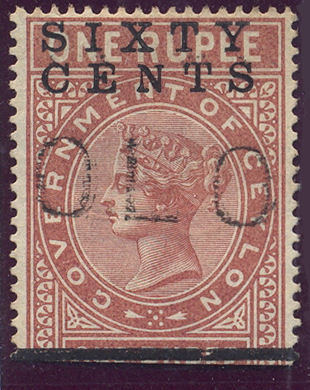 |
 |
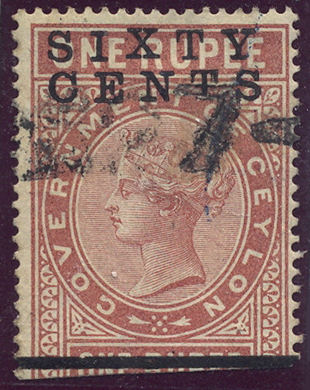 |
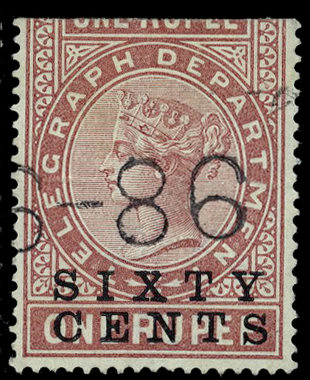 |
| 60c on 1R. H83, Type 35. There is some variability of the overprint. On the left, the 'N' of 'CENTS' has small serifs. In the centre, the 'X' of 'SIXTY' is slightly raised. On the right, the 'X' is raised further. Left and right from RL. Centre courtesy of Wimal Suaris. |
60c on 1R. H83, bottom half. Part of lot 178 of the Taprobana Collection Auction, courtesy of Stanley Gibbons. |
||
 |
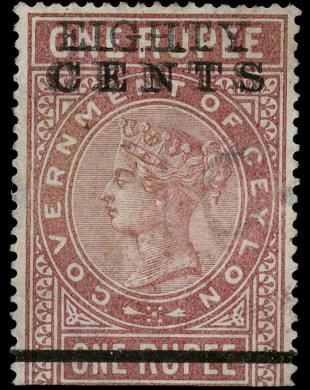 |
 |
| 80c on 1R. H84, Type (35), from RL. | H84a, lot 178 of the Taprobana Collection Auction. Courtesy of Stanley Gibbons. |
H84, bottom half. Part of lot 206 of the Taprobana Collection Auction, courtesy of Stanley Gibbons. |
| Hisc. | Type | 1885 Description | Mint | Used |
|---|---|---|---|---|
| H79 | 33 | 40c on 50c (No. 29) (R) 2.3.85 (10000) | - | 6.00 |
| H80 | 33 + 37 | 40c on 50c (No. 29) as No 79(R) + as No 86 in black (see note) ** | - | 135.00 |
| H81 | (33) | 60c on 1R (No. 37) 2.3.85 (1600) | - | 18.00 |
| H82 | 34 | 80c on 2½R (No. 31) 2.3.85 (3600) | - | 12.00 |
| H83 | 35 | 60c on 1R (No. 37) 6.7.85 (8000) | 75.00 | 7.50 |
| H84 | (35) | 80c on 1R (No. 37) 6.7.85 (8000) | 75.00 | 7.50 |
| H84a | surcharge double (one faint) | 150.00 | 75.00 |
** Hiscocks lists this as on 50R (No.29) which I think is a typo for 50c. Presumably this was produced in 1886.
Hiscocks added the following note:
| Note. The black surcharge on No. 80 is not exactly like that of No. 86 below but similar to it (smaller type). It has not in fact been observed on its own. |
My comment on this: Hiscocks description could have been clearer,
I have used the '+' symbol in place of the original to make it clear that
there are two overprints, one red and the other black.
Also Hiscocks originally describes this as "40c on 50R (No 29)",
No 29 is 50c which is what I think he means.
To me, the fact that the black surcharge is not known on anything else,
strongly suggests that it is a forgery.
Can anyone supply an image of H80 ?
1886 issues.
| RH # | Hisc. | Type | 1886 Description | Mint | Used |
|---|---|---|---|---|---|
| RH85 | H85 | 36 | 20c on 25c (No. 36) 9.7.86 (7000) | 45.00 | 7.50 |
| RH85a | H85a | surcharge at marked angle to horizontal | 150.00 | 90.00 | |
| RH86 | H86 | 37 | 40c on 50c (No. 29) 9.7.86 (20000) | 30.00 | 4.50 |
| RH86a | H86a | surcharge double (very slight displacement) | 90.00 | 60.00 | |
| RH87 | H87 | 38 | 60c on 1R (No. 37) 9.7.86 (5000) | 60.00 | 10.50 |
| RH87a | H87a | surcharge double (one faint and inverted) | 120.00 | 90.00 | |
| RH88 | H88 | (36) | 80c on 2½R (No. 31) 9.7.86 (8000) | 60.00 | 9.00 |
| RH88a | - | surcharge double (one faint) | 120.00 | 80.00 |
1887 issues.
 |
 |
 |
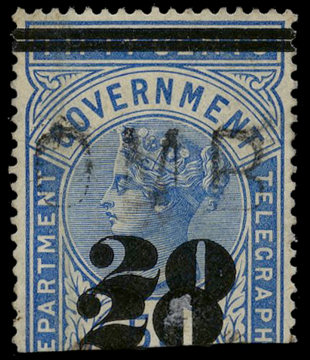 Lot 133 of the Taprobana Collection Auction, courtesy of Stanley Gibbons. |
 |
| 60c on 2½R. H89, Type 39 courtesy of Keith Attwood on eBay. |
20c on 25c. H90, Type (40), from RL. | 20c on 50c. H91, Type 41. | 20c on 50c. H91a, Type 41. | 20c on 50c. H91, bottom part, courtesy of Wimal Suaris. |
 |
 |
| 12c on 25c. H96, Type 40, from RL. | 12c on 50c. H97, Type 43. |
 |
 |
 |
| 60c on 1R. H98, Type 44, from RL. | 60c on 2½R. H99, Type 45, from RL. | 80c on 5R. H100, Type 46, courtesy of Wimal Suaris. |
| Hisc. | Type | 1887b Description | Mint | Used |
|---|---|---|---|---|
| H96 | 40 | 12c on 25c (No. 36) 20.4.87 (800) | 180.00 | 75.00 |
| H97 | 43 | 12c on 50c (No. 29) 20.4.87 (8000) | 90.00 | 7.50 |
| H98 | 44 | 60c on 1R (No. 37) 10.8.87 (2000) | - | 12.00 |
| H99 | 45 | 60c on 2½R (No. 31) 10.8.87 (1040) | - | 24.00 |
| H100 | 46 | 80c on 5R (No. 32) 10.8.87 (1600) | - | 18.00 |
 |
 |
 |
 |
 |
| 80c on 10R. H101, Type 47, courtesy of Wimal Suaris. |
80c on 25R. H102, Type (44), courtesy of Wimal Suaris. |
80c on 10R. H103, Type 48. This is just a mockup based on the description. |
40c on 50c. H104, Type 49. | 40c on 50c. H104, used bottom half, courtesy of Wimal Suaris. |
| Hisc. | Type | 1887c Description | Mint | Used |
|---|---|---|---|---|
| H101 | 47 | 80c on 10R (No. 38) 10.8.87 (1600) | - | 18.00 |
| H102 | (44) | 80c on 25R (No. 33) 10.8.87 (1600) | - | 18.00 |
| H103 | 48 | 80c on 10R (No. 38) date? (400?) | - | 150.00 |
| H104 | 49 | 40c on 50c (No. 29) 14.11.87 (30000) | 36.00 | 3.00 |
| H105 | 50 | 60c on 1R (No. 37) 21.12.87 (8000) | - | 7.50 |
| H106 | 51 | 80c on 5R (No. 32) 21.12.87 (1600) | - | 18.00 |
| H107 | 51 | 80c on 10R (No. 38) 21.12.87 (2400) | - | 12.00 |
| H108 | 51 | 80c on 25R (No. 34) 21.12.87 (2400) | - | 12.00 |
| H109 | 52 | 80c on 50R (No. 35) 21.12.87 (1600) | - | 18.00 |
Hiscocks added the following 2 notes:
| Note 1. While it is reported that the December issues are all unknown unused, lower halves are known; price x 5. |
| Note 2. No 103 is reported in only one case and its type would suggest an 1887 printing. It does not appear in the records however (several others are also missing from the records so this is not in itself cause for suspicion) and no other details are known. A printing of 400 is suggested as the usual minimum. |
1888 issues.
 |
 |
 |
| 20c on 25c. H110 | 80c on 1R. H112 | 12c on 50c. H113 |
| Images courtesy of Wimal Suaris. | ||
 |
 |
 |
 |
| 60c on 1R. H111, Type 54, from RL | 60c on 1R. H111, bottom half, courtesy of Wimal Suaris. |
80c on 2½R. H114, Type 56, courtesy of Wimal Suaris. |
60c on 2½R. H115, Type 57, from RL. |
H110, H112 and H113 are shown just above as complete mint.
| Hisc. | Type | 1888 Description | Mint | Used |
|---|---|---|---|---|
| H110 | 53 | 20c on 25c (No. 36) 13.4.88 (4000) | 60.00 | 9.00 |
| H111 | 54 | 60c on 1R (No. 37) 13.4.88 (4000) | 60.00 | 9.00 |
| H112 | (54) | 80c on 1R (No. 37) 13.4.88 (4000) | 60.00 | 15.00 |
| H112a | surcharge at marked angle to horizontal | 450.00 | 120.00 | |
| H113 | 55 | 12c on 50c (No. 29) 7.5.88 (4000) | 45.00 | 7.50 |
| H114 | 56 | 80c on 2½R (No. 31) 26.9.88 (4000) | 90.00 | 9.00 |
| H114a | word at top above figure (100?) | 450.00 | 240.00 | |
| H115 | 57 | 60c on 2½R (No. 31) 29.10.88 (3200) | 60.00 | 12.00 |
Hiscocks added the following note:
| Note. The guess at 100 copies of No 114(a) originally printed is based on the supposition that there was one such error in each sheet of 40. |
1889 issues.
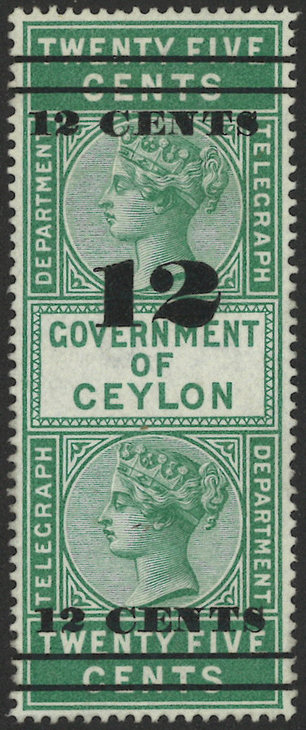 |
 |
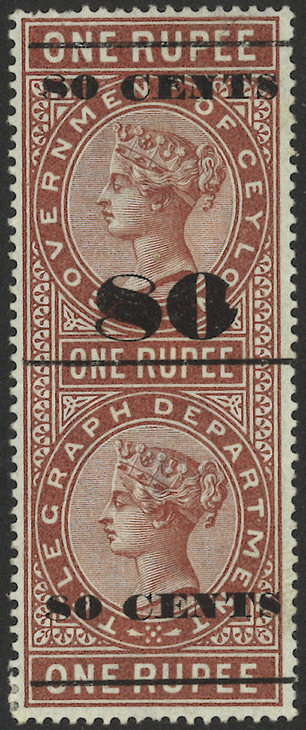 |
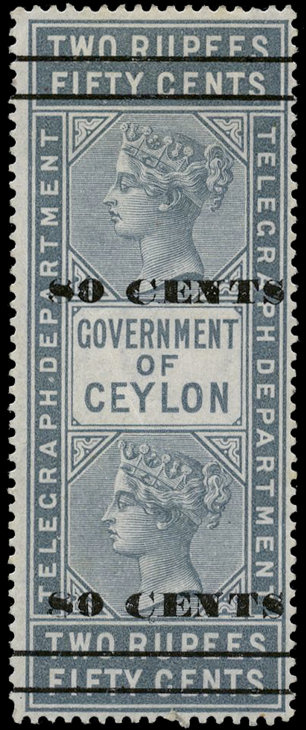 |
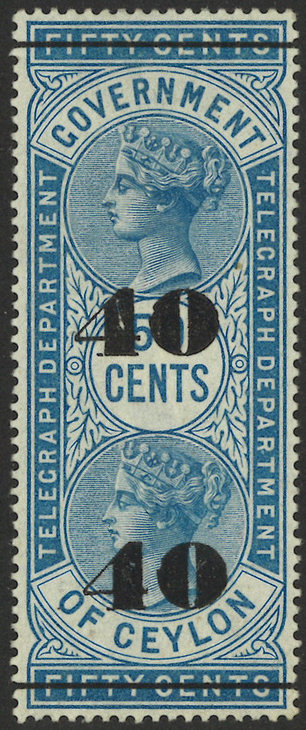 |
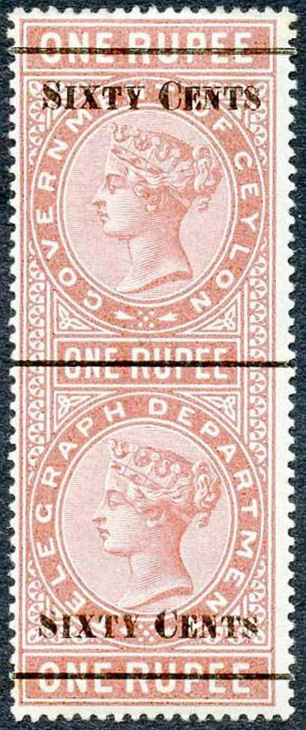 |
| 12c on 25c. H116, Type 58 | 60c on 1R. H122, Type 63 | 80c on 1R. H123, Type (63) | 80c on 2R50c. H125, Type (65), Lot223 of the Taprobana Collection Auction |
40c on 50c. H126, Type (66) | 60c on 1R. H129, Type 69 |
| Images courtesy of Wimal Suaris. | Courtesy of Stanley Gibbons. | Image courtesy of Wimal Suaris. | Image courtesy of Mark Bloxham. | ||
My Note: I do not know if the broken digit on H123 is constant, but if it is, we know it is in the first column of the sheet because of the beginning of the bars.
Though the lettering was laid down a stamp at a time, the bars were ruled across a row of stamps at a time. Because of this, slight inaccuracies
can lead to variations of line thickness and the distance between lines and lettering, particularly between stamps on different rows. Damnaged lettering is also common.
 |
 |
 |
 |
| 12c on 25c. H116, Type 58 | 12c on 25c. H117, Type 59, courtesy of Wimal Suaris. |
12c on 50c. H118, Type 60, from RL. | 12c on 50c. H119, Type 61, courtesy of Wimal Suaris. |
 |
 |
 |
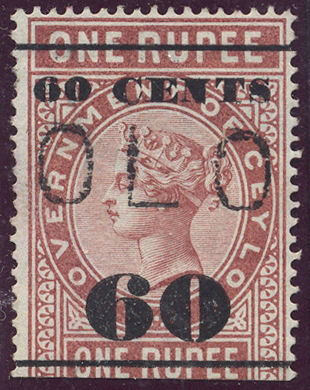 |
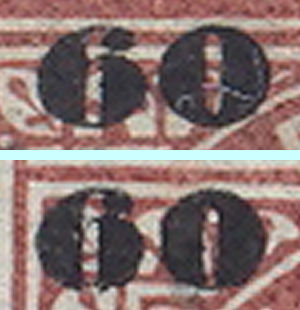 |
| 20c on 50c. H120, Type 62. | 40c on 50c. H121, Type (62). courtesy of Harry Patsalos. |
60c on 1R. H122, Type 63. The "60" at the top is a poor font which can look like "00" with a little over-inking. See comparison. The stamp on the right is an example, with the "N" also partially filled in. Images from RL. |
||
 |
 |
 |
 |
| 80c on 1R. H123, Type (63), from RL. | 80c on 1R. H124, Type 64. Used in Hatton (on Colombo-Badulla railway line) |
80c on 2½R. H125, Type 65. From RL. |
40c on 50c. H126, Type (66), dated in 1889 H134 is very similar, see note 3 |
 |
 |
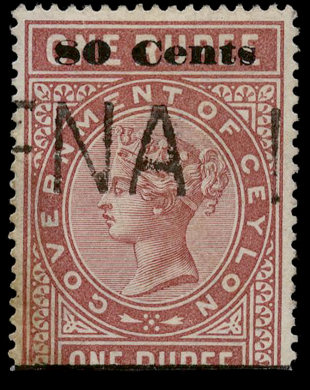 |
 |
| 20c on 50c. H127, Type 67, from RL. | 80c on 1R. H128, Type 68. | 80c on 1R. RH128a, (inverted "s"). Part lot 214 of the Taprobana Collection Auction. Courtesy of Stanley Gibbons. |
60c on 1R. H129, Type 69, courtesy of Wimal Suaris. |

A closeup of the in inverted "s" of RH128a.
| RH # | Hisc. | Type | 1889 Description | Mint | Used |
|---|---|---|---|---|---|
| RH116 | H116 | 58 | 12c on 25c (No. 36) 16.1.89 (1800?) | 60.00 | 12.00 |
| RH117 | H117 | 59 | 12c on 25c (No. 36) 16.1.89 (600?) | 120.00 | 36.00 |
| RH118 | H118 | 60 | 12c on 50c (No. 29) 16.1.89 (1200?) | 75.00 | 18.00 |
| RH119 | H119 | 61 | 12c on 50c (No. 29) 16.1.89 (400?) | 150.00 | 60.00 |
| RH120 | H120 | 62 | 20c on 50c (No. 31) 16.1.89 (8000) | 54.00 | 6.00 |
| RH121 | H121 | (62) | 40c on 50c (No. 31) 16.1.89 (20000) | 45.00 | 3.00 |
| RH122 | H122 | 63 | 60c on 1R (No. 37) 16.1.89 (13600) | 45.00 | 4.50 |
| RH123 | H123 | (63) | 80c on 1R (No. 37) 16.1.89 (8000) | 54.00 | 7.50 |
| RH124 | H124 | 64 | 80c on 1R (No. 37) 16.1.89 (2400) | 75.00 | 12.00 |
| RH124a | H124a | 19mm gap between letters and upper line | 75.00 | 12.00 | |
| RH125 | H125 | 65 | 80c on 2½R (No. 31) 16.1.89 (4000) | 75.00 | 9.00 |
| RH126 | H126 | (66) | 40c on 50c (No. 29) 23.7.89 (16000) see note 3 | 45.00 | 4.50 |
| RH127 | H127 | 67 | 20c on 50c (No. 29) 2.8.89 (8000) | 60.00 | 7.50 |
| RH128 | H128 | 68 | 80c on 1R (No. 37) 2.8.89 (4000) | 90.00 | 12.00 |
| RH128a | - | inverted "s" in "Cents" | - | - | |
| RH129 | H129 | 69 | 60c on 1R (No. 37) 12.12.89 (14400) | 45.00 | 6.00 |
Hiscocks added the following 5 notes:
| Note 1. It seems likely that Nos. 116 & 117 and Nos. 118 & 119 represent cases where two types were printed on the same sheet with the straight based '2' occurring in one row and the curly based '2' in the other three rows in each case. The printings of each type are therefore queried although the total printings, 2400 and 1600, are known. |
| Note 2. No. 124 seems to exist in two forms. In one the space between the upper line and the letters is 19mm and in the other it is 18mm. The latter spacing is the same as that between letters and upper line in No. 125. |
| Note 3. No. 126 is very similar in its upper half to No. 134 of 1890. No. 126 is on a lighter blue 50c base stamp than 134, and this is the only distinguishing mark on half stamps unless the cancellation date can be read. Whole stamps are easily distinguishable in that No. 134 has words on the lower half while No. 126 has only a number '40'. |
| Note 4. No. 128 shows a slight variation in the letter to line distance — 25¾mm and 25¼mm. |
| Note 5. No. 129 was printed with a very greasy ink which tended to smudge somewhat giving in some cases the (erroneous) impression of a double printing. There is again a slight variation in the distance between the two lines — 25¾mm and 25¼mm. |
1890 issues.
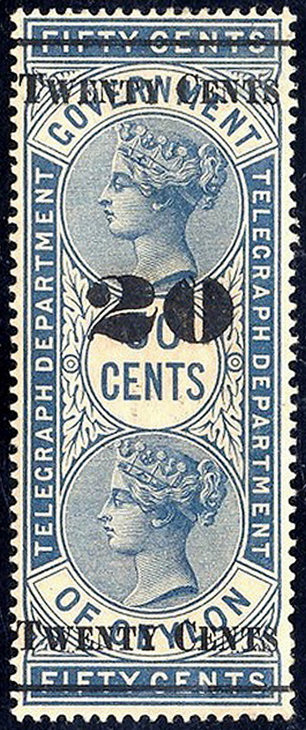 |
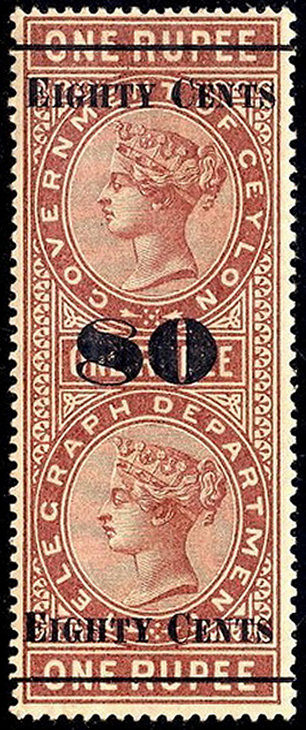 |
 The distance between "EIGHTY CENTS" at the top, and "80" is 18mm on H145 and 19mm on H132. |
| 20c on 50c. H142 (not H130) type 70. For differences, see note 3 below H145 |
80c on 1R. H145 type 71. For difference between this and H132, see note 3 below H145 |
80c on 1R. H132 type 71. |
| Images courtesy of Socrates Antypas (storypost) on eBay. | One of mine. | |
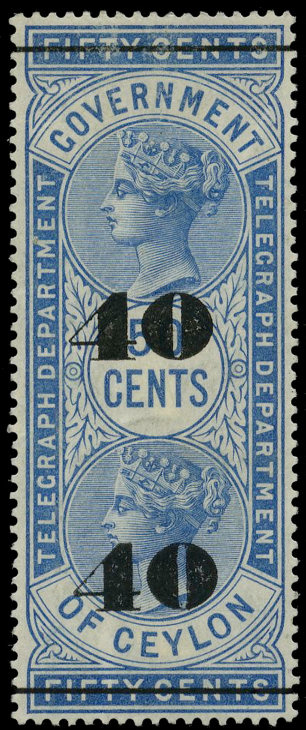 |
 |
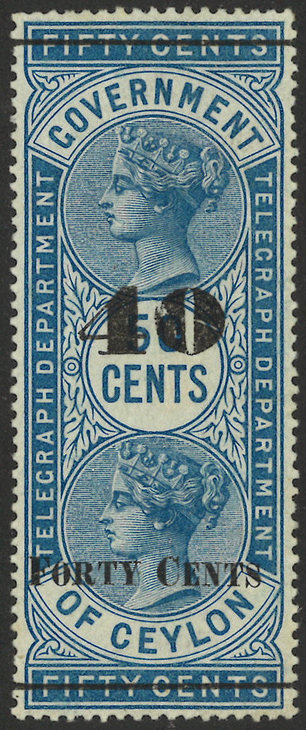 |
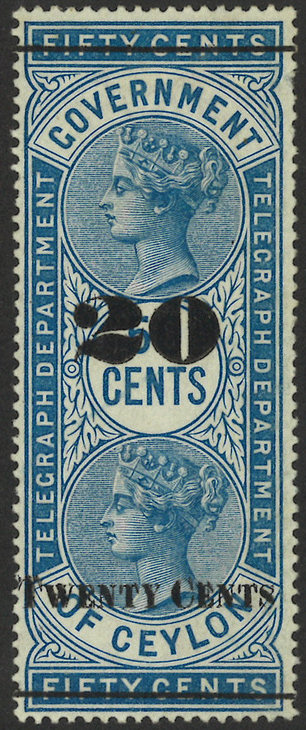 |
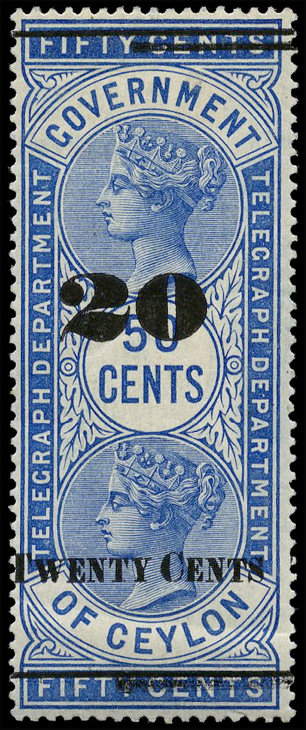 |
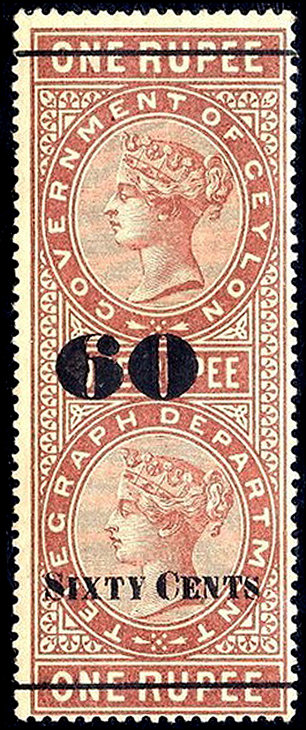 |
| 40c on 50c. H126 type (66). Part of lot 133 of the Taprobana Collection Auction |
80c on 2R.50c. H133 type 72. | 40c on 50c. H134 type (66). H126 is similar, but without the words. |
20c on 50c. H136 type (66). | H136 variant - Lot 133 of the Taprobana Collection Auction, The extra bars may have been added due to the high overprint. |
60c on 1R. H138 |
| Courtesy of Stanley Gibbons. | Courtesy of Wimal Suaris. | Courtesy of Socrates Antypas (storypost). | Courtesy of Socrates Antypas (storypost). | Courtesy of Stanley Gibbons. | Courtesy of Wimal Suaris. |
 |
 |
 |
 |
 |
| 20c on 50c. H130, Type 70. (Dated July 1890) See also the note below H142. |
40c on 50c. H131, Type (70), 18mm gap. See also H143 and note below it for 14.6mm gap. |
80c on 1R. H132, Type 71. A comparison with H145 is shown above. |
80c on 2½R. H133, Type 72, from RL. | 40c on 50c. H134/H126, Type (66), from RL. see note 3 above. and H134 below. |
 |
 |
 |
 |
| 80c on 2R.50c. H135 type 73. Courtesy of Wimal Suaris. |
20c on 50c. H136, Type 66. | 40c on 1R. H137, Type (66). | 60c on 1R. H138, Type (66). From RL. |
 |
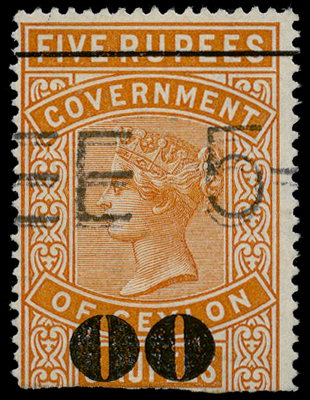 |
 |
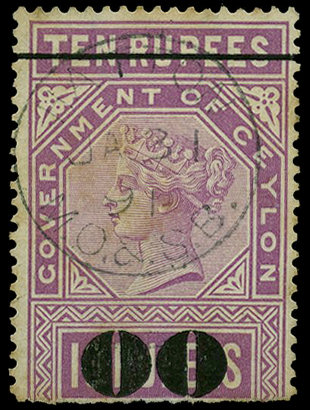 |
 |
| 80c on 5R. H139, Type (66). 23.114 mm gap. Courtesy of Mark Bloxham. |
80c on 5R. H139a, Lot 235 of the Taprobana Collection Auction. Courtesy of Stanley Gibbons. |
80c on 10R. H140, Type (66), 22.987 mm gap, courtesy of Wimal Suaris. |
80c on 10R. H140a, Lot 248 of the Taprobana Collection Auction. Courtesy of Stanley Gibbons. |
80c on 25R. H141, Type 74, Courtesy of Mark Bloxham. |
Beware of " 00 " forgeries.
These four "00" examples are very similar, including the large gap between the zeroes and all being sloping.
The zeroes are very different to those of the "80"s.
Hiscocks added the following 3 notes:
| Note 1. No. 134 is very similar in its upper half to No. 126 — see Note 3 for 1889 issues. |
| Note 2. The spacing between bar and numeral on No. 136 varies by about ½ mm. |
| Note 3. The numbers of '00' errors of Nos. 139 and 140 are estimated on the basis of one per sheet. A mint strip of these — two No.139 with No.139(a) between them — was exhibited in June 1901. |
Note 2 also applies to H137 with variation from about 22mm to about 23mm.
This is not unusual. The bar was across a whole row of stamps, but the numerals were individually typeset.
I measured the distance from the bottom of the bar to the top of "20" on the four images of H136 I had available.
They were actually amazingly consistent, ranging from 20.405 to 20.658 mm. A difference of about ¼ mm.
On the other hand, Rolf Lamprecht had drawn my attention to H133. Looking at his two (the first 2), and mine :
H133 examples.
 |
 |
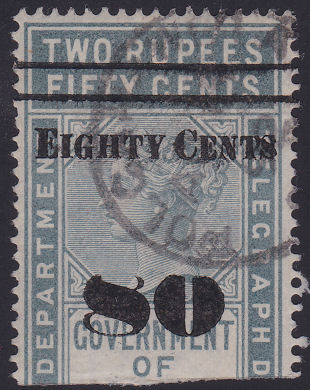 |
| RL1, undated | RL2, broken bar, dated Sept. 1890 | SP, broken "80", dated Aug. 1892 |
I decided to compare a couple of measurements (in pixels at 600dpi and converted to mm) between these three.
A: from the bottom of the top bar to the top of 'C' in "CENTS".
B: from the bottom of 'C' in "CENTS" to the bottom of "80".
| RL1 | RL2 | SP | Max. Diff. | |
| A | 118px = 5.00 mm | 113px = 4.78 mm | 119px = 5.04 mm | 6px = 0.254 mm |
| B | 354px = 14.99 mm | 378px = 16.00mm | 353px = 14.94 mm | 25px = 1.06 mm |
Again about ¼ mm bar to numeral range, but 1mm difference in the size of the rest.
1891 issues.
In My Notes: This appears to have got confused and some is just plain wrong.
I will try to sort it out below by showing comparisons:
In Note 2, says the larger separation should be on H131, but the dated example shown has it on H143.
In Note 3, the distances of 18mm and 19mm only apply to the H132/H145 pair.
I have 3 examples of 130/142. One of which is actually a lighter colour than the other two and dated July 1890 making it H130 (shown above).
The distance from the bottom of the lettering, to the top of the digit '0' measures about 14.75mm.

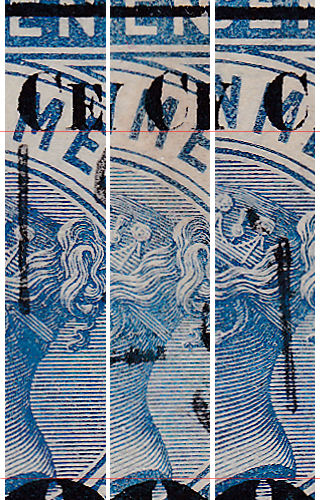

In this comparison of the three examples (scanned together at 600dpi), the lighter, dated example of H130 is in the centre and they are aligned by the bottom of 'C'
and the centre of '0'. The 'C' on the centre example is closer to the 'Y' by 0.45mm.
The example on the left has the 'C' further to the left of '0' than the other two. Apart from the shade difference, by Hiscocks criteria these are all slight variations
of H130, however the overall width of the 'TWENTY CENTS' is about 0.9mm less on the centre example than the other two, being 21.4mm against 22.3mm.
This suggests that the other two are the commoner H142, but the description of the difference given by Hiscocks has been confused, perhaps with H150/H160.
This compares the horizontal positioning between parts of H130(top) and H142(bottom). This is at 1200dpi, aligned by the back of the 'C'(red line).
Magenta is on the tip of the 'T', green on the right edge of the stem of 'Y', and blue on the extreme edge of the 'S'.
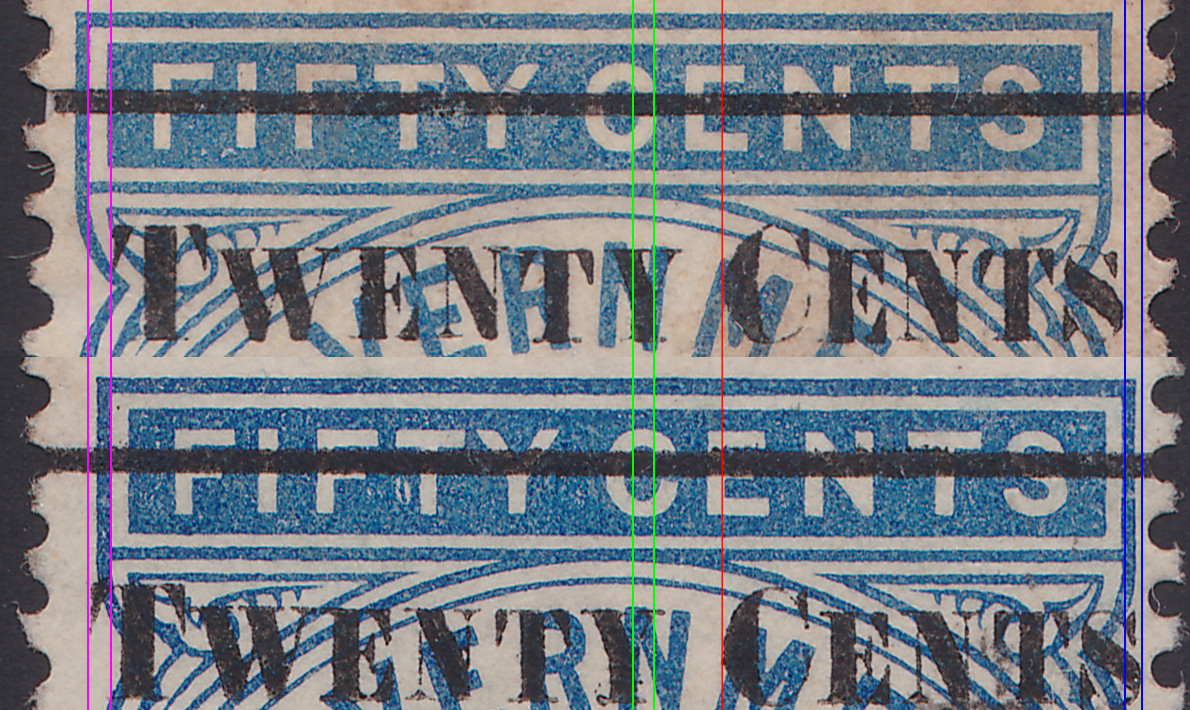
Table of results, sizes in mm rounded to nearest 0.01mm.
| 'TWENTY' (mm) | gap (mm) | 'CENTS' (mm) | Total (mm) | |
|---|---|---|---|---|
| H130 | 11.49 | 1.44 | 8.49 | 21.42 |
| H142 | 11.54 | 1.88 | 8.85 | 22.27 |
I have 7 examples of the H132/H145 pair. I initially separated them visually on the basis of the gap between 'EIGHTY' and 'CENTS' (Note 3)
Then I noticed that there was indeed also a difference in spacing between the lettering and the large numerals as in Note 2.
It turned out that the seven examples comprised 3 x H132 and 4 x H145, including one dated August 1891.
Wimal Suaris adds a couple of examples, with an 1891 example agreeing with my 1891 example.
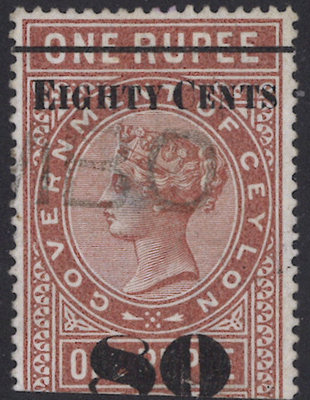 |
 |
 |
 |
| Undated example courtesy of Wimal Suaris. | These are mine, one dated August 1891. | Dated September 1891, courtesy of Wimal Suaris. | |
| These have the following characteristics: Distance from bottom of 'EIGHTY CENTS' to top of '80' approximately 19mm Size of gap between stem of 'Y' in 'EIGHTY' and 'C' in 'CENTS' approximately 1.3mm Undated |
These have the following characteristics: Distance from bottom of 'EIGHTY CENTS' to top of '80' approximately 18mm Size of gap between stem of 'Y' in 'EIGHTY' and 'C' in 'CENTS' approximately 2mm Dated August and September 1891 |
||
It seems reasonable to assume that the ones on the right dated in 1891 are H145 and the undated ones are H132.
However, it is possible that the dated ones are late usage H132, with the undated ones actually being H145, though it would be unlikely.
What is needed are examples clearly dated before 24/6/91 when the H145 was printed. Anyone have any?
1892 issues.
| Hisc. | Type | 1892 Description | Mint | Used |
|---|---|---|---|---|
| H146 | 75 | 25c on 50c (No. 29) 20.1.92 (1200) | - | 24.00 |
| H147 | 75 | 25c on 1R (No. 37) 3.2.92 (800) | - | 60.00 |
| H148 | (76) | 80c on 2½R (No. 31) 3.2.92 (3000) | - | 15.00 |
| H149 | (77) | 25c on 50R (No. 35) 26.2.92 (800) | - | 60.00 |
| *H150 | (75) | 20c on 1R (No. 37) Feb & March 1892 (5200) | - | 9.00 |
| *H151 | (75) | 40c on 1R (No. 37) Feb & March 1892 (14000) | - | 6.00 |
| H152 | (75) | 60c on 1R (No. 37) Feb & March 1892 (7200) | - | 7.50 |
| H153 | (75) | 80c on 1R (No. 37) March 1892 (3600) | - | 15.00 |
| H154 | (77) | 80c on 25R (No. 34) March 1892 (1000) | - | 30.00 |
| H155 | 77 | 80c on 50R (No. 35) March 1892 (1000) | - | 45.00 |
| H156 | 76 | 20c on 25c (No. 36) 1.4.92 (2400) | - | 12.00 |
| H157 | (75) | 40c on 50c (No. 29) 1.4.92 (2400) | - | 12.00 |
| H158 | 78 | 5R on 25R (No. 34) 1.4.92 (5200) | 30.00 | 9.00 |
| H158a | lower case 's' in 'RUPEEs' (130?) | 50.00 | 60.00 |
* H150 and H151 are very similar to H160 and H159 respectively of the 1894 issue,
the difference being in the distance between the words at the top and the large digits, 18mm in 1892 and 19mm in 1894.
See Note 2 below H163.
Hiscocks added the following 2 notes:
| Note 1. The number guessed at for No 158(a) is again assuming one in each sheet of 40. |
| Note 2. I have specimens of No 157 with both 20mm and 21mm between centre number and bar. |
1894 issues.
 |
 |
 |
| 40c on 1R. H159, Type (75), from RL. | 40c on 1R. H159(probably), bottom half. See note 2 below. Image courtesy of Wimal Suaris. |
20c on 1R. H160, Type (75), this is a mockup, like H150 but with a 19mm gap rather than 18mm. |
 |
 |
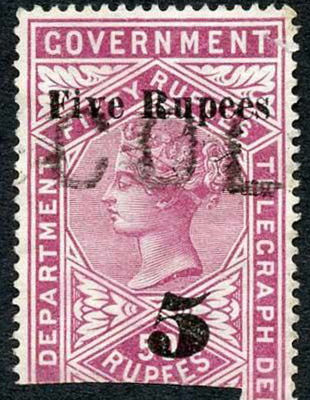 |
 |
 |
| 5R on 50R. H161/162, Type 79. top and bottom used halves courtesy of Wimal Suaris. |
5R on 50R. RH161/2a, Type 79. " 5 " misplaced right. Image courtesy of Mark Bloxham. |
5R on 25R. H163, Type 80. top and bottom used halves courtesy of Wimal Suaris. |
||
 |
 |
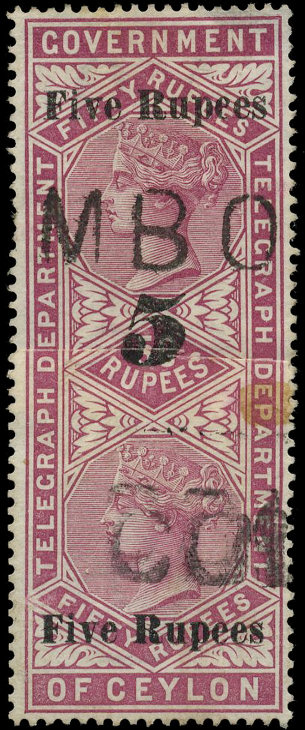 |
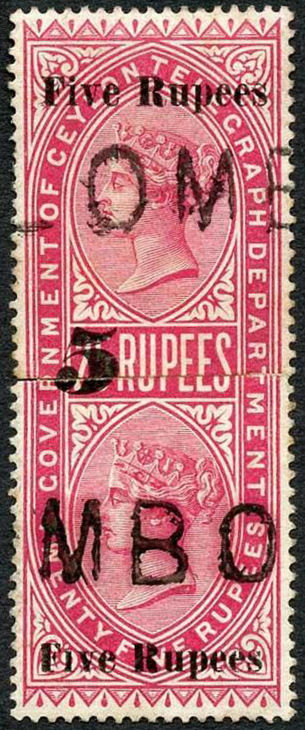 |
| 20c on 1R. H150, Type (75) | 40c on 1R. H159, Type (75) | 5R on 50R. H161/2, Type 79. from 2 halves | 5R on 25R. H163, Type 80. |
| Images of full stamps, each made from 2 halves) from RL | Lot 264 of Taprobana Collection Auction. Courtesy of Stanley Gibbons. |
from 2 halves courtesy Mark Bloxham | |
On the 40c stamp, the top of the '40' can just be seen on the top half at a gap of 19.26mm making it H159.
On the 20c, the gap on the top half is 18mm making it H150.
I do not know the criteria for distinguishing between the 1892 and 1894 bottom halves.
The three I have seen are in the range of 18.12mm to 18.42mm.
Hiscocks says that 1894 bottom halves are quite common, so it is likely the these 3 are all from that issue.
I have not been able to obtain images of all the provisional overprints. Some are quite scarce.
For some (H64, H65, H66, H80, H95, H103 and H160) I have created mockups based on their descriptions, these are marked as such.
Can anyone provide scans of any of those ?
Before moving on, here are some bogus items from RL :
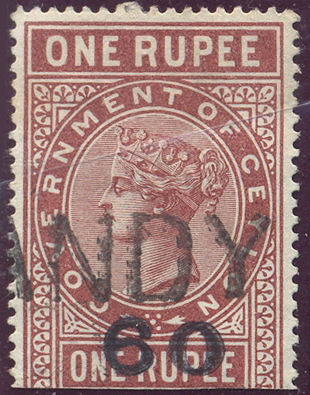

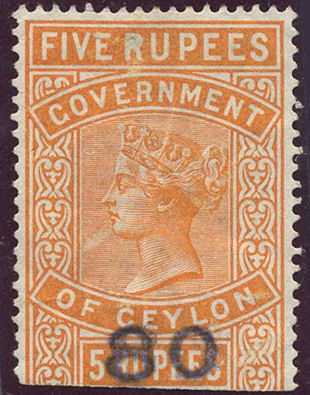

They are bogus because no such overprints were ever used. The overprints always covered the old value. Another rule was they never overprinting stamps of a lower denomination.
Interestingly that rule was broken for the 1910 overprints below that were never issued. There was probably a good reason for that.
1892-1903 Provisionals
| Shortcuts to different provisional years | |||||||||||
| 1892 | 1893 | 1894 | 1895 | 1896 | 1897 | 1898 | 1899 | 1900 | 1901 | 1902 | 1903 |
1892-1903 Type-set provisionals. White wove paper. No watermark. Line-Perf. 14
Dates and Controls in black. Going by the flaws, these were in panes of 50, presumaply 5 rows of 10.
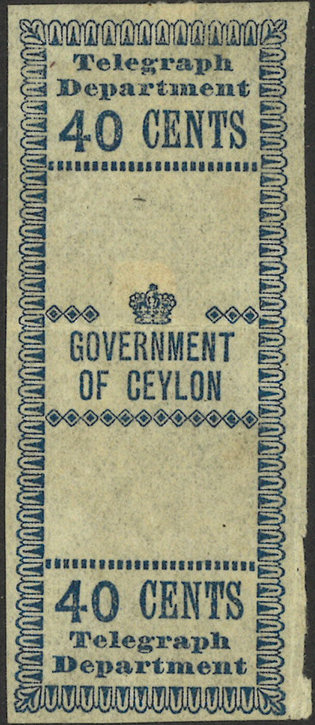 |
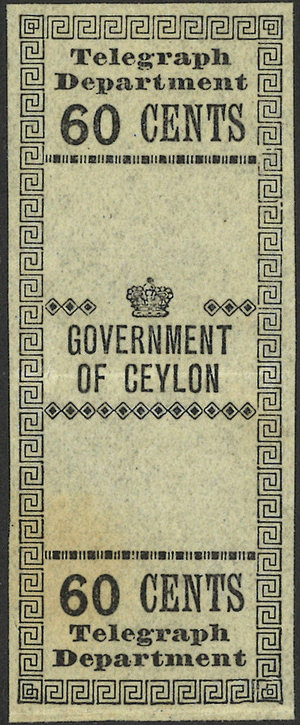 |
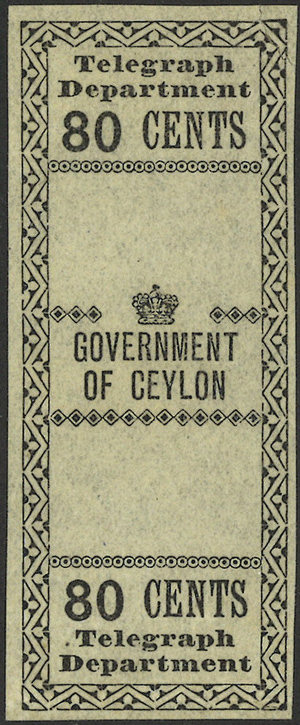 |
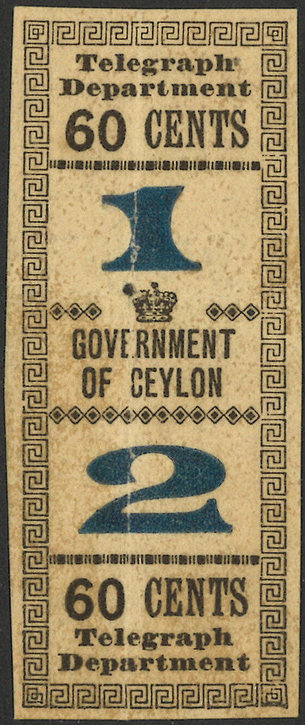 |
| A series of proofs, courtesy of Wimal Suaris. - The broken frame at top-left of the 80c was never corrected ! What were these proofs for again ? | |||
 |
Sheet Layout.
Known standard flaws.
The last 2 digits of the serial number indicate the position within a pane of 50 stamps.
| 20c | ||
| 18 / 68 | 31 / 81 | 36 / 86 |

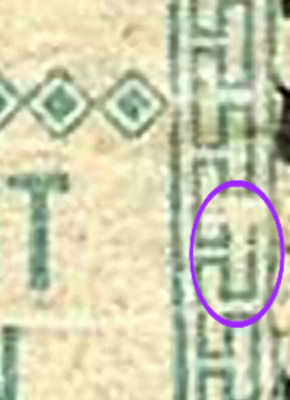 |
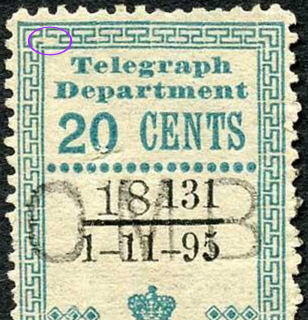  |
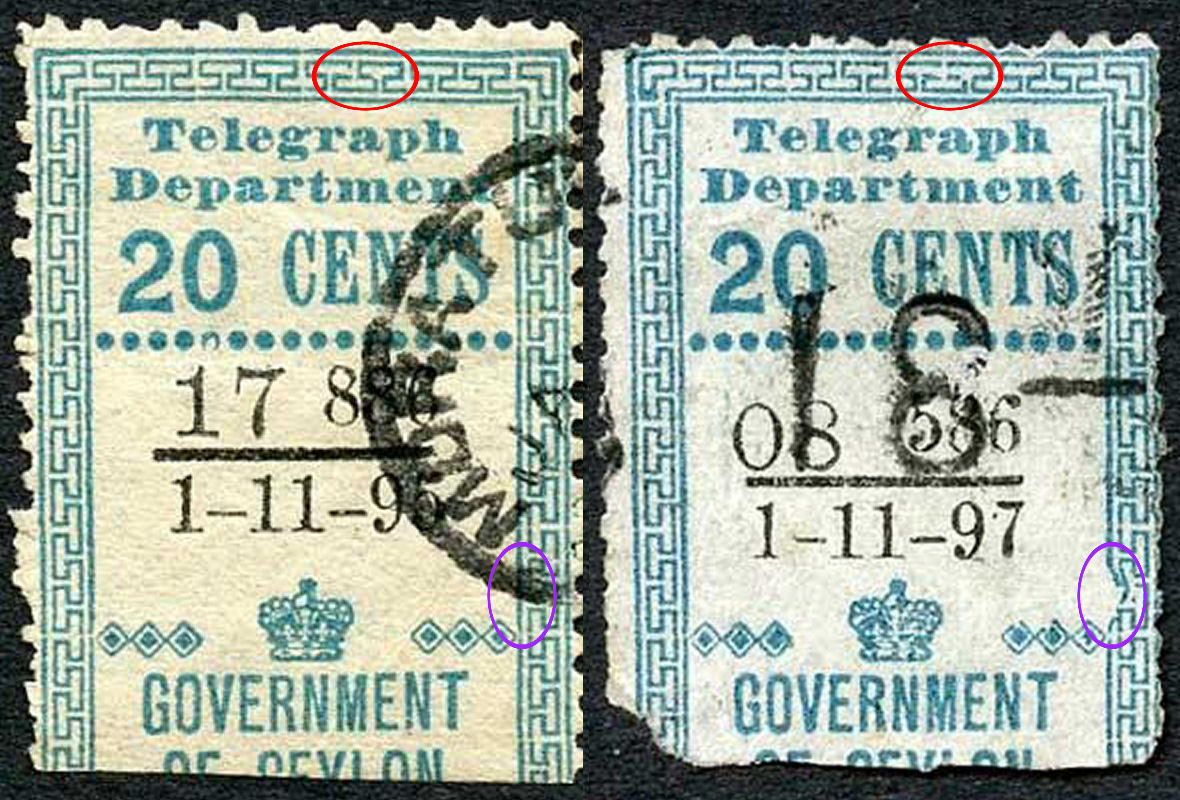 |
| Position 18 has a flaw in the frame to the right of "GOVERNMENT". I have seen it in positions 18 and 68 from 1894 to 1897. Images courtesy of Mark Bloxham. |
Position 31 has a flaw in the top frame on the left. I have seen it in positions 31 and 81 from 1895 to 1901. - Images courtesy of Mark Bloxham. |
In November 1895, position 86 printed reasonably well, apart from something going on in the top frame, marked in red. By November 1897 it had been damaged to the right of the crown. December 1900 shows the same damage at 736 and 186, indicating 50 stamps per plate. December 1901 showed it again at 786. - Images courtesy of Mark Bloxham. |
| 80c | |
| 11 / 61 | 44 / 94 |
 |
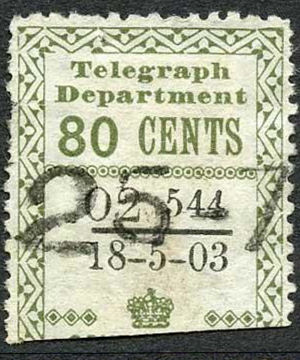 |
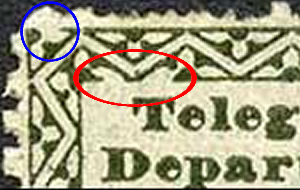 |
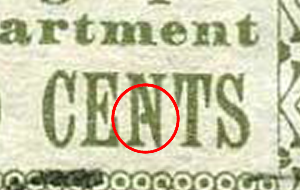 |
| In red is a standard flaw on all of the 80c. The blue flaw is on controls ending in 11 or 61. I have seen it on stamps from 1895 to 1901. Images courtesy of Mark Bloxham. |
The dot on the "N" is on stamps with controls ending with 44 and a few ending with 94. I have seen it on stamps from 1893 to 1903. Images courtesy of Mark Bloxham. |
1 April 1892

April 1892 Specimens from Lot 282 of the Taprobana Collection Auction), with images courtesy of Stanley Gibbons.
| Hisc. | Type | April 1892 Description | Mint | Used |
|---|---|---|---|---|
| H164 | 81 | 20c (10500) (large control figures) cyan | 30.00 | 3.00 |
| H164a | small control figures | 30.00 | 3.00 | |
| H164b | as 164(a) but upper bar extends only over '1/4' (see note) | - | 20.00 | |
| H165 | 82 | 40c (24000) (large control figures) blue | 24.00 | 2.00 |
| H165a | small control figures | 24.00 | 2.00 | |
| H166 | 83 | 60c (10000) (large control figures) dark brown | 30.00 | 3.00 |
| H166a | small control figures | 30.00 | 3.00 | |
| H167 | 84 | 80c (12000) (large control figures) olive | 30.00 | 3.00 |
| H167a | imperf. | 80.00 | 40.00 | |
| H167b | small control figures | 30.00 | 3.00 |
1 May 1892
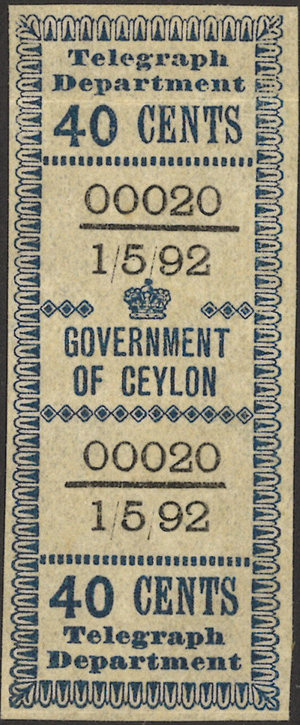 |
 |
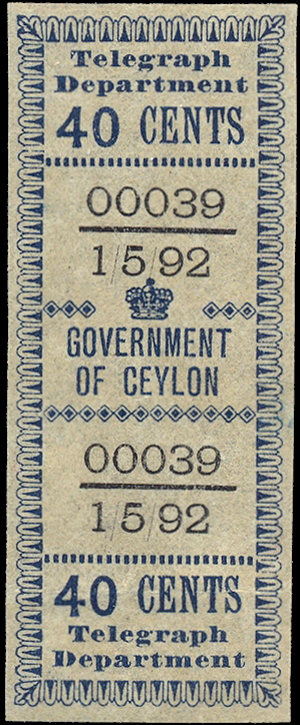 |
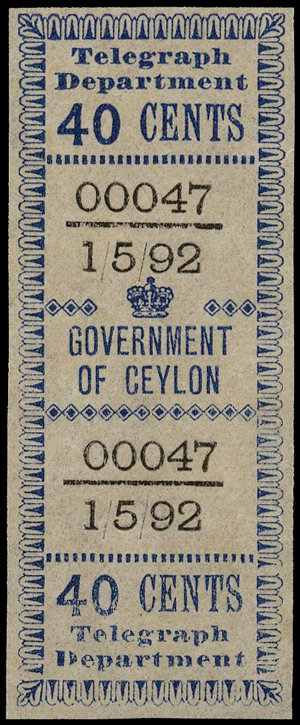 |
 |
| RH168B, courtesy of Wimal Suaris. | RH168B, from Wikimedia Commons. | RH168B, from RL. | Lot 286 of the Taprobana Collection Auction. Image courtesy of Stanley Gibbons. |
H168, courtesy of Grosvenor Auctions. (Sale 113, lot 311) |
These are the only examples that I have seen dated 1 May 1892. Only one matches Hiscocks' description of 80c, the rest are all 40c stamps.
For this date, Hiscocks only listed H168 as being an 80c stamp. It does exist, but the 40c appears to be more common.
If anyone has any other May 1892 examples, I would like to hear from you.
In response to that, I was shown these:
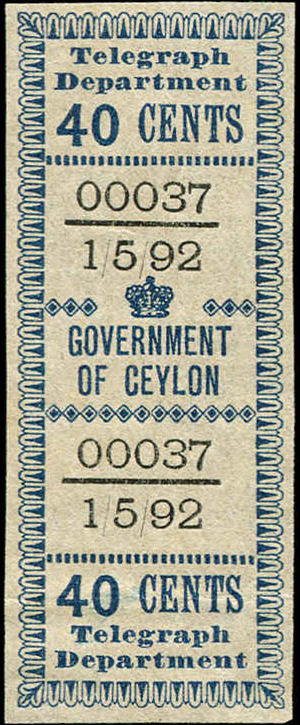
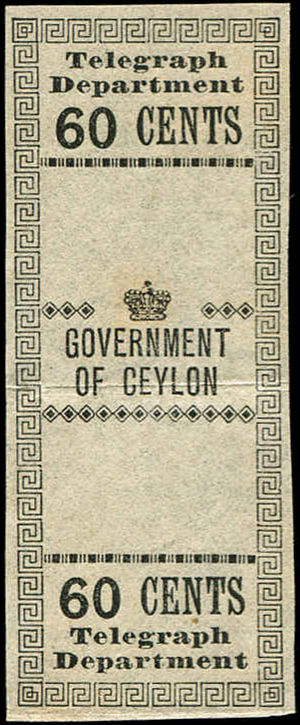
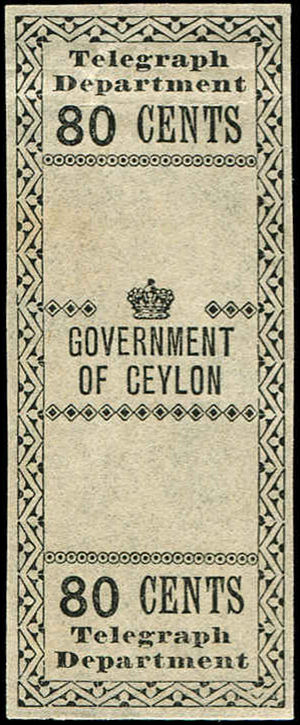
These were listed (lot 1528) in the Phoenix Auction 88 of 26 August 2021. Vendor stated all are ex Ferrari.
Lot 1528 is not listed in the prices realised, but is also marked as no longer available.
| RH # | Hisc. | Type | May 1892 Description | Mint | Used |
|---|---|---|---|---|---|
| †RH168A | - | 81 | 20c cyan, imperf. (may not exist) | - | - |
| *RH168B | - | 84 | 40c blue, imperf. (not issued) | 80.00 | - |
| †RH168C | - | 81 | 60c dark brown, imperf. (may not exist) | - | - |
| RH168 | H168 | 84 | 80c olive, imperf. (not issued) | 100.00 | - |
*
This has been added due to the examples shown.
†
If the 40c and 80c were prepared for issue, it is
highly likely that all values were.
I have therefore added these,
although they may not exist.
1 September 1892. As above. Small control and small date.
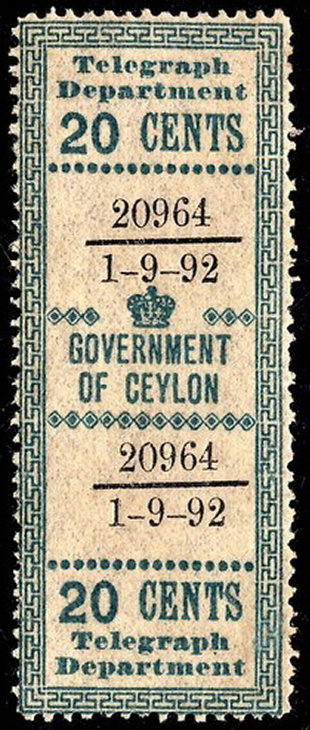 |
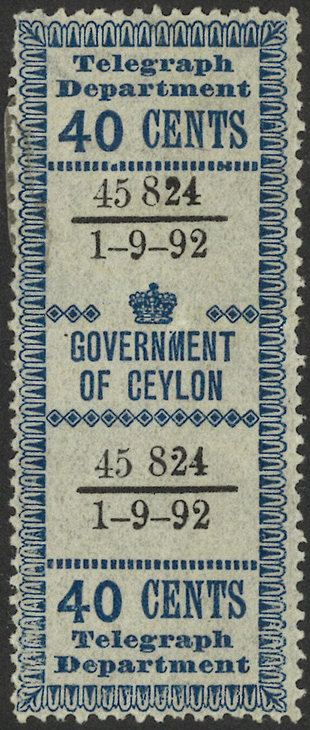 |
 |
 |
| 20c. H169 | 40c. H170 | 60c. H171 | 80c. H172 |
| Image courtesy of (Socrates Antypas). | Image courtesy of Wimal Suaris. | Image courtesy of (Socrates Antypas). | Image courtesy of Wimal Suaris. |
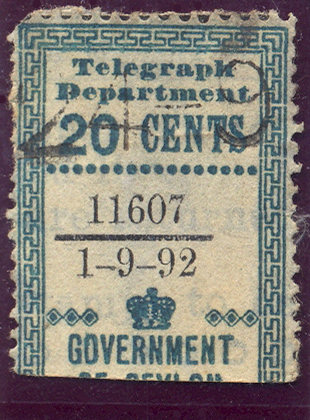 |
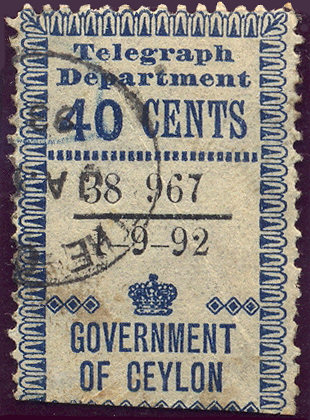 |
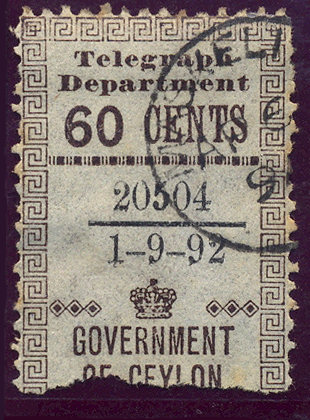 |
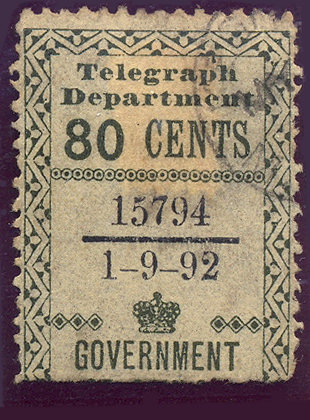 |
| 20c. H169 | 40c. H170 | 60c. H171 | 80c. H172 |
| These images are from RL. | |||
| Hisc. | Type | September 1892 Description | Mint | Used |
|---|---|---|---|---|
| H169 | 81 | 20c (14300) cyan | 30.00 | 3.00 |
| H170 | 82 | 40c (24000) blue | 24.00 | 2.00 |
| H171 | 83 | 60c (12800) dark brown | 30.00 | 3.00 |
| H172 | 84 | 80c (12800) olive | 30.00 | 3.00 |
9 January 1893. As above. Small control and small date.
1 May 1894. As above. Mixed large and small controls and small date.
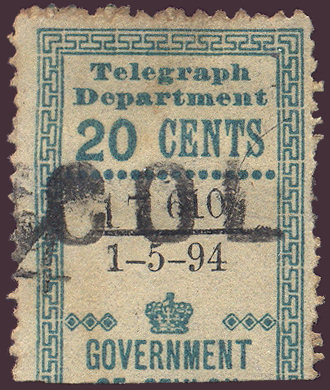 |
 |
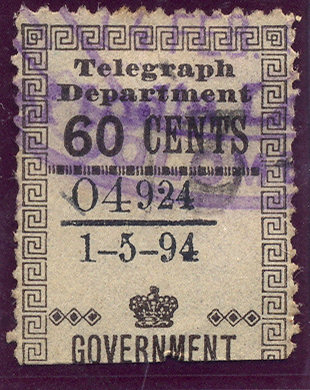 |
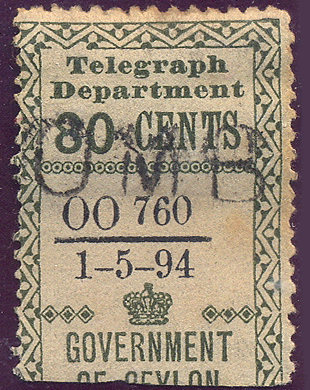 |
| 20c. H177 | 40c. H178 | 60c. H179 | 80c. H180 |
| These images are from RL. | |||
| Hisc. | Type | May 1894 Description | Mint | Used |
|---|---|---|---|---|
| H177 | 81 | 20c (27000) cyan | 24.00 | 2.00 |
| H178 | 82 | 40c (57000) blue | 20.00 | 1.50 |
| H179 | 83 | 60c (5950) dark brown | 50.00 | 5.00 |
| H180 | 84 | 80c (18000) olive | 24.00 | 2.00 |
1 November 1894. As above.
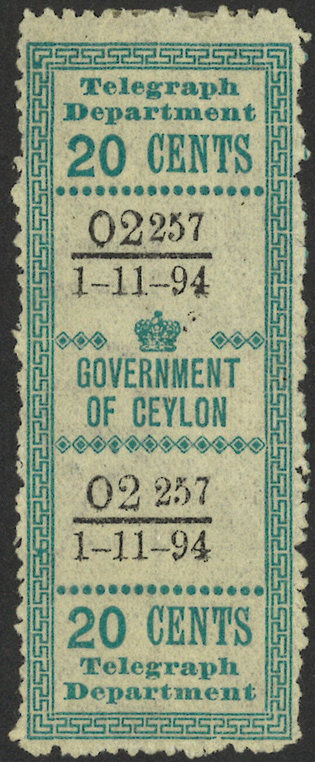 |
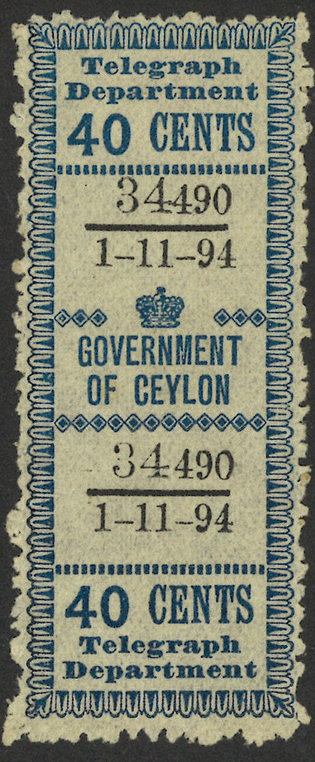 |
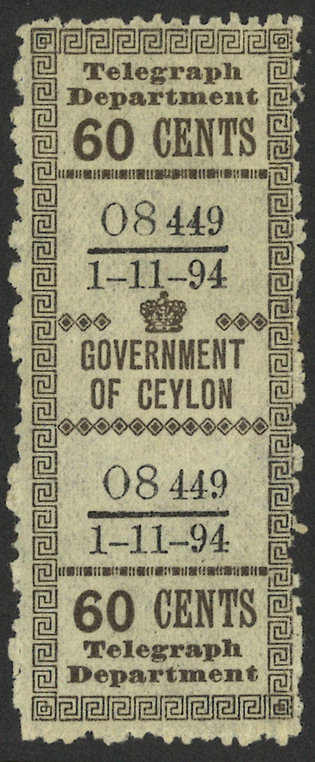 |
| 20c. H181 | 40c. H182 | 60c. H183 |
| These images are courtesy of Wimal Suaris. | ||
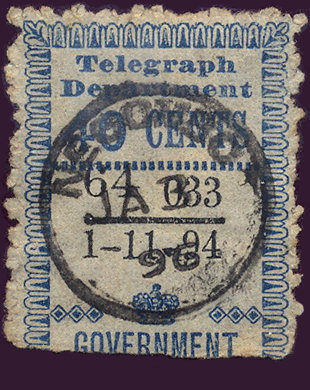 |
 |
 |
| 40c. H182 - from RL | 60c. H183 | 80c. H184 - from RL |
| Hisc. | Type | November 1894 Description | Mint | Used |
|---|---|---|---|---|
| H181 | 81 | 20c (33000) cyan | 20.00 | 2.00 |
| H182 | 82 | 40c (104000) blue | 16.00 | 1.00 |
| H183 | 83 | 60c (14000) dark brown | 24.00 | 2.00 |
| H184 | 84 | 80c (21000) olive | 20.00 | 2.00 |
1 November 1895. As above.
 |
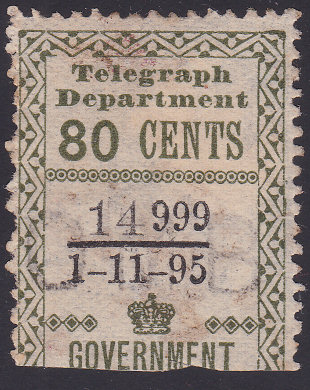 |
| 60c. H187 | 80c. H188 |
| Hisc. | Type | 1895 Description | Mint | Used |
|---|---|---|---|---|
| H185 | 81 | 20c (16000) cyan | 24.00 | 2.00 |
| H186 | 82 | 40c (69000) blue | 16.00 | 1.50 |
| H187 | 83 | 60c (13000) dark brown | 24.00 | 2.00 |
| H188 | 84 | 80c (25000) olive | 20.00 | 2.00 |
Hiscocks added the following note:
| Note. Numbers printed from 1892 to 1895 are from official records. Those from 1896 to 1901 inclusive are estimated from highest control numbers observed and may therefore be on the low side. Information on higher control numbers would be welcome. |
1 September 1896. As above.
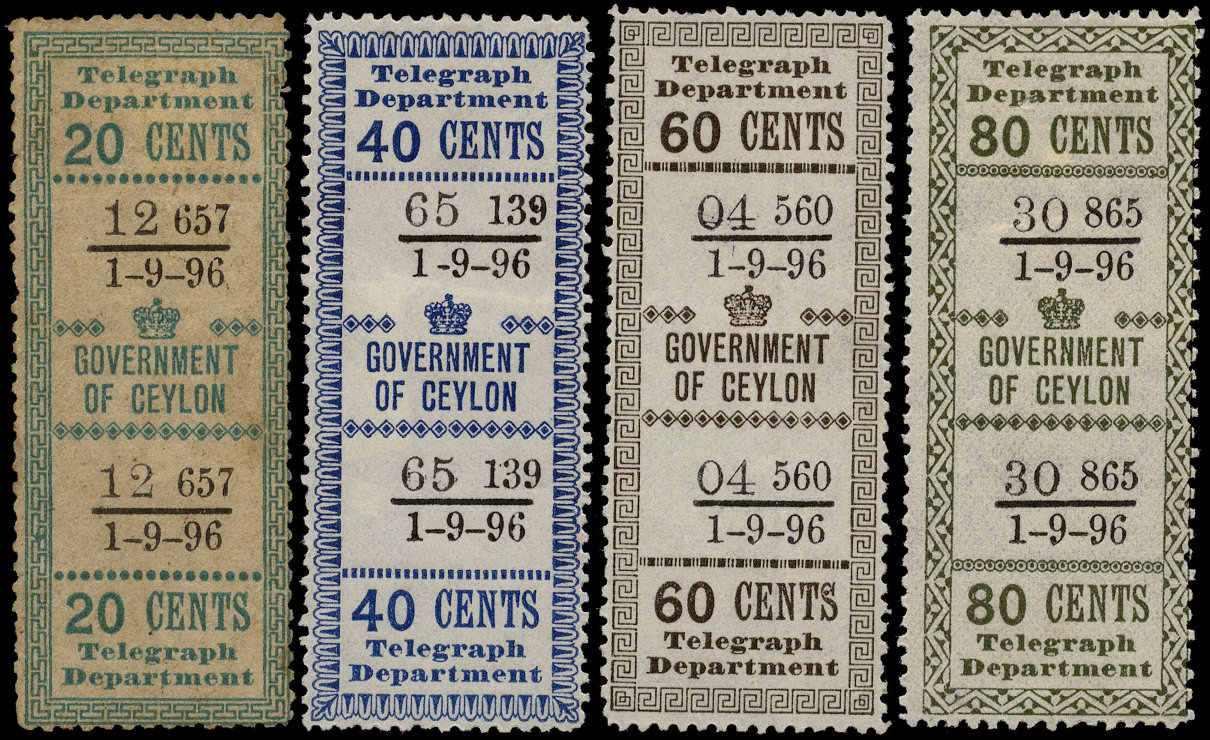 20c, 40c, 60c and 80c. (Lot 326 of the Taprobana Collection Auction). Image courtesy of Stanley Gibbons. |
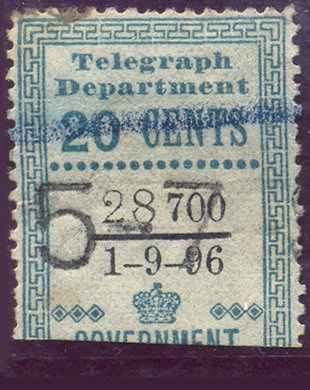 |
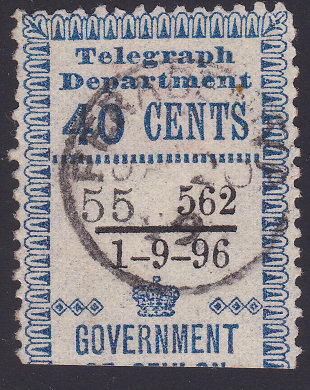 |
 |
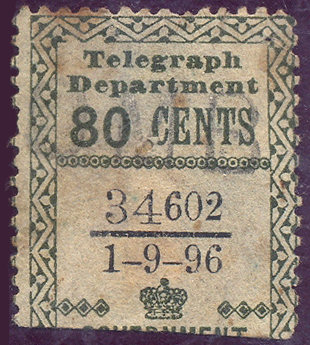 |
| 20c. H189 - from RL | 40c. H190 | 60c. H191 - from RL | 80c. H192 - from RL |
| Hisc. | Type | 1896 Description | Mint | Used |
|---|---|---|---|---|
| H189 | 81 | 20c (31000) cyan | 20.00 | 2.00 |
| H190 | 82 | 40c (150000) blue | 12.00 | 1.00 |
| H191 | 83 | 60c (30000) dark brown | 20.00 | 2.00 |
| H192 | 84 | 80c (45000) olive | 20.00 | 2.00 |
1 April 1897. As above but new values.
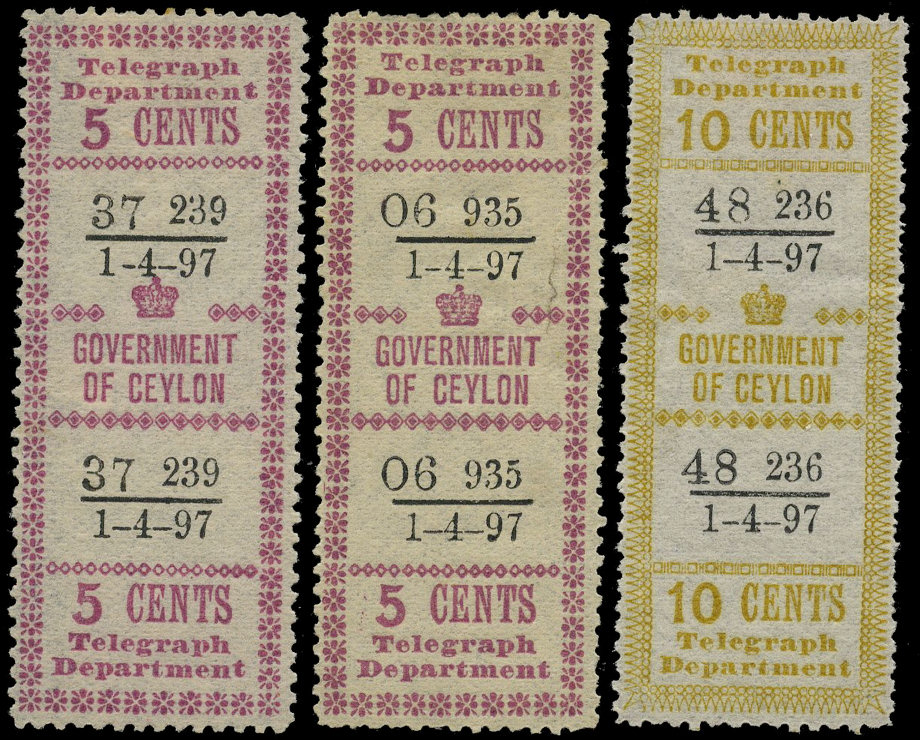 5c Die I then II followed by 10c Die II. (Lot 293 of the Taprobana Collection Auction). Image courtesy of Stanley Gibbons. |
|
||||||||||||||||||||||||||||||||||||||||||||||
Hiscocks added the following 2 notes that I have added illustrations to:
1 November 1897.
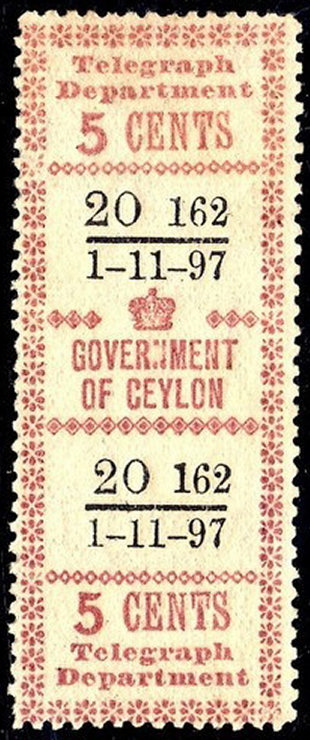 |
 |
| 5c. Die II H195a | 5c. Die II H213a |
| Courtesy of Socrates Antypas (storypost). | 5c Die I, followed by 10c and 20c. (Lot 294 of the Taprobana Collection Auction), courtesy of Stanley Gibbons. |

A receipt of 31 August 1898 from Dickoy to Bogawantalawa with 35c payment (H40 + H196). - From RL.
Most likely it was about tea.
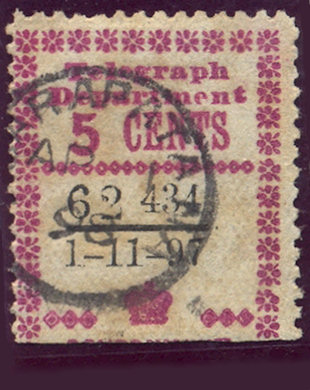 |
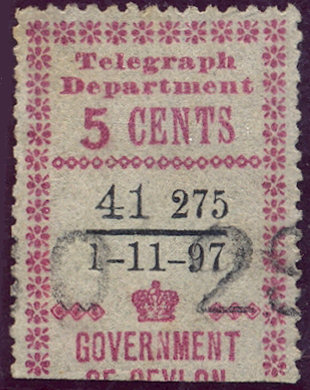 |
 |
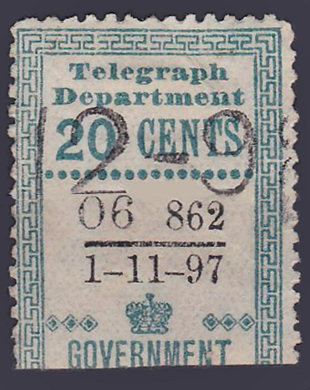 |
| 5c die I, H195 - from RL. | 5c die II, H195a - from RL. | 10c die I, H196 - from RL. | 20c H197 - courtesy of cg.stamps |
Images courtesy of Mark Bloxham.
| RH # | Hisc. | Type | December 1897 Description | Mint | Used | |
|---|---|---|---|---|---|---|
| RH198 | H198 | 87 | 25c Die I | } (46700), deep olive | 50.00 | 3.00 |
| RH198a | - | 25c Die II | 50.00 | 3.00 | ||
| RH198b | - | se-tenant pair | 150.00 | 12.00 | ||
1 July 1898.
 |
| 5c. Die II, 60c and 80c. |
| Lot 296 of the Taprobana Collection Auction), courtesy of Stanley Gibbons. |
 |
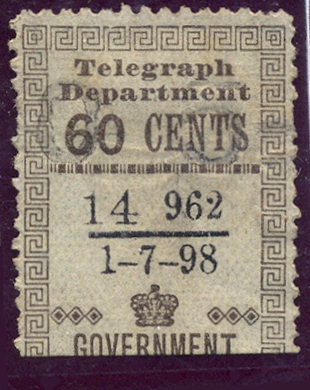 |
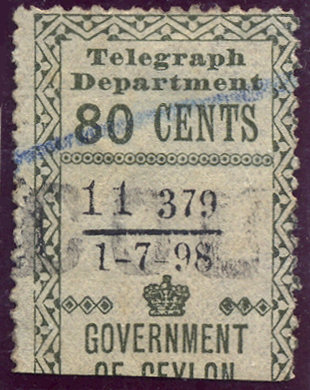 |
| 5c die II, H199a - from RL. | 60c, H200 - from RL. | 80c, H201 - from RL. |
| Hisc. | Type | July 1898 Description | Mint | Used | |
|---|---|---|---|---|---|
| H199 | 85 | 5c Die I | } (16000) lilac-rose | 30.00 | 4.00 |
| H199a | 5c Die II | 30.00 | 4.00 | ||
| H199b | se-tenant pair | 80.00 | 10.00 | ||
| H200 | 83 | 60c (58000) dark brown | 20.00 | 2.00 | |
| H201 | 84 | 80c (16000) olive | 24.00 | 2.00 | |
1 December 1898.
| Hisc. | Type | December 1898 Description | Mint | Used | |
|---|---|---|---|---|---|
| H202 | 85 | 5c Die I | } (40000) lilac-rose | 20.00 | 2.00 |
| H202a | 5c Die II | 20.00 | 2.00 | ||
| H202b | se-tenant pair | 60.00 | 8.00 | ||
| H203 | 86 | 10c Die I | } (47000) yellow | 20.00 | 2.00 |
| H203a | 10c Die II | 20.00 | 2.00 | ||
| H203b | se-tenant pair | 60.00 | 8.00 | ||
| H204 | 81 | 20c (38000) cyan | 20.00 | 2.00 | |
| H205 | 83 | 60c (10000) dark brown | 36.00 | 6.00 | |
| H206 | 84 | 80c (2900) olive | 40.00 | 8.00 | |
1 December 1899.
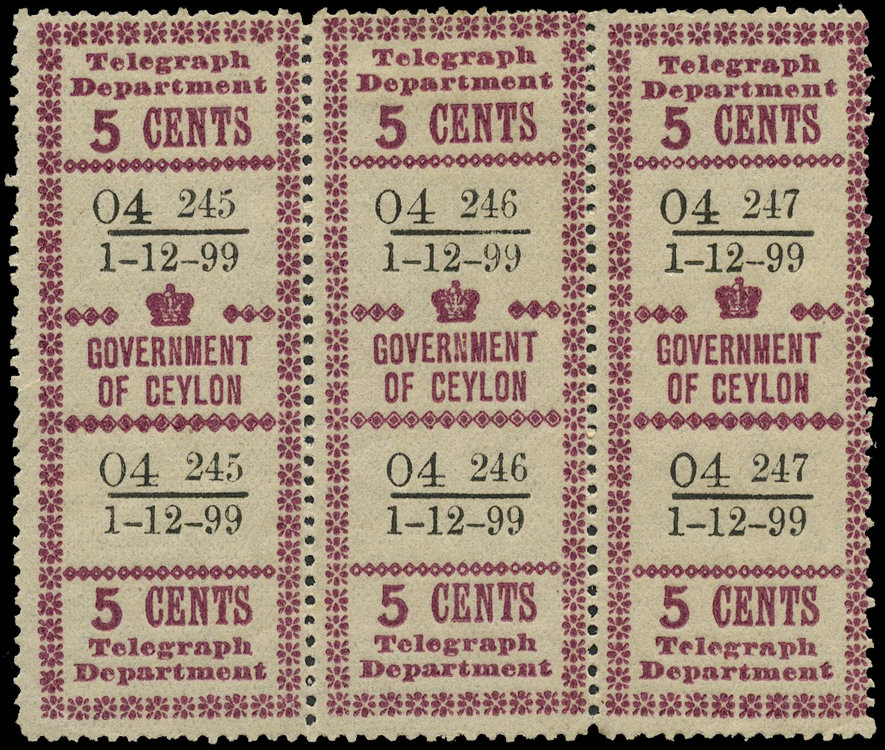 |
 |
| Lot 295 - Two 5c. Die II, followed by a Die I. It would be nice to know the pattern of dies on the sheet. | Part of lot 298 - 20c. |
| Lots of the Taprobana Collection Auction), courtesy of Stanley Gibbons. | |
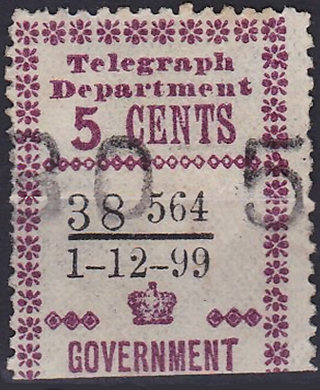 |
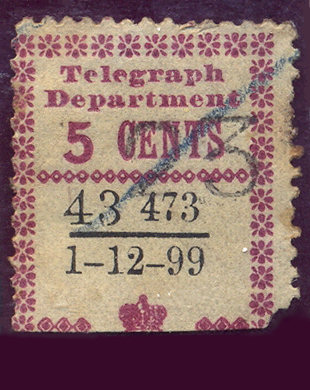 |
 |
| 5c die I H207, Type (85), courtesy of cg.stamps |
5c die II, H207a - from RL. | 10c die II, H208a - from RL. |
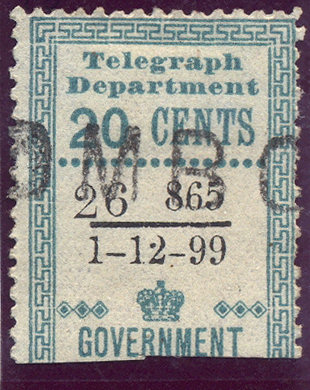 |
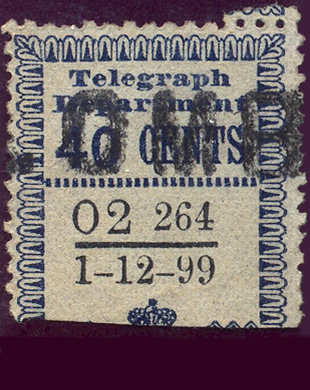 |
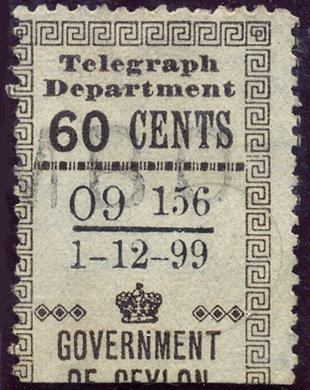 |
 |
| 20c, H209 - from RL. | 40c, H210 - from RL. | 60c, H211 - from RL. | 80c, H212 - from RL. |
| Hisc. | Type | 1899 Description | Mint | Used | |
|---|---|---|---|---|---|
| H207 | 85 | 5c Die I | } (60000) lilac-rose | 16.00 | 1.50 |
| H207a | 5c Die II | 16.00 | 1.50 | ||
| H207b | se-tenant pair | 40.00 | 5.00 | ||
| H208 | 86 | 10c Die I | } (57000) yellow | 16.00 | 1.50 |
| H208a | 10c Die II | 16.00 | 1.50 | ||
| H208b | se-tenant pair | 40.00 | 5.00 | ||
| H209 | 81 | 20c (29000) cyan | 20.00 | 2.00 | |
| H210 | 82 | 40c (10100) blue | 30.00 | 4.00 | |
| H211 | 83 | 60c (9500) dark brown | 30.00 | 4.00 | |
| H212 | 84 | 80c (10100) olive | 30.00 | 4.00 | |
1 December 1900 (new colour for 5c).
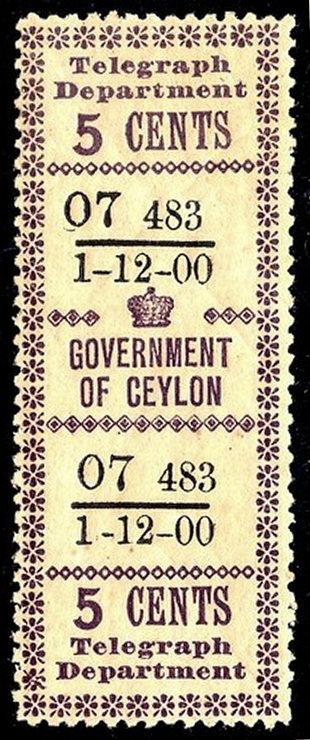 |
 |
| 5c. Die II H213a | 40c from the Taprobana Collection Auction. |
| Courtesy of Socrates Antypas (storypost). | Courtesy of Stanley Gibbons. |
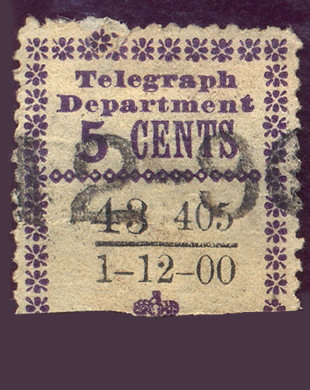 |
 |
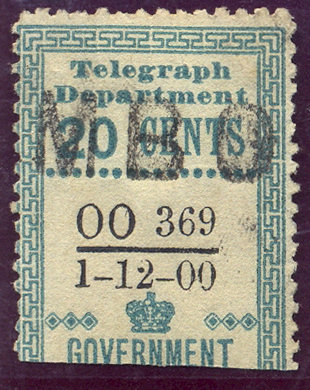 |
| 5c die I, H213 - from RL. | 5c die II, H213a - from RL. | 20c, H215 - from RL. |
 |
 |
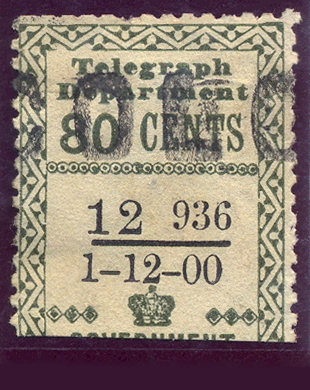 |
| 40c, H216 - from RL. | 60c, H217 - from RL. | 80c, H218 - from RL. |
| Hisc. | Type | 1900 Description | Mint | Used | |
|---|---|---|---|---|---|
| H213 | 85 | 5c Die I | } (58100) deep purple | 8.00 | 1.50 |
| H213a | 5c Die II | 8.00 | 1.50 | ||
| H213b | se-tenant pair | 20.00 | 5.00 | ||
| H214 | 86 | 10c Die I | } (5000) yellow | 20.00 | 6.00 |
| H214a | 10c Die II | 20.00 | 6.00 | ||
| H214b | se-tenant pair | 50.00 | 20.00 | ||
| H215 | 81 | 20c (10000) cyan | 18.00 | 3.00 | |
| H216 | 82 | 40c (18000) blue | 15.00 | 3.00 | |
| H217 | 83 | 60c (14500) dark brown | 18.00 | 3.00 | |
| H218 | 84 | 80c (13000) olive | 15.00 | 3.00 | |
1 December 1901.
 |
| 5c. Die I Die I and Die II, 10c. Die I Die I and Die II. |
| Lot 308 of the Taprobana Collection Auction), courtesy of Stanley Gibbons. |
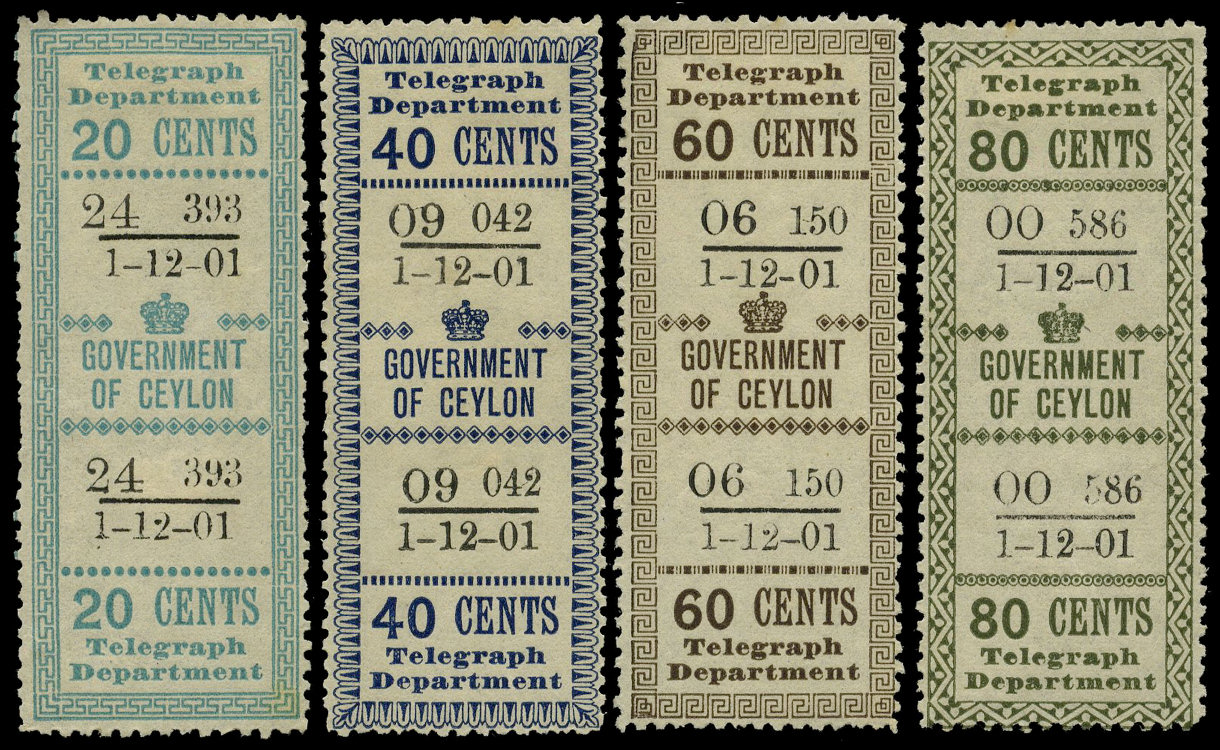 |
| 520c, 40c, 60c and 80c. |
| Part of lot 305 of the Taprobana Collection Auction), courtesy of Stanley Gibbons. |
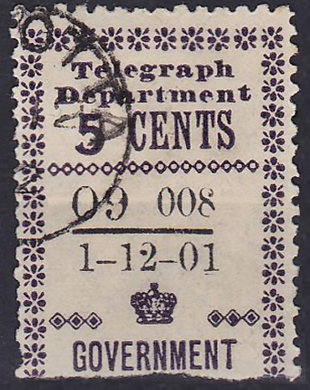 |
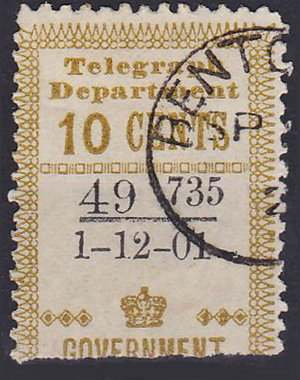 |
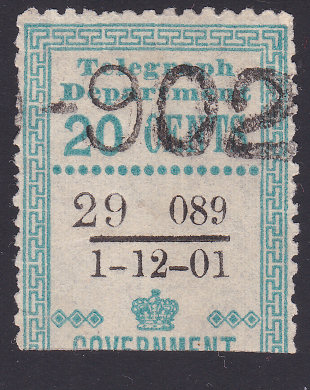 |
| 5c deep purple from 1900, H219 (Die I), courtesy of cg.stamps |
10c, H220a (Die II) courtesy of cg.stamps |
20c, H221 |
 |
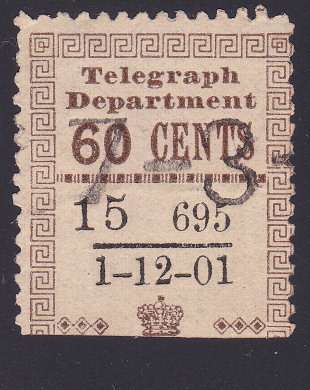 |
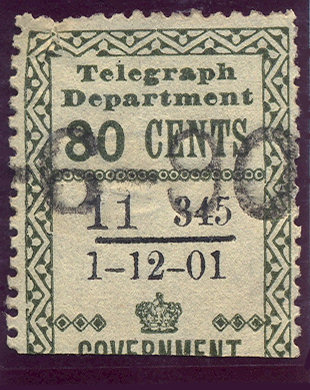 |
| 40c, H222 - from RL. | 60c, H223 | 80c, H224 - from RL. |
| Hisc. | Type | 1901 Description | Mint | Used | |
|---|---|---|---|---|---|
| H219 | 85 | 5c Die I | } (60000) deep purple | 20.00 | 2.00 |
| H219a | 5c Die II | 20.00 | 2.00 | ||
| H219b | se-tenant pair | 60.00 | 8.00 | ||
| H220 | 86 | 10c Die I | } (51000) yellow | 16.00 | 2.00 |
| H220a | 10c Die II | 16.00 | 2.00 | ||
| H220b | se-tenant pair | 40.00 | 8.00 | ||
| H221 | 81 | 20c (33000) cyan | 24.00 | 3.00 | |
| H222 | 82 | 40c (16000) blue | 30.00 | 4.00 | |
| H223 | 83 | 60c (16000) dark brown | 30.00 | 4.00 | |
| H224 | 84 | 80c (16500) olive | 30.00 | 4.00 | |
1 December 1902.
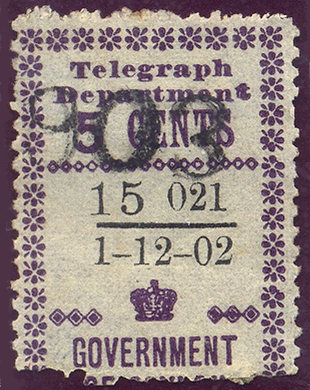 |
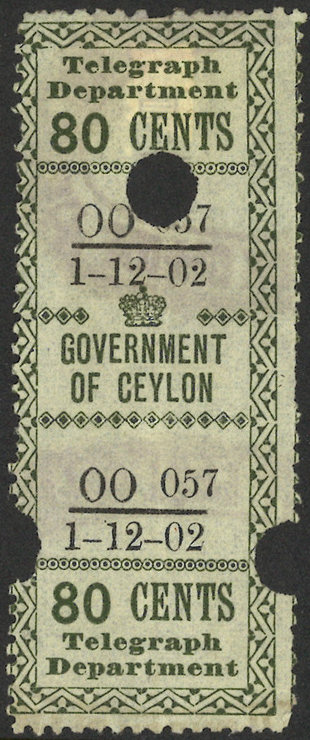 |
| 5c, Die I, H225 | 80c. H227 complete used. |
| Courtesy of Rolf Lamprecht. | Courtesy of Wimal Suaris. |
| Hisc. | Type | 1902 Description | Mint | Used | |
|---|---|---|---|---|---|
| H225 | 85 | 5c Die I | } (29000) deep purple | 20.00 | 2.00 |
| H225a | 5c Die II | 20.00 | 2.00 | ||
| H225b | se-tenant pair | 60.00 | 8.00 | ||
| H226 | 83 | 60c (9000) dark brown | 36.00 | 4.00 | |
| H227 | 84 | 80c (10000) olive | 30.00 | 4.00 | |
Hiscocks added the following note:
| Note. This printing was on very thin paper. |
18 May 1903. Printed on bluish paper.
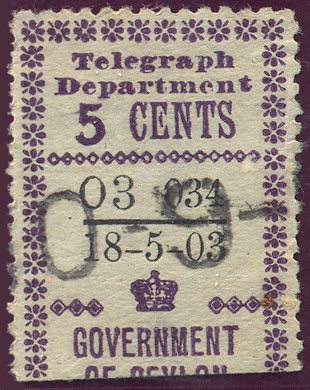 |
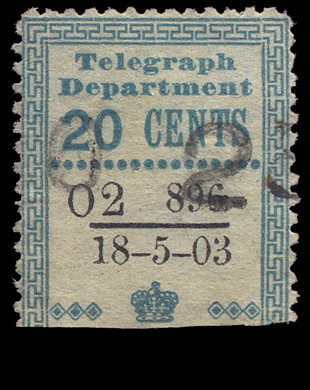 |
 |
| 5c, Die I, H228 - from RL. | 20c, H230 - from RL. | 80c olive H233, courtesy of ibredguy.co.uk |
| Hisc. | Type | 1903 Description | Mint | Used | |
|---|---|---|---|---|---|
| H228 | 85 | 5c Die I | } (5450) deep purple | 40.00 | 6.00 |
| H228a | 5c Die II | 40.00 | 6.00 | ||
| H228b | se-tenant pair | 100.00 | 20.00 | ||
| H229 | 86 | 10c Die I | } (5100) yellow | 40.00 | 6.00 |
| H229a | 10c Die II | 40.00 | 6.00 | ||
| H229b | se-tenant pair | 100.00 | 20.00 | ||
| H230 | 81 | 20c (5400) cyan | 40.00 | 6.00 | |
| H231 | 82 | 40c (5800) blue | 40.00 | 6.00 | |
| H232 | 83 | 60c (5100) dark brown | 40.00 | 6.00 | |
| H233 | 84 | 80c (5200) olive | 40.00 | 6.00 | |
King Edward VII 'double-headed'
1903. New design. King Edward VII. Watermark W2. Perf. 14
Main colour given first, tablet colour second.
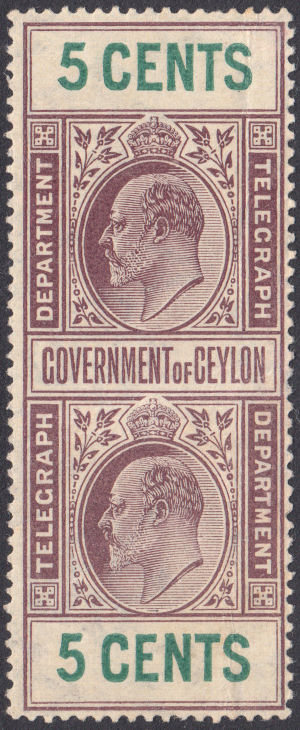 |
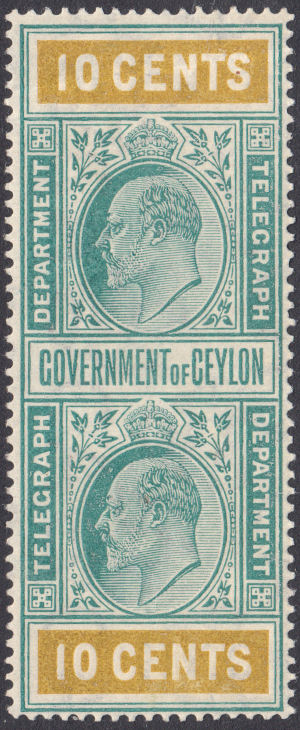 |
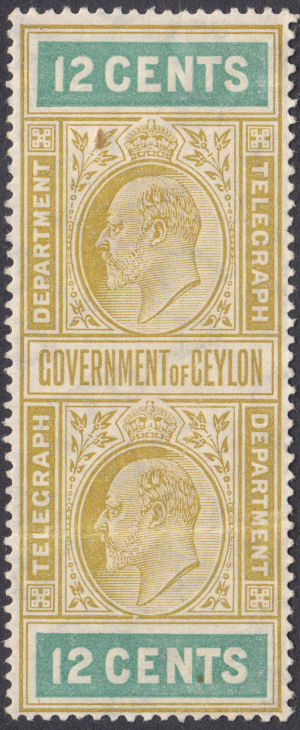 |
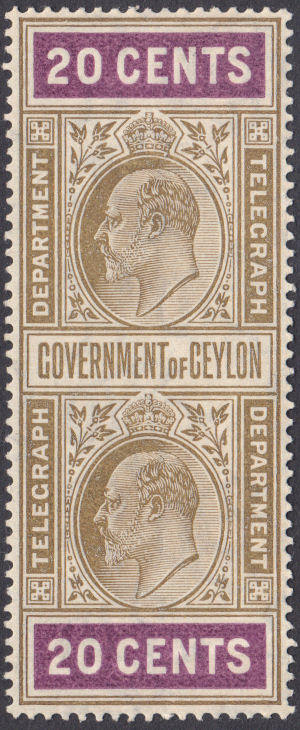 |
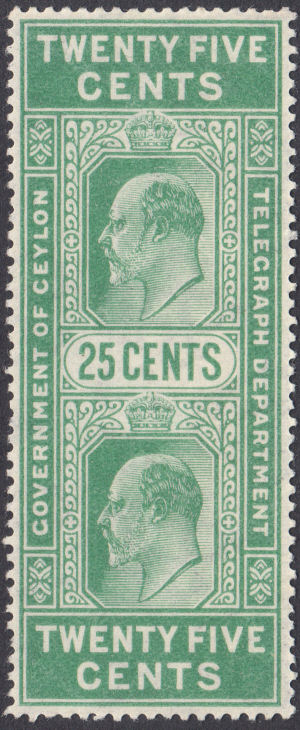 |
| 5c. H234 / H249 - Type 88 | 10c. H235 / H250 - Type 88 | 12c. H236 / H251 - Type 88 | 20c. H237 / H252 - Type 88 | 25c. H238 / H253 - Type 88 |
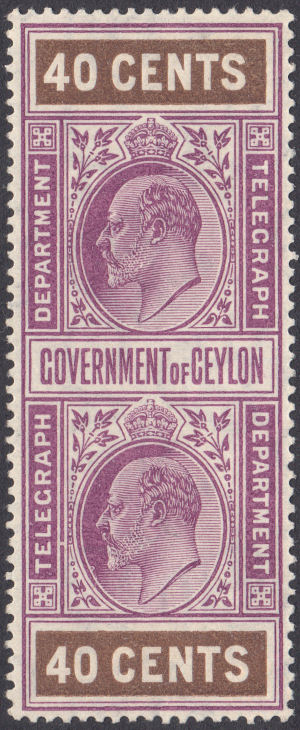 |
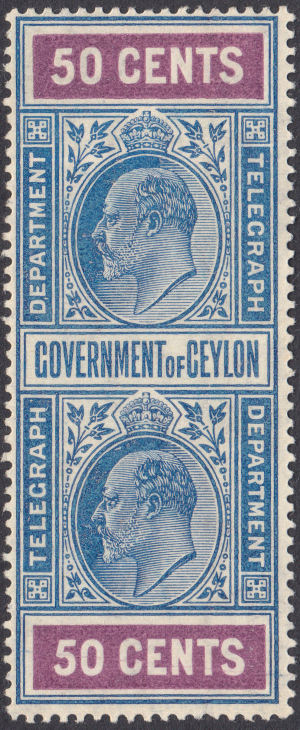 |
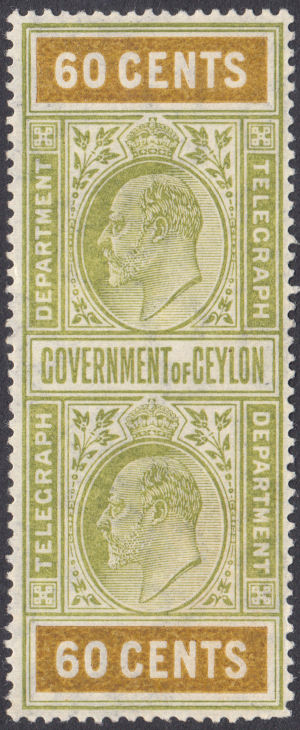 |
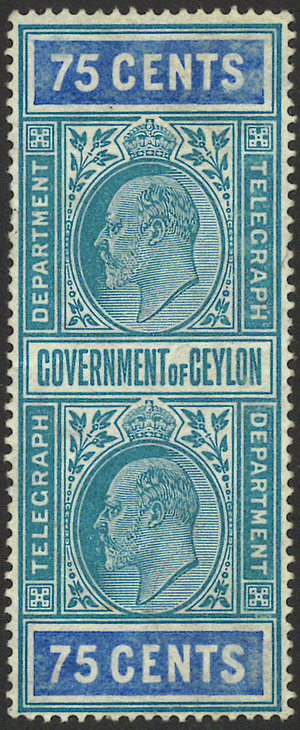 |
 |
| 40c. H239 / H254 - Type 88 | 50c. H240 / H255 - Type 88 | 60c. H241 / H256 - Type 88 | 75c. H242 / H257 - Type 88, courtesy of Wimal Suaris. |
1R. H243 / H258 - Type 88, courtesy of Wimal Suaris. |
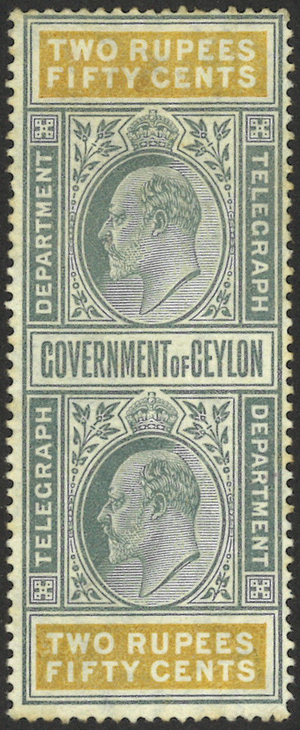 |
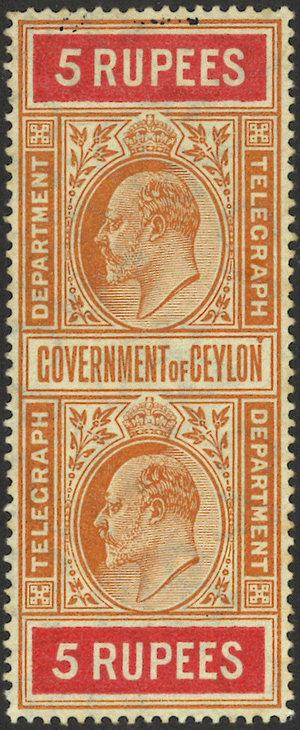 |
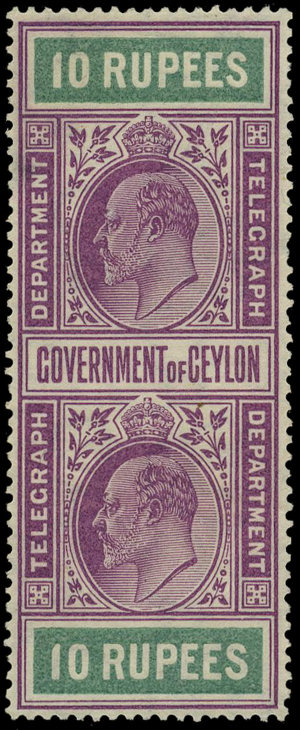 |
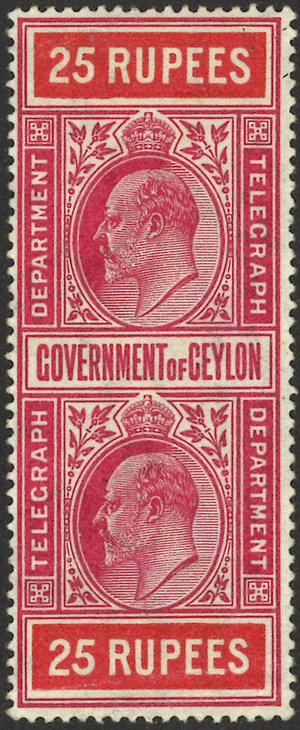 |
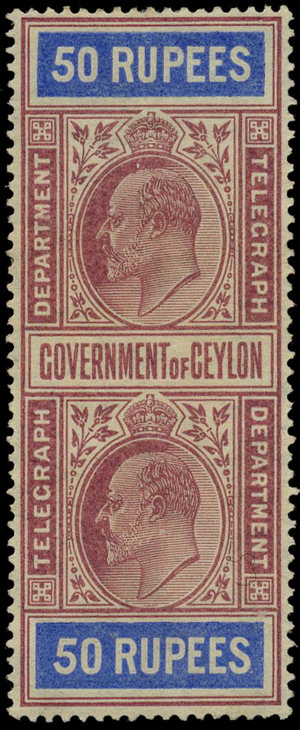 |
| 2R.50c. H244 / H259 - Type 88, courtesy of Wimal Suaris. |
5R. H245 / H260 - Type 88, courtesy of Wimal Suaris. |
Lot 374 of the Taprobana Collection Auction), 10R. H263 - courtesy of Stanley Gibbons. |
25R. H247 / H262 - Type 88, courtesy of Wimal Suaris. |
Lot 374 of the Taprobana Collection Auction), 50R. H263 - courtesy of Stanley Gibbons. |
Complete used examples.
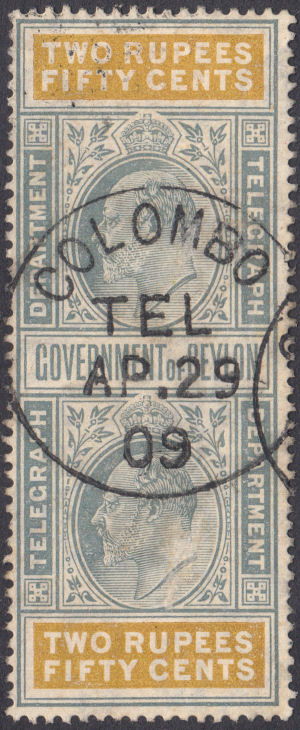 |
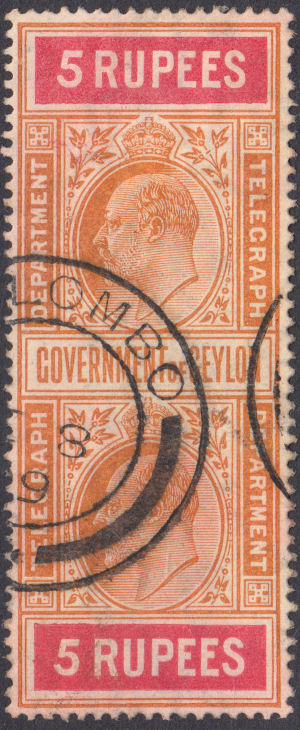 |
 |
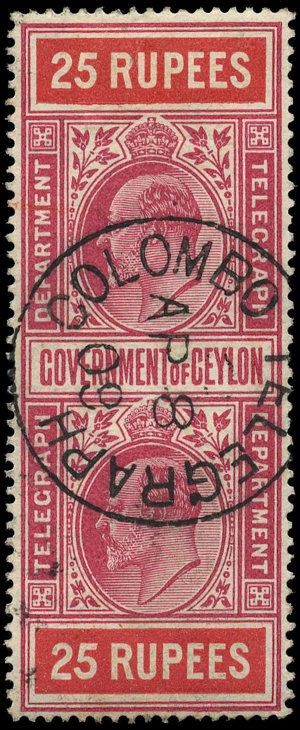 |
| 2R50c. H259 - Type 88 | 5R. H260 - Type 88 | 10R. H261 - Type 88 from RL. |
Lot 329 of the Taprobana Collection Auction), 25R. H262 - courtesy of Stanley Gibbons. |
| Hisc. | Type | Description | Mint | Used |
|---|---|---|---|---|
| H234 | 88 | 5c brown & green (1903) (122720) | 25.00 | 4.00 |
| H235 | 88 | 10c bluish green & ochre (1903) (80480) | 30.00 | 4.00 |
| H236 | 88 | 12c olive-bistre & green (1904) (12160) | 100.00 | 12.00 |
| H237 | 88 | 20c drab & purple (1903) (122720) | 75.00 | 6.00 |
| H238 | 89 | 25c green (1904) (329120) | 40.00 | 3.00 |
| H239 | 88 | 40c purple & brown (1903) (40400) | 75.00 | 6.00 |
| H240 | 88 | 50c blue & purple (1904) (48000) | 75.00 | 6.00 |
| H241 | 88 | 60c olive & ochre (1903) (32160) | 90.00 | 6.00 |
| H242 | 88 | 75c pale blue & blue (1903) (39040) | 90.00 | 6.00 |
| H243 | 88 | 1R red-brown (1904) (73120) | 60.00 | 5.00 |
| H244 | 88 | 2½R slate & ochre (1904) (24320) | 90.00 | 6.00 |
| H245 | 88 | 5R orange & carmine (1904) (20160) | 90.00 | 6.00 |
| H246 | 88 | 10R reddish purple & green (1904) (16000) | 200.00 | 12.00 |
| H247 | 88 | 25R carmine & scarlet (1904) (3200) | 900.00 | 32.00 |
| H248 | 88 | 50R claret & blue (1904) (1200) | 1200.00 | 60.00 |
Hiscocks added the following 3 notes:
| Note 1. There were two main dies — 25c and the rest. In all cases above the second colour given is that of the value tablet. |
| Note 2. Those given as 1903 were received in Ceylon in June of that year and presumably released soon after. Those given as 1904 were received in December 1903 but it has been assumed that the usual practice was followed and that these were therefore issued early in 1904. |
| Note 3. The direct sale of mint telegraph stamps to the public was not allowed at this time, which accounts for their rarity. It is not known when this rule came into effect but it was apparently allowed to lapse before the termination of the next and last issue in 1910. There was however some leakage of bottom halves, cancelled by the punching of two or three holes, from the checking office — price 2-3 times used. The occasional whole used stamp is met with — usually a case of late use: price as for mint. |
1905. As above but watermark Multiple CA and Crown (W3).
|
Hiscocks added the following 2 notes:
| Note 1. In their later years these stamps were quite commonly used whole and the centre column of prices above refers to them so used. |
| Note 2. No printings are available for the 1905 issue but from the large numbers I have examined it seems likely that printings of Nos. 262 and 263 were, as usual, much lower than for lower values. |
1910 Provisionals
1910. Provisional issue. Surcharges on Nos. 251, 253 and 258.
No genuine used examples are known, so probably never issued.
A set of Specimens.
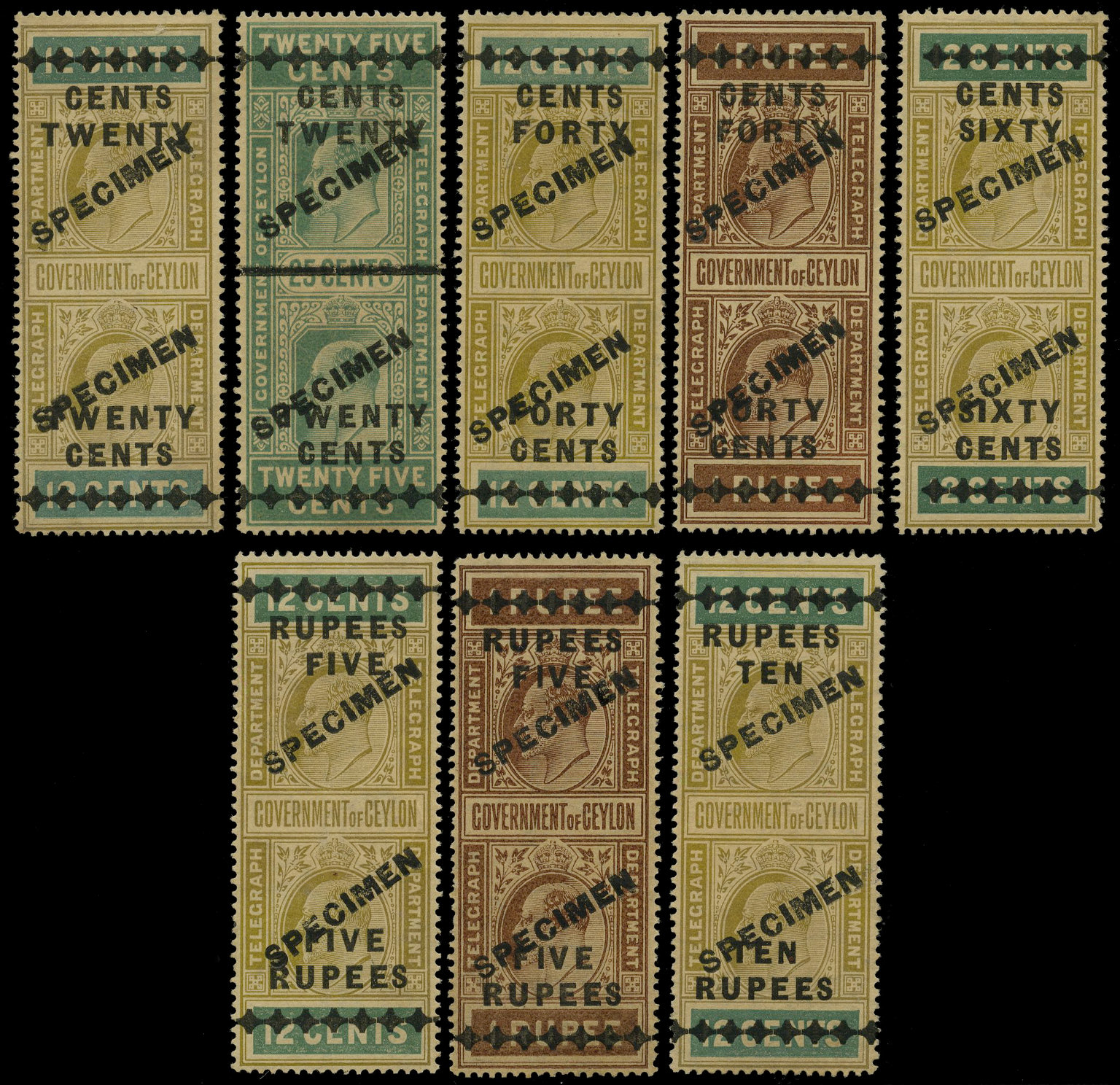
This is the set of Specimens that Steve Hiscocks referred to in notes in his book.
From lot 385 of the Taprobana Collection Auction). Image courtesy of Stanley Gibbons.
A Non-Specimen Set.

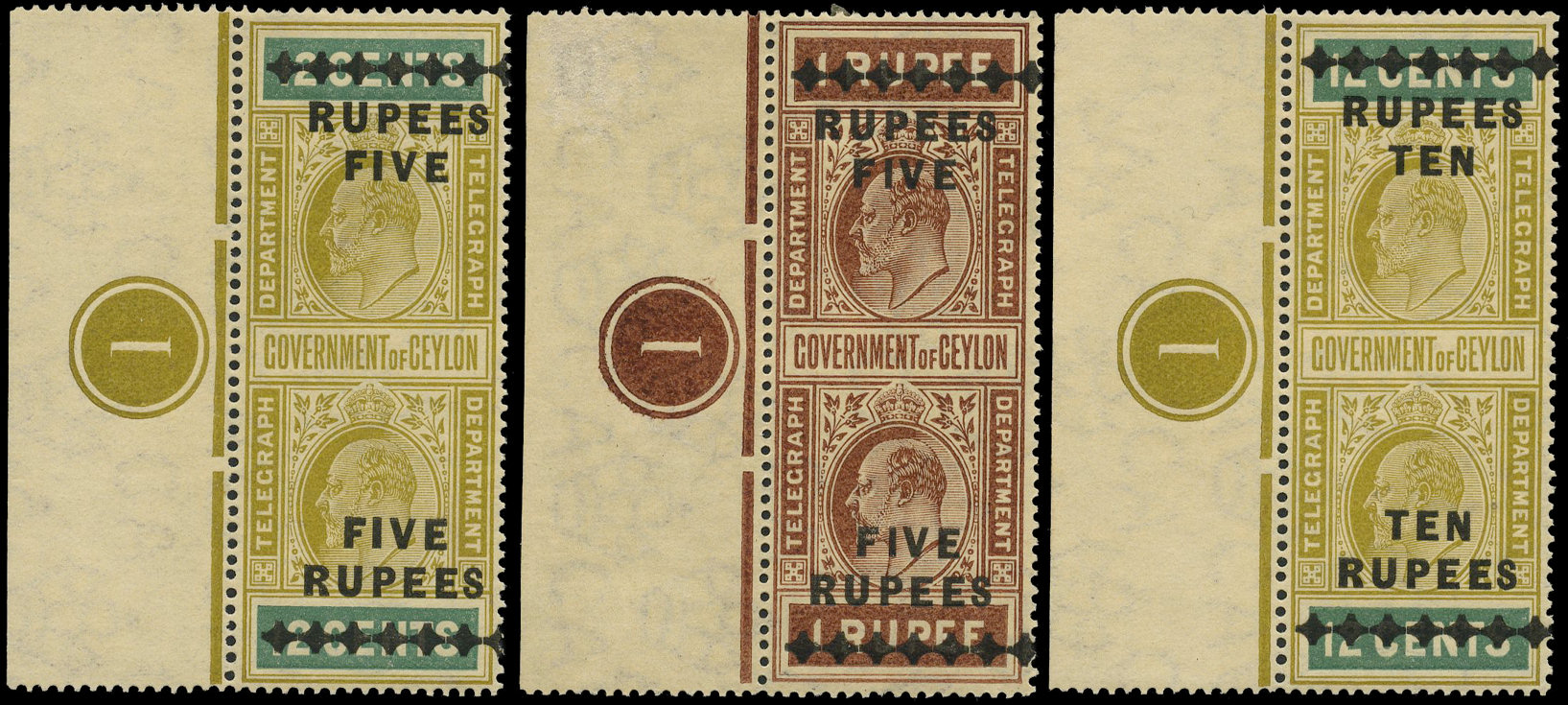
Non- Specimens from lots 388 (top) and 386 (bottom) of the Taprobana Collection Auction).
Images courtesy of Stanley Gibbons.
My Note: Throughout the extensive provisionals of the Victorian era, the overprinted value was never higher than the base stamp being overprinted.
To do so would be an invitation to forgers seeking to defraud the Post and Telegraph department.
All but two of this set would have invited contemporary forgers, let alone later ones that only defrauded collectors.
I suspect that was part of the reason for them not being issued. India had stopped using Telegraph stamps in 1908, that is probably the rest of the reason.
Here are examples of the forgeries mentioned in Hiscocks notes above.
Note 3(c) Courtesy of Nicholas Turner , (capital-collectables) on eBay |
Note 3(d)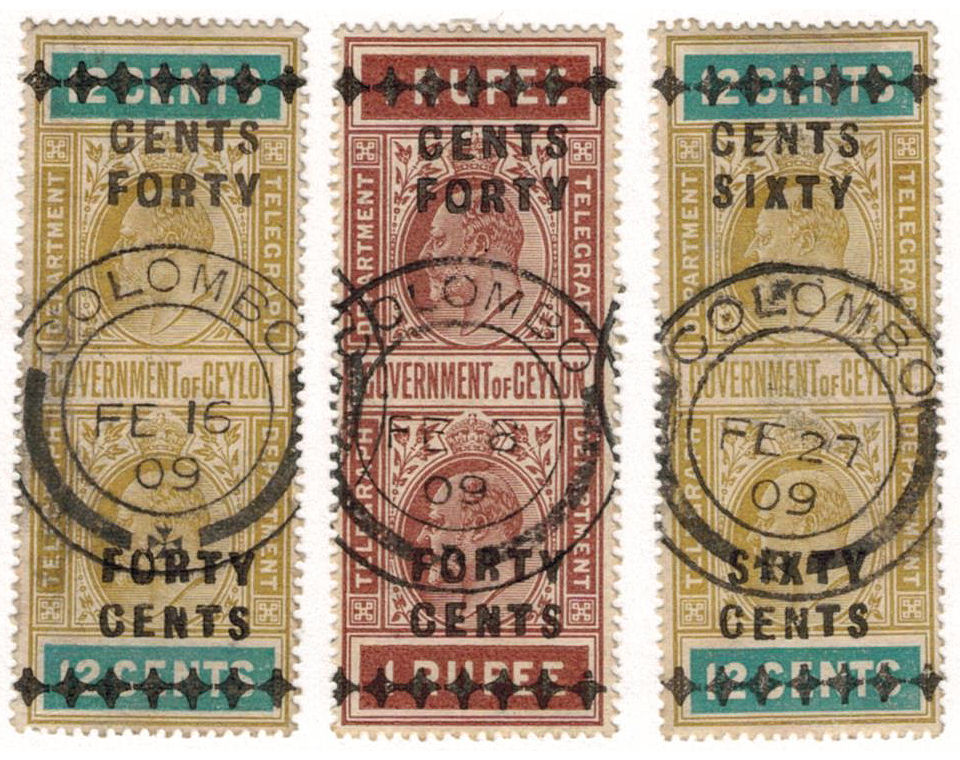 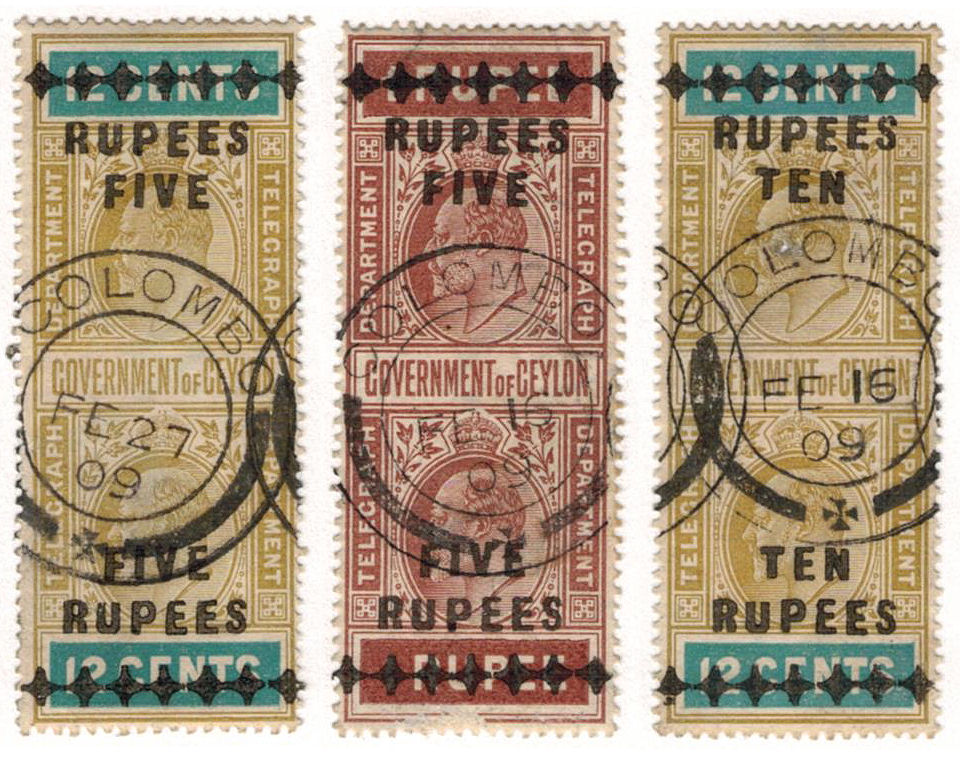 Courtesy of Gerard Bissett. |
Here is a comparison with a (stated to be) genuine overprint second from the top.
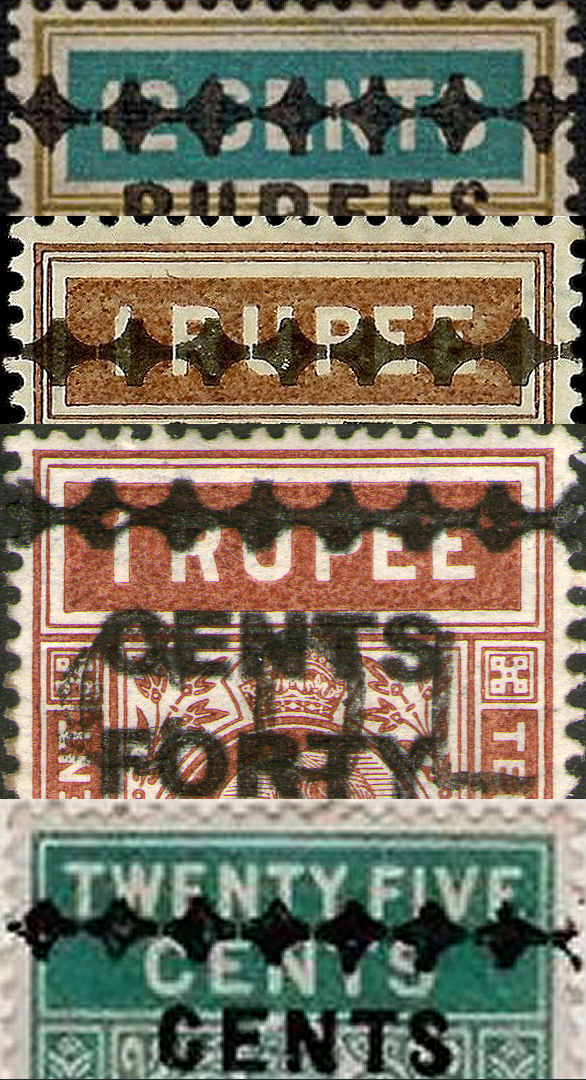
The forged H269 (5R on 12c) is shown above and a different forgery I have of H267 (40c on 1R) is shown below.
The one below has very rounded 'C' of 'CENTS and 'O' of 'FORTY'. Diamond sizes: 3mm x 10mm (Note.3b ?).
I have added an example of the H265 forgery (Note 3c) at the bottom.
Afterwards
Here is a selection of later stamps from 1957 to 1971 with various telegraph cancels:
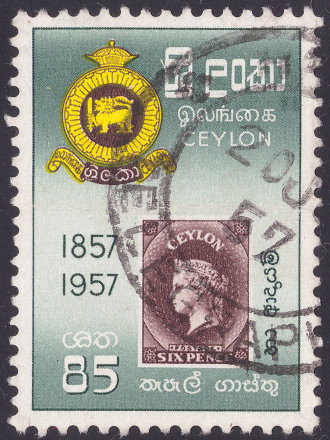
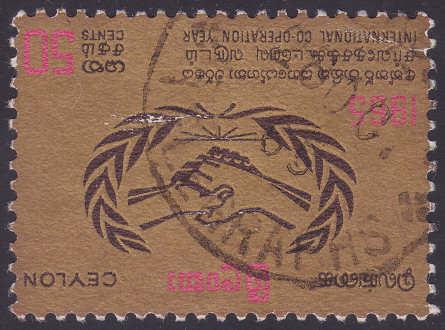
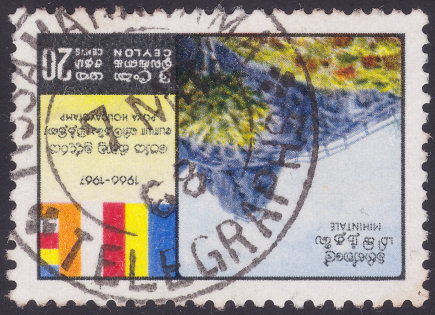

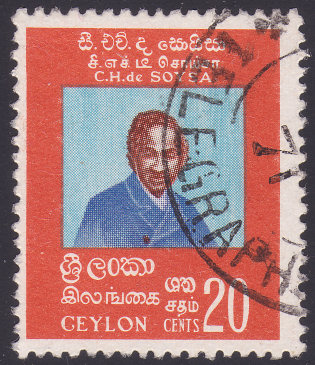
It should be noted though, that telegraph and post offices were often combined and telegraph cancels could be applied to non-telegraphic mail.
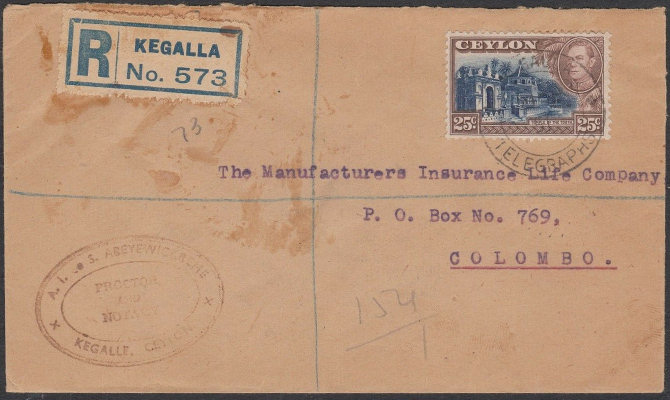
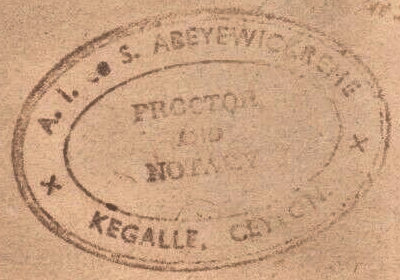
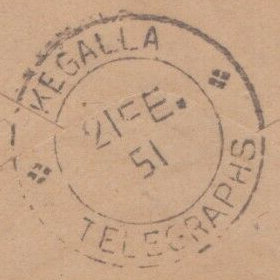
This registered envelope of 1951 has a Telegraph cancel of Kegalla and was mailed to an Insurance Company in Colombo.
It might be thought that Kegalla received a telegram for Colombo and mailed it on, but Colombo had the telegraph for many decades by then.
Additionally, the enhanced cachet on the front shows it was mailed by a "Proctor and Notary", not the telegraph office.
It presumably contained documents required by the Insurance Company. The backstamp is also shown.
Images courtesy of wendiwoo-2008.
Stationery
Much of the early stationery used in Ceylon was that of India and will be found under India Stationery.
This section is for specifically stationery of Ceylon.
| I know little about these, so this is a list of images shown here | ||||
| My Ref. | Form No. | PO imprint | Date used | Comment |
|---|---|---|---|---|
| Cey_B5 | Traffic Code Form B. | "Post Office B.—5." | 17 June 1893 | with 5c Postage stamp, for Foreign Telegrams - from London |
| Cey_B5R4 | - | "Post Office — B 5 / (R 4*)" | 11 January 1905 | for Foreign Telegrams |
| Cey_B6 | Traffic Code Form B. | "Post Office B.—6." | 27 December 1894 | for Foreign Telegrams - from London |
| Cey_B7M6 | ? | "Post Office B 7 (M6*) ." | April 1894 | for Inland or Indo-Ceylon Messages |
| Cey_B7L4 | - | "Post Office B 7 (L4*) . " | 4 March 1899 | for Inland or Indo-Ceylon Messages |
| Cey_B7L4_unused | - | "Post Office B 7 (L4*) . " | - | for Inland or Indo-Ceylon Messages - UNUSED |
| Cey_B127-57 | A | "Post Office B 127 (44-21*) 8/57 " | - | for Inland or Indian Telegrams - UNUSED |
| Cey_B3X8 | - | "Post Office B 3 (X 8)." | 30 June 1899 | "Post Office Telegraphs" |
| Cey_B3X8_1905 | - | "Post Office B 3 (X 8) / [June, 1905.] " | 11 July 1907 | "Post Office Telegraphs" |
Sending Forms / Receipts.
Ceylon Government Telegraph form with a 5c postage stamp. MyRef: Cey_B5

This "Traffic Code Form B." was used in Galle on 17 June 1893. It has a boxed "Post Office B.—5." at top-right.
Image courtesy of Wimal Suaris. I would be really interested to hear about others with postage stamps.
Ceylon Government Telegraph - for Foreign. MyRef: Cey_B5R4

This was used in Colombo in January 1905. It has "Post Office — B 5 / (R 4*)" at top-right, but nothing at top-left.
This is a wide form and it looks like the perforations were not trusted when a lot of stamps were on there.
From lot 384 of the Taprobana Collection Auction). Image courtesy of Stanley Gibbons.
Ceylon Government Telegraph. MyRef: Cey_B6

This "Traffic Code Form B." was used in Colombo in December 1894. It has a boxed "Post Office B.—6." at top-right.
From lot 104 of the Taprobana Collection Auction). Image courtesy of Stanley Gibbons. Lot 394 included another dated November 1887.
MyRef: Cey_B7M6

This was used in April 1894 and has a "PAID" mark of the C.M.Bank, so probably Colombo. It has "Post Office B 7 (M6*) . " at top-right.
From lot 394 of the Taprobana Collection Auction). Image courtesy of Stanley Gibbons.
Ceylon Telegraph - for Inland. MyRef: Cey_B7L4

This was used in Passara, a tea-growing area, in March 1899. It has "Post Office B 7 (L4*) . " at top-right, but nothing at top-left.
From lot 83 of the Taprobana Collection Auction). Image courtesy of Stanley Gibbons.
Unused Ceylon Telegraph - for Inland. Date unknown. MyRef: Cey_B7L4_unused
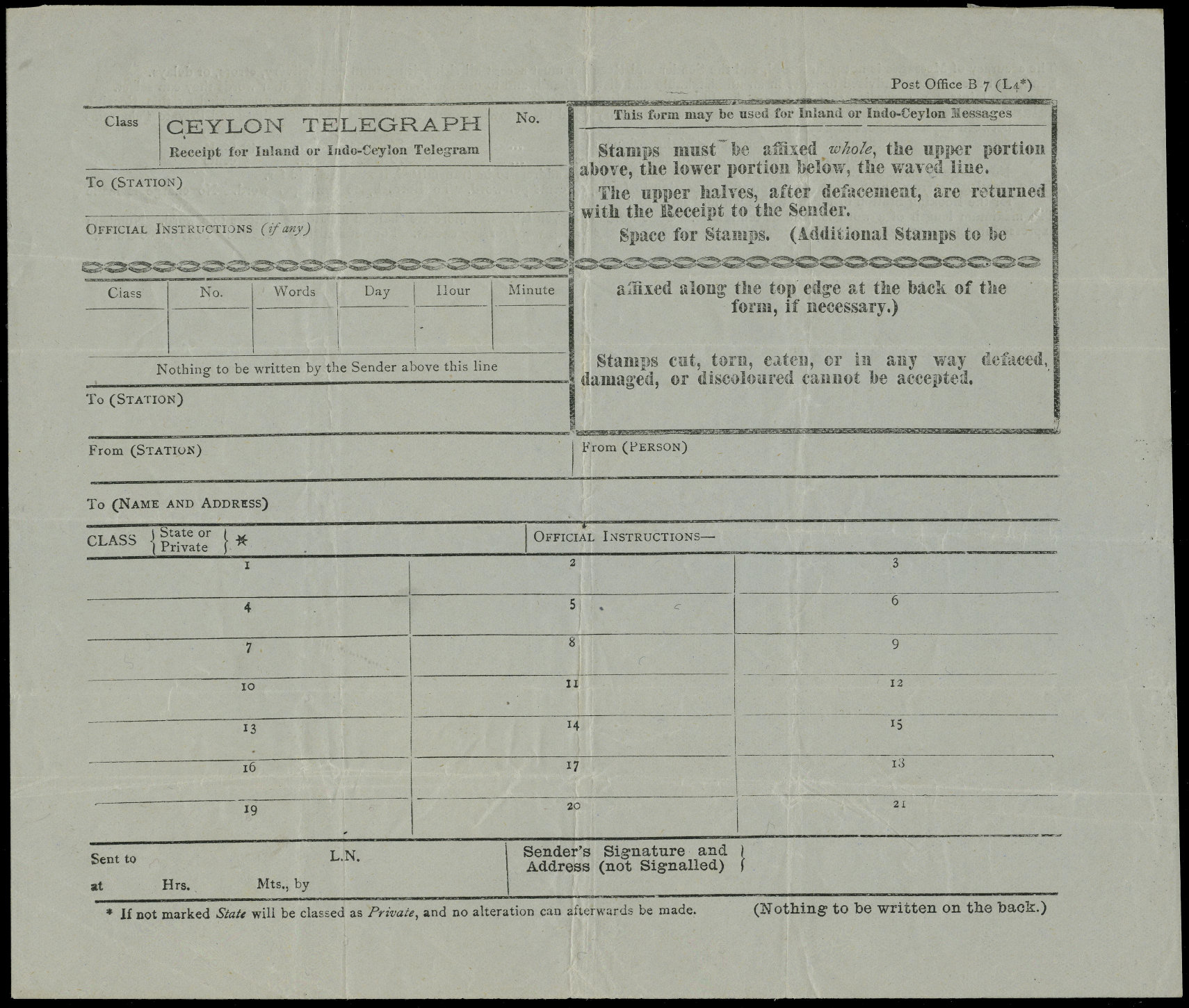
An unused form similar to the last. It has "Post Office B 7 (L4*) . " at top-right, nothing at top-left, and space for 21 words.
From lot 390 of the Taprobana Collection Auction). Image courtesy of Stanley Gibbons.
Unused, Ceylon Telegraph - for Inland or India. Emblem implies 1954 or later, imprint suggests August 1957. MyRef: Cey_B127-57
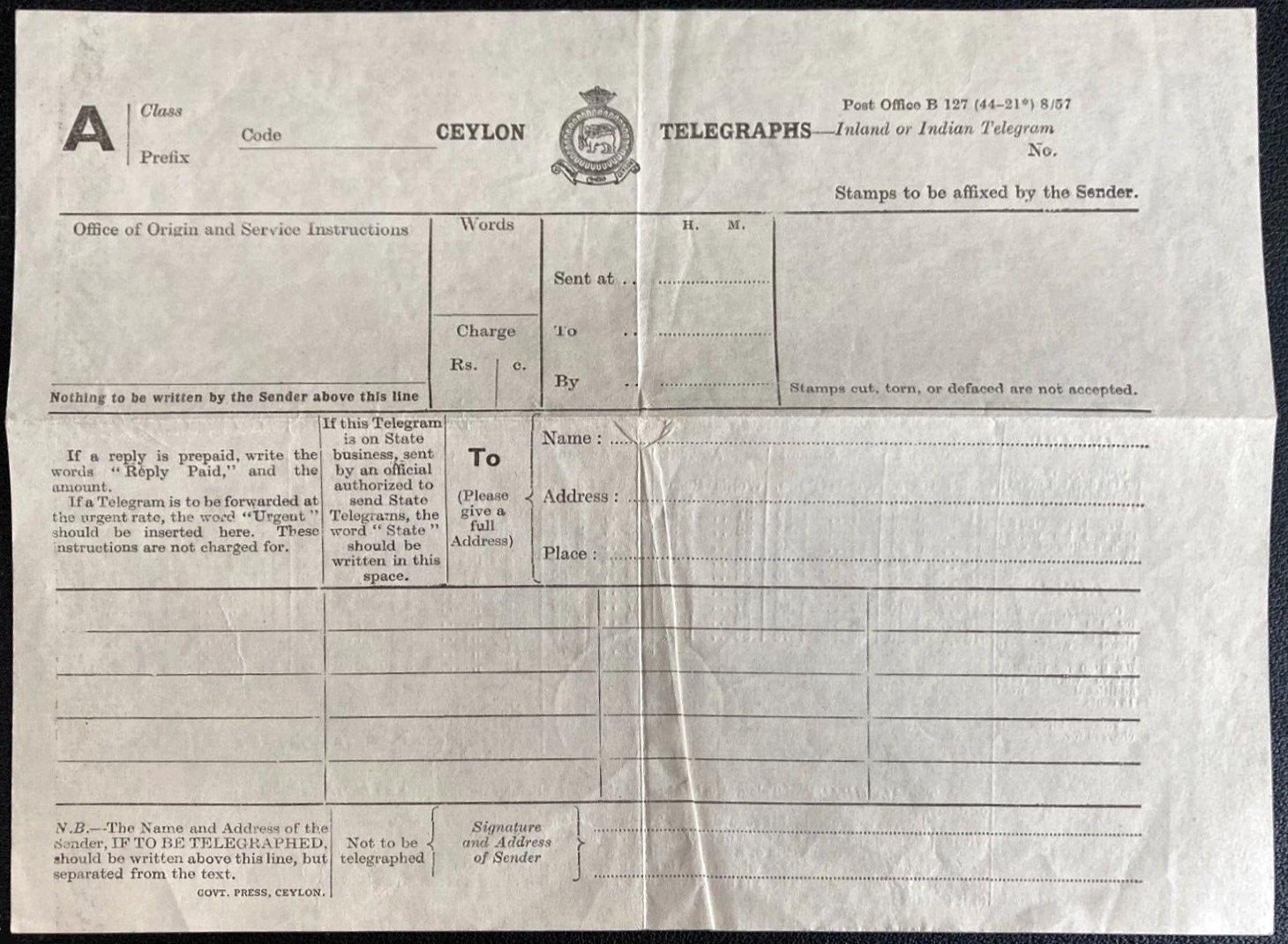
The bottom-left says "GOVT. PRESS, CEYLON.". There is an imprint at top-right that suggests a printing of August 1957.

Image courtesy of mr.mouse2022 on eBay (click image for listing).
Delivery Forms.
Ceylon Post Office Telegraph. MyRef: Cey_B3X8
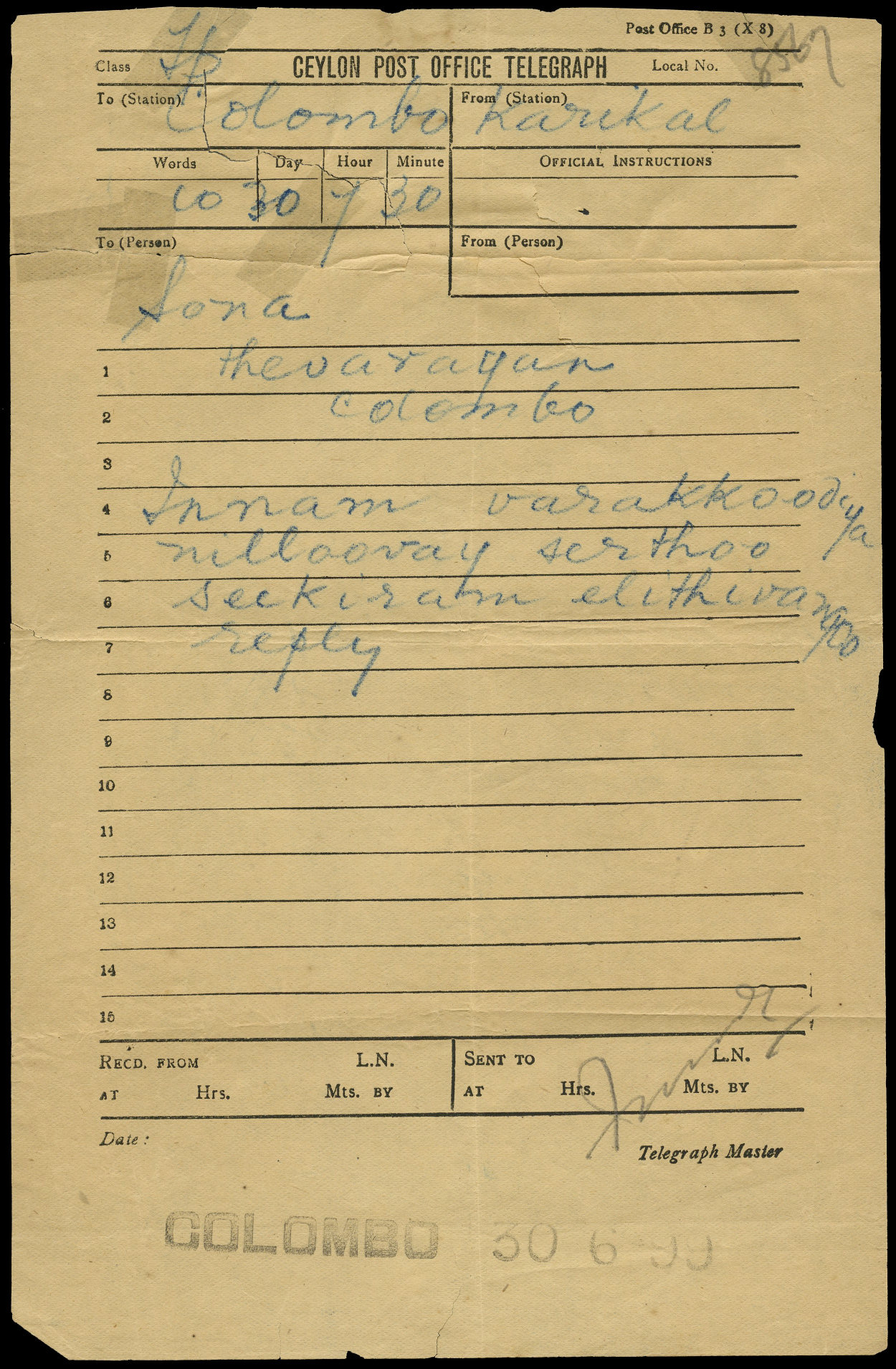
This form was used in Colombo 30 June 1899. It has "Post Office B 3 (X 8)" at top-right.
From lot 392 of the Taprobana Collection Auction). Image courtesy of Stanley Gibbons.
Ceylon Post Office Telegraphs. MyRef: Cey_B3X8_1905
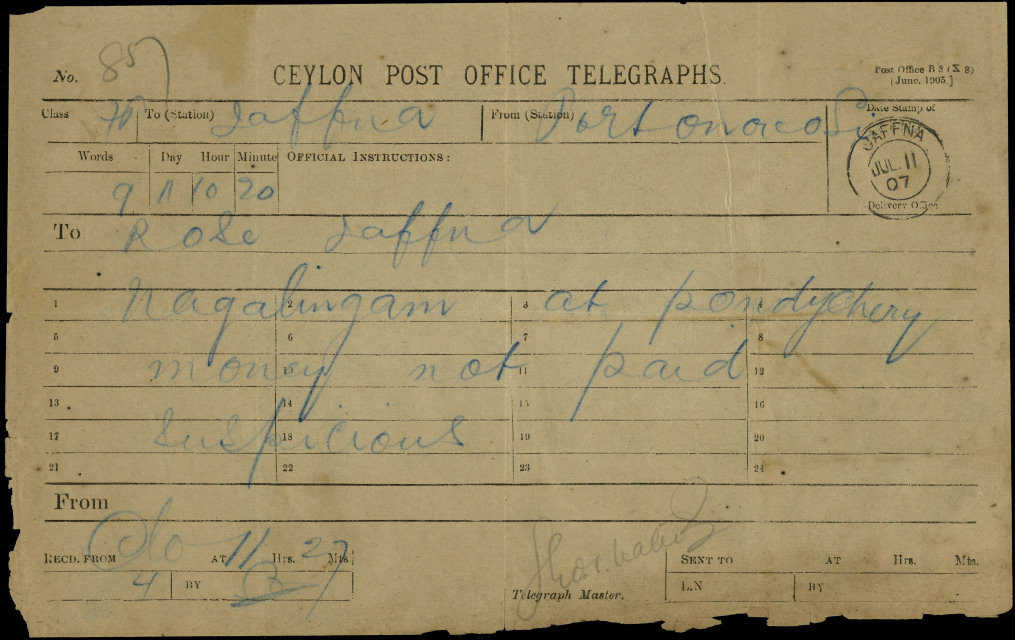
Similar to the last, but now with space for a date-stamp. It was used in Jaffna on 11 July 1907. It has "Post Office B 3 (X 8) / [June, 1905.] " at top-right.
From lot 391 of the Taprobana Collection Auction). Image courtesy of Stanley Gibbons.
Envelopes.
Department of Posts & Telecommunications Envelope.
This is presumably quite modern, but date unknown.
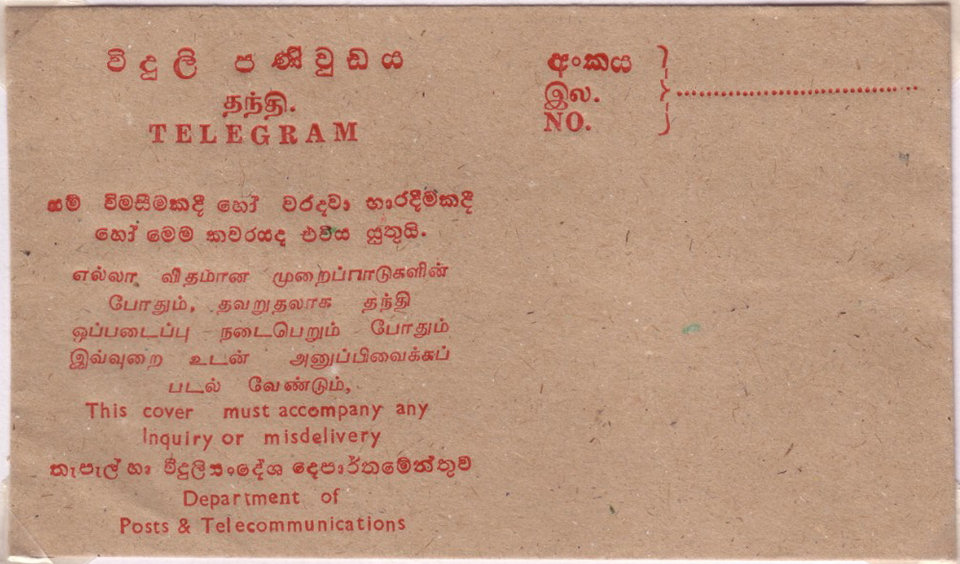
Image courtesy of Rolf Lamprecht.
